- New QB365-SLMS
- 12th Standard Materials
- 11th Standard Materials
- 10th Standard Materials
- 9th Standard Materials
- 8th Standard Materials
- 7th Standard Materials
- 6th Standard Materials
- 12th Standard CBSE Materials
- 11th Standard CBSE Materials
- 10th Standard CBSE Materials
- 9th Standard CBSE Materials
- 8th Standard CBSE Materials
- 7th Standard CBSE Materials
- 6th Standard CBSE Materials
- Tamilnadu Stateboard
- Scholarship Exams
- Scholarships


Class 11th Physics - Units and Measurements Case Study Questions and Answers 2022 - 2023
By QB365 on 08 Sep, 2022
QB365 provides a detailed and simple solution for every Possible Case Study Questions in Class 11 Physics Subject - Units and Measurements, CBSE. It will help Students to get more practice questions, Students can Practice these question papers in addition to score best marks.
QB365 - Question Bank Software
Units and measurements case study questions with answer key.
11th Standard CBSE
Final Semester - June 2015
The dimensional method is a very convenient way of finding the dependence of physical quantity on other physical quantities of a given system. This method has its own limitations. In a complicated situation, it is often not easy to guess the factors on which a Physical quantity will depend. Secondly, this method gives no information about the dimensionless proportionality constant. Thirdly this method is used only if a Physical quantity depends on the product of other physical quantities. Fourthly this method will not work if a physical quantity depends on another quantity being a trignometric or exponential function. Finally this method does not give complete information in cases where a Physical quantity depends on more than three quantities in problems in mechanics. (i) What are Physical quantity? Write their types. (ii) What are dimensional formula of a physical quantity? (iii) Which principle does the method of dimensional analysis use? (iv) What is principle of homogeneity? (v) Write two limitations of dimensional analysis. (vi) Write one use of dimensional analysis.
In the study of Physics, we often have to measure the physical quantities. The numerical value of a measured quantity can only be approximate as it depends upon the least count of the measuring instrument used. The number of significant figures in any measurement indicates the degree of precision of that measurement. The importance of significant figures lies in calculation. A mathematical calculation cannot increase the precision of a physical measurement. Therefore, the number of significant figures in the sum or product of a group of numbers cannot be greater than the number that has the least number of significant figures because a chain cannot be stronger than its weakest link. The difference in the true value and the measured value of a quantity is the measure of error in measurement. (i) What are significant figures? (ii) Define least count (iii) Is there any relation between precision and accuracy? (iv) State the relationship between significant figures and precision. (v) Determine the maximum error in the addition of two physical quantities. (vi) How Systematic errors can be minimised?
To measure distance or length between two points, various methods are adopted which are categorised as direct and indirect methods. Direct methods are used to measure shorter but accessible distances while indirect methods are used for inaccessible distance. Large distances, such as the distance of a planet or star from earth can be measured by the Parallax method. Parallax is the change in position of an object with respect to fixed background when object is seen from two different positions. Parallex method is used for measuring distances of stars which are less than 100 light years away. (i) Name the instruments that are used to measure distance of the order 10 - 5 m. (ii) Define the terms 'basis' and parallactic angle used in Parallax method for measuring distance. (iii) What is the measure of basis in measuring distance of a nearby star by Parallax method? (iv) Why Parallax method is used for measuring distances of nearby stars only? (v) What is meant by angular diameter of moon?
*****************************************
Units and measurements case study questions with answer key answer keys.
(i) Physical quantities are those in terms of which any physical Phenomena is studied. These are of two types; fundamental and derived. (ii) Expression of a physical quantity in terms of powers of fundamental physical quantity is known as dimensional formula (iii) Method of dimensional analysis uses the principle of homogeneity. (iv) According to this the dimensions of both sides of a physical equation must be identical. (v) (i) It gives no information about the dimensionless constant which has to be determined by experiment or by mathematical derivation. (ii) This method will not work if a quantity depends on another quantity which is a trigonometric function. (vi) Conversion of units from one system to another.
(i) In the measured value of physical quantity, the digit about the correctness of which we are sure plus the last digit which is doubtful, are called significant figures. (ii) The smallest value that can be measured by a measuring instrument is called the least count of the instrument. (iii) Precision describes the limitation of the measuring instrument. It is determined by the least count of the measuring instrument. Smaller the least count, greater is the precision. Both accuracy and' precision reflect how close a measurement is to an actual value. Accuracy reflects how close a measurement is to a known or accepted value, while precision reflects how reproducible measurements are, even if they are far from the accepted value. (iv) Larger the number of significant figures in a measurement, greater is the precision of the measurement and vice versa. (v) Maximum absolute error in sum of the two quantities is equal to sum of the absolute errors in the individual quantities. (vi) Systematic errors can be minimised by improving experimental techniques, selecting better instruments and removing personal errors.
(i) A screw gauge and a spherometer are used to measure distances upto 10 -5 m. (ii) Basis - is the distance between two different point of observation while the parallactic angle is the angle between two line of sight against fixed background. (iii) Since diameter of earth's orbit around the sun is the basis, therefore measure of basis is 2 AU. (iv) It is because as the distance of star increases, the Parallax angle decreases that can not be measured accurately. Parallax method is limited to measurement of distance upto 100 light years. (v) Angular diameter of moon is the angle subtended at a point on earth by two diametrically opposite ends of the moon. Its value is 0.5°.
Related 11th Standard CBSE Physics Materials
11th standard cbse syllabus & materials, cbse 11th chemistry structure of atom chapter case study question with answers, cbse 11th chemistry some basic concept of chemistry chapter case study questions with answers, 11th biology biological classification chapter case study question with answers cbse, 11th biology the living world chapter case study question with answers cbse, class 11th business studies - internal trade case study questions and answers 2022 - 2023, class 11th business studies - social responsibilities of business and business ethics case study questions and answers 2022 - 2023, class 11th business studies - emerging modes of business case study questions and answers 2022 - 2023, class 11th business studies - business service case study questions and answers 2022 - 2023, class 11th business studies - private, public and global enterprises case study questions and answers 2022 - 2023, class 11th business studies - business, trade and commerce case study questions and answers 2022 - 2023.

Class 11th Applied Mathematics - Coordinate Geometry Case Study Questions and Answers 2022 - 2023
Class 11th applied mathematics - basics of financial mathematics case study questions and answers 2022 - 2023, class 11th applied mathematics - descriptive statistics case study questions and answers 2022 - 2023, class 11th applied mathematics - probability case study questions and answers 2022 - 2023, class 11th applied mathematics - calculus case study questions and answers 2022 - 2023.

Class VI to XII
Tn state board / cbse, 3000+ q&a's per subject, score high marks.

11th Standard CBSE Study Materials

11th Standard CBSE Subjects

Class 11 Physics Case Study Question
Case study question class 11 physics (cbse / ncert board), cbse class 11 physics case study question, leave a reply cancel reply, we have a strong team of experienced teachers who are here to solve all your exam preparation doubts, up scert solutions class 5 english chapter 11 the sun and the wind, up scert solutions class 5 english chapter 12 alice in the wonderland, dav class 5 math solution chapter 4 fractional numbers, the kites class 6 extra questions and answers.

Class 11 Physics Case Study Questions PDF Download
- Post author: studyrate
- Post published:
- Post category: Physics
- Post comments: 0 Comments
Class 11 Physics Case Study Questions are available here. You can read these Case Study questions by chapter for your final physics exam. Subject matter specialists and seasoned teachers created these quizzes. You can verify the right response to each question by referring to the answer key, which is also provided. To achieve high marks on your Board exams, practice these questions.
Join our Telegram Channel, there you will get various e-books for CBSE 2024 Boards exams for Class 9th, 10th, 11th, and 12th.

We are providing Case Study questions for Class 11 Physics based on the Latest syllabus. There is a total of 14 chapters included in the CBSE Class 11 physics exams. Students can practice these questions for concept clarity and score better marks in their exams.
Table of Contents
Class 11th PHYSICS: Chapterwise Case Study Question & Solution
Case study questions play a crucial role in the Class 11 Physics curriculum. They are designed to assess your understanding of various concepts and principles in real-life scenarios. These questions help you apply theoretical knowledge to practical situations, enhancing your problem-solving skills.
Case Study-Based Questions for Class 11 Physics
- Case Study Based Questions on Class 11 Physics Chapter 2 Units and Measurements
- Case Study Based Questions on Class 11 Physics Chapter 3 Motion in a Straight Line
- Case Study Based Questions on Class 11 Physics Chapter 4 Motion in a Plane
- Case Study Based Questions on Class 11 Physics Chapter 5 Laws of Motion
- Case Study Based Questions on Class 11 Physics Chapter 6 Work, Energy, and Power
- Case Study Based Questions on Class 11 Physics Chapter 7 System of Particles and Rotational Motion
- Case Study Based Questions on Class 11 Physics Chapter 8 Gravitation
- Case Study Based Questions on Class 11 Physics Chapter 9 Mechanical Properties of Solids
- Case Study Based Questions on Class 11 Physics Chapter 10 Mechanical Properties of Fluids
- Case Study Based Questions on Class 11 Physics Chapter 11 Thermal Properties of Matter
- Case Study Based Questions on Class 11 Physics Chapter 12 Thermodynamics
- Case Study Based Questions on Class 11 Physics Chapter 13 Kinetic Theory
- Case Study Based Questions on Class 11 Physics Chapter 14 Waves
- Case Study Based Questions on Class 11 Physics Chapter 15 Oscillations
Class 11 Physics MCQ Questions
Before the exams, students in class 11 should review crucial Physics Case Study issues. They will gain a better understanding of the kinds of Case Study questions that may be offered in Physics exams for Grade 11. These questions were created by our highly qualified faculty for standard 11 Physics based on the questions that appeared most frequently in last year’s exams. The solutions have been written in a way that will make them simple to grasp and will aid students in grade 11 in understanding the topics.
Class 11 Books for Boards

Class 11 Physics Syllabus 2024
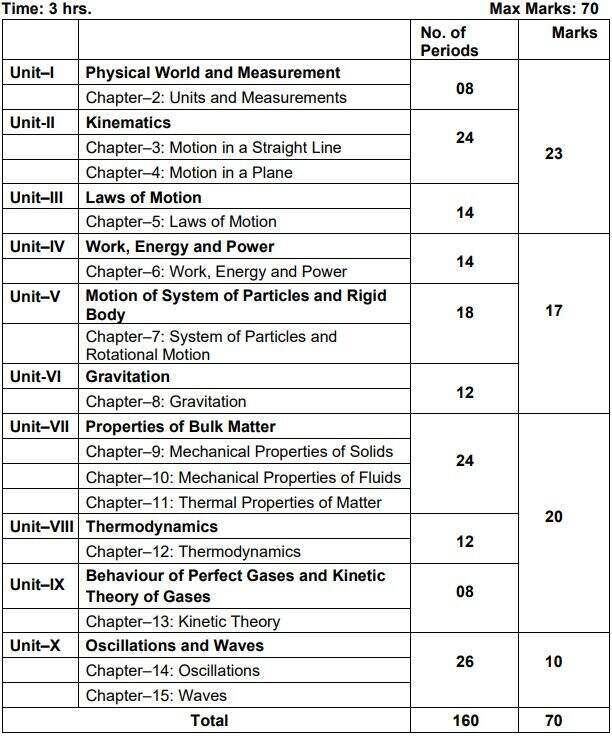
Unit I: Physical World and Measurement 08 Periods
Chapter–2: Units and Measurements
Need for measurement: Units of measurement; systems of units; SI units, fundamental and derived units. significant figures. Dimensions of physical quantities, dimensional analysis and its applications.
Unit II: Kinematics 24 Periods
Chapter–3: Motion in a Straight Line
The frame of reference, Motion in a straight line, Elementary concepts of differentiation and integration for describing motion, uniform and non-uniform motion, and instantaneous velocity, uniformly accelerated motion, velocity-time and position-time graphs. Relations for uniformly accelerated motion (graphical treatment).
Chapter–4: Motion in a Plane
Scalar and vector quantities; position and displacement vectors, general vectors and their notations; equality of vectors, multiplication of vectors by a real number; addition and subtraction of vectors, Unit vector; resolution of a vector in a plane, rectangular components, Scalar and Vector product of vectors. Motion in a plane, cases of uniform velocity and uniform acceleration projectile motion, uniform circular motion.
Unit III: Laws of Motion 14 Periods
Chapter–5: Laws of Motion
Intuitive concept of force, Inertia, Newton’s first law of motion; momentum and Newton’s second law of motion; impulse; Newton’s third law of motion. Law of conservation of linear momentum and its applications. Equilibrium of concurrent forces, Static and kinetic friction, laws of friction, rolling friction, lubrication.
Dynamics of uniform circular motion: Centripetal force, examples of circular motion (vehicle on a level circular road, vehicle on a banked road).
Unit IV: Work, Energy and Power 14 Periods
Chapter–6: Work, Energy and Power
Work done by a constant force and a variable force; kinetic energy, workenergy theorem, power. Notion of potential energy, potential energy of a spring, conservative forces: non- conservative forces, motion in a vertical circle; elastic and inelastic collisions in one and two dimensions.
Unit V: Motion of System of Particles and Rigid Body 18 Periods
Chapter–7: System of Particles and Rotational Motion
Centre of mass of a two-particle system, momentum conservation and Centre of mass motion. Centre of mass of a rigid body; centre of mass of a uniform rod. Moment of a force, torque, angular momentum, law of conservation of angular momentum and its applications. Equilibrium of rigid bodies, rigid body rotation and equations of rotational motion, comparison of linear and rotational motions. Moment of inertia, radius of gyration, values of moments of inertia for simple geometrical objects (no derivation).
Unit VI: Gravitation 12 Periods
Chapter–8: Gravitation
Kepler’s laws of planetary motion, universal law of gravitation. Acceleration due to gravity and its variation with altitude and depth. Gravitational potential energy and gravitational potential, escape velocity, orbital velocity of a satellite.
Unit VII: Properties of Bulk Matter 24 Periods
Chapter–9: Mechanical Properties of Solids
Elasticity, Stress-strain relationship, Hooke’s law, Young’s modulus, bulk modulus, shear modulus of rigidity (qualitative idea only), Poisson’s ratio; elastic energy.
Chapter–10: Mechanical Properties of Fluids
Pressure due to a fluid column; Pascal’s law and its applications (hydraulic lift and hydraulic brakes), effect of gravity on fluid pressure. Viscosity, Stokes’ law, terminal velocity, streamline and turbulent flow, critical velocity, Bernoulli’s theorem and its simple applications. Surface energy and surface tension, angle of contact, excess of pressure across a curved surface, application of surface tension ideas to drops, bubbles and capillary rise.
Chapter–11: Thermal Properties of Matter
Heat, temperature, thermal expansion; thermal expansion of solids, liquids and gases, anomalous expansion of water; specific heat capacity; Cp, Cv – calorimetry; change of state – latent heat capacity. Heat transfer-conduction, convection and radiation, thermal conductivity, qualitative ideas of Blackbody radiation, Wein’s displacement Law, Stefan’s law .
Unit VIII: Thermodynamics 12 Periods
Chapter–12: Thermodynamics
Thermal equilibrium and definition of temperature zeroth law of thermodynamics, heat, work and internal energy. First law of thermodynamics, Second law of thermodynamics: gaseous state of matter, change of condition of gaseous state -isothermal, adiabatic, reversible, irreversible, and cyclic processes.
Unit IX: Behavior of Perfect Gases and Kinetic Theory of Gases 08 Periods
Chapter–13: Kinetic Theory
Equation of state of a perfect gas, work done in compressing a gas. Kinetic theory of gases – assumptions, concept of pressure. Kinetic interpretation of temperature; rms speed of gas molecules; degrees of freedom, law of equi-partition of energy (statement only) and application to specific heat capacities of gases; concept of mean free path, Avogadro’s number.
Unit X: Oscillations and Waves 26 Periods
Chapter–14: Oscillations
Periodic motion – time period, frequency, displacement as a function of time, periodic functions and their application. Simple harmonic motion (S.H.M) and its equations of motion; phase; oscillations of a loaded spring- restoring force and force constant; energy in S.H.M. Kinetic and potential energies; simple pendulum derivation of expression for its time period.
Chapter–15: Waves
Wave motion: Transverse and longitudinal waves, speed of traveling wave, displacement relation for a progressive wave, principle of superposition of waves, reflection of waves, standing waves in strings and organ pipes, fundamental mode and harmonics, Beats.
FAQs about Class 11 Physics Case Studies
What is the best website for a case study of physics class 11 .
studyrate.in is the best website for Class 11 Physics Case Study Questions for Board Exams. Here you can find various types of Study Materials, Ebooks, Notes, and much more free of cost.
How do you write a case study question for Class 11?
The CBSE will ask two Case Study Questions in the CBSE Class 11th Maths Question Paper. Question numbers 15 and 16 will be case-based questions where 5 MCQs will be asked based on a paragraph.
Are the case study questions based on the latest syllabus?
Yes, the case study questions are curated to align with the latest Class 11 Physics syllabus.

You Might Also Like
50+ neet mcq questions waves with solutions, 50+ jee mains mcq questions work energy and power with solutions, 50+ jee mains mcq questions oscillations with solutions, leave a reply cancel reply.
Save my name, email, and website in this browser for the next time I comment.
This site uses Akismet to reduce spam. Learn how your comment data is processed .

The Topper Combo Flashcards
- Contains the Latest NCERT in just 350 flashcards.
- Colourful and Interactive
- Summarised Important reactions according to the latest PYQs of NEET(UG) and JEE
No thanks, I’m not interested!
myCBSEguide
- Class 11 Physics Case...
Class 11 Physics Case Study Questions
Table of Contents
myCBSEguide App
Download the app to get CBSE Sample Papers 2023-24, NCERT Solutions (Revised), Most Important Questions, Previous Year Question Bank, Mock Tests, and Detailed Notes.
Looking for complete and comprehensive case study questions for class 11 Physics? myCBSEguide is just a click away! With extensive study materials, sample papers, case study questions and mock tests, myCBSEguide is your one-stop solution for class 11 Physics exam preparation needs. So, what are you waiting for? Log on to myCBSEguide and get started today!
What is the purpose of physics?
Physics is the study of the fundamental principles governing the natural world. It is a vital part of the scientific enterprise, providing the foundation on which other sciences are built. Physics is essential for understanding how the world works, from the smallest particles to the largest structures in the Universe. In class 11 Physics, students are introduced to the basic concepts of physics and learn about the fundamental principles governing the natural world. Class 11 Physics concepts are essential for understanding the world around us and for further study in physics and other sciences.
What are case study questions in physics?
In physics, case study questions are intended to evaluate a student’s ability to apply theoretical principles to real-life situations. These questions usually ask the student to assess data from a specific experiment or setting in order to discover what physical principles are at play. Problem-solving and critical-thinking skills are developed through case study questions, which are an important aspect of physics education.
CBSE Case Study Questions in Class 11 Physics
CBSE Class 11 Physics question paper pattern includes case study questions. Class 11 Physics case study questions assess a student’s ability to apply physics principles to real-world environments. The questions are usually focused on a situation provided in the Class 11 Physics question paper, and they demand the student to answer the problem using their physics knowledge. Class 11 Physics case study questions are an important aspect of the CBSE physics curriculum. Class 11 Physics case study questions are a useful way to assess a student’s expertise in the subject.
Sample Class 11 Physics Case Study Questions
Expert educators at myCBSEguide have created a collection of Class 11 physics case study questions. The samples of Class 11 physics case study questions are given below. Class 11 physics case study questions are designed to test your understanding of the concepts and principles of physics. They are not meant to be easy, but they should be done if you have a good grasp of the subject. So, take a look at the questions and see how you fare. Good luck!
Class 11 Physics Case Study Question 1
Read the case study given below and answer any four subparts: Potential energy is the energy stored within an object, due to the object’s position, arrangement or state. Potential energy is one of the two main forms of energy, along with kinetic energy. Potential energy depends on the force acting on the two objects.
- kinetic energy
- potential energy
- mechanical energy
- none of these
- potential energy decreases
- potential energy increases
- kinetic energy decreases
- kinetic energy increases
- only when spring is stretched
- only when spring is compressed
- both a and b
- 5 × 10 4 J
- 5 × 10 5 J
Answer Key:
Class 11 Physics Case Study Question 2
- distance between body
- source of heat
- all of the above
- convection and radiation
- (b) convection
- (d) all of the above
- (a) convection
- (a) increase
- (c) radiation
Class 11 Physics Case Study Question 3
- internal energy.
- 1 +(T 2 /T 1 )
- (T 1 /T 2 )+1
- (T 1 /T 2 )- 1
- 1 – (T 2 / T 1 )
- increase or decrease depending upon temperature ratio
- first increase and then decrease
- (d) 1- (T 2 / T 1 )
- (b) increase
- (c) constant
Class 11 Physics Case Study Question 4
- It is far away from the surface of the earth
- Its surface temperature is 10°C
- The r.m.s. velocity of all the gas molecules is more than the escape velocity of the moon’s surface
- The escape velocity of the moon’s surface is more than the r.m.s velocity of all molecules
- T(H 2 ) = T(N 2 )
- T(H 2 ) < T(N 2 )
- T(H 2 ) > T(N 2 )
The given samples of Class 11 Physics case study questions will help Class 11 Physics students to get an idea on how to solve it. These Class 11 Physics case study questions are based on the topics covered in the Class 11 Physics syllabus and are designed to test the student’s conceptual understanding. The questions are of varying difficulty levels and cover a wide range of topics. By solving these Class 11 Physics case study questions, students will be able to develop their problem-solving skills and improve their understanding of the concepts.
Examining Class 11 Physics syllabus
Senior Secondary school education is a transitional step from general education to a discipline-based curriculum concentration. The current curriculum of Class 11 Physics takes into account the rigour and complexity of the disciplinary approach, as well as the learners’ comprehension level. Class 11 Physics syllabus has also been carefully crafted to be similar to international norms.
The following are some of the Class 11 Physics syllabus’s most notable features:
- Emphasis is placed on gaining a fundamental conceptual knowledge of the material.
- Use of SI units, symbols, naming of physical quantities, and formulations in accordance with international standards are emphasised.
- For enhanced learning, provide logical sequencing of subject matter units and suitable placement of concepts with their links.
- Eliminating overlapping concepts/content within the field and between disciplines to reduce the curricular load.
- Process skills, problem-solving ability, and the application of Physics principles are all encouraged.
CBSE Class 11 Physics (Code No. 042)
| Chapter–2: Units and Measurements | |||
| Chapter–3: Motion in a Straight Line | |||
| Chapter–4: Motion in a Plane | |||
| Chapter–5: Laws of Motion | |||
| Chapter–6: Work, Energy and Power | |||
| Chapter–7: System of Particles and Rotational Motion | |||
| Chapter–8: Gravitation | |||
| Chapter–9: Mechanical Properties of Solids | |||
| Chapter–10: Mechanical Properties of Fluids | |||
| Chapter–11: Thermal Properties of Matter | |||
| Chapter–12: Thermodynamics | |||
| Chapter–13: Kinetic Theory | |||
| Chapter–14: Oscillations | |||
| Chapter–15: Waves | |||
myCBSEguide: A true saviour for many students
myCBSEguide has been a true saviour for many students who struggle to find resources elsewhere. It is a reliable source of information and provides students with everything they need to excel in their academics. myCBSEguide has helped many students score high marks in their exams and has been a valuable resource for their studies. Teachers recommend myCBSEguide to all CBSE students. And best of all, it’s available 24/7, so you can study at your own pace, anytime, anywhere. So why wait? Get started today and see the difference myCBSEguide can make to your studies.
Test Generator
Create question paper PDF and online tests with your own name & logo in minutes.
Question Bank, Mock Tests, Exam Papers, NCERT Solutions, Sample Papers, Notes
Related Posts
- Competency Based Learning in CBSE Schools
- Class 11 Physical Education Case Study Questions
- Class 11 Sociology Case Study Questions
- Class 12 Applied Mathematics Case Study Questions
- Class 11 Applied Mathematics Case Study Questions
- Class 11 Mathematics Case Study Questions
- Class 11 Biology Case Study Questions
- Class 12 Physical Education Case Study Questions
Leave a Comment
Save my name, email, and website in this browser for the next time I comment.
CBSE Class 11 Physics Chapter 2 Units and Measurements Study Materials
NCERT Solutions Class 11 All Subjects Sample Papers Past Years Papers
Units and Measurement : Notes and Study Materials -pdf
- Concepts of Units and Measurement
- Units and Measurement Master File
- Units and Measurement Revision Notes
- Units and Measurement MindMap
- NCERT Solution Units and Measurement
- Units and Measurement : Solved Example 1
Class 11 Physics Chapter 2 Units and Measurements
Topics and Subtopics in Class 11 Physics Chapter 2 Units and Measurements :
| 2 | Units and Measurements |
| 2.1 | Introduction |
| 2.2 | The international system of units |
| 2.3 | Measurement of length |
| 2.4 | Measurement of mass |
| 2.5 | Measurement of time |
| 2.6 | Accuracy, precision of instruments and errors in measurement |
| 2.7 | Significant figures |
| 2.8 | Dimensions of physical quantities |
| 2.9 | Dimensional formulae and dimensional equations |
| 2.10 | Dimensional analysis and its applications |
Units and Measurement Class 11 Notes Physics Chapter 2
- Measurement The process of measurement is basically a comparison process. To measure a physical quantity, we have to find out how many times a standard amount of that physical quantity is present in the quantity being measured. The number thus obtained is known as the magnitude and the standard chosen is called the unit of the physical quantity.
- Unit The unit of a physical quantity is an arbitrarily chosen standard which is widely accepted by the society and in terms of which other quantities of similar nature may be measured.
- Standard The actual physical embodiment of the unit of a physical quantity is known as a standard of that physical quantity. • To express any measurement made we need the numerical value (n) and the unit (μ). Measurement of physical quantity = Numerical value x Unit For example: Length of a rod = 8 m where 8 is numerical value and m (metre) is unit of length.
- Fundamental Physical Quantity/Units It is an elementary physical quantity, which does not require any other physical quantity to express it. It means it cannot be resolved further in terms of any other physical quantity. It is also known as basic physical quantity. The units of fundamental physical quantities are called fundamental units. For example, in M. K. S. system, Mass, Length and Time expressed in kilogram, metre and second respectively are fundamental units.
- Derived Physical Quantity/Units All those physical quantities, which can be derived from the combination of two or more fundamental quantities or can be expressed in terms of basic physical quantities, are called derived physical quantities. The units of all other physical quantities, which car. be obtained from fundamental units, are called derived units. For example, units of velocity, density and force are m/s, kg/m3, kg m/s2 respectively and they are examples of derived units.
- Systems of Units Earlier three different units systems were used in different countries. These were CGS, FPS and MKS systems. Now-a-days internationally SI system of units is followed. In SI unit system, seven quantities are taken as the base quantities. (i) CGS System. Centimetre, Gram and Second are used to express length, mass and time respectively. (ii) FPS System. Foot, pound and second are used to express length, mass and time respectively. (iii) MKS System. Length is expressed in metre, mass is expressed in kilogram and time is expressed in second. Metre, kilogram and second are used to express length, mass and time respectively. (iv) SI Units. Length, mass, time, electric current, thermodynamic temperature, Amount of substance and luminous intensity are expressed in metre, kilogram, second, ampere, kelvin, mole and candela respectively.
- Definitions of Fundamental Units
- Supplementary Units Besides the above mentioned seven units,there are two supplementary base units. these are (i) radian (rad) for angle, and (ii) steradian (sr) for solid angle.
(i) It is internationally accepted, (ii) It is a rational unit system, (iii) It is a coherent unit system, (iv) It is a metric system, (v) It is closely related to CGS and MKS systems of units, (vi) Uses decimal system, hence is more user friendly.
- Other Important Units of Length For measuring large distances e.g., distances of planets and stars etc., some bigger units of length such as ‘astronomical unit’, ‘light year’, parsec’ etc. are used. • The average separation between the Earth and the sun is called one astronomical unit. 1 AU = 1.496 x 10 11 m. • The distance travelled by light in vacuum in one year is called light year. 1 light year = 9.46 x 10 15 m. • The distance at which an arc of length of one astronomical unit subtends an angle of one second at a point is called parsec. 1 parsec = 3.08 x 10 16 m • Size of a tiny nucleus = 1 fermi = If = 10 -15 m • Size of a tiny atom = 1 angstrom = 1A = 10 -10 m
- Parallax Method This method is used to measure the distance of planets and stars from earth. Parallax. Hold a pen in front of your eyes and look at the pen by closing the right eye and ‘ then the left eye. What do you observe? The position of the pen changes with respect to the background. This relative shift in the position of the pen (object) w.r.t. background is called parallax. If a distant object e.g., a planet or a star subtends parallax angle 0 on an arc of radius b (known as basis) on Earth, then distance of that distant object from the basis is given by • To estimate size of atoms we can use electron microscope and tunneling microscopy technique. Rutherford’s a-particle scattering experiment enables us to estimate size of nuclei of different elements. • Pendulum clocks, mechanical watches (in which vibrations of a balance wheel are used) and quartz watches are commonly used to measure time. Cesium atomic clocks can be used to measure time with an accuracy of 1 part in 10 13 (or to a maximum discrepancy of 3 ps in a year). • The SI unit of mass is kilogram. While dealing with atoms/ molecules and subatomic particles we define a unit known as “unified atomic mass unit” (1 u), where 1 u = 1.66 x 10 -27 kg.
After that some lycopodium powder is lightly sprinkled on the surface of water in a large trough and one drop of this solution is put in water. The oleic acid drop spreads into a thin, large and roughly circular film of molecular thickness on water surface. Then, the diameter of the thin film is quickly measured to get its area A. Suppose n drops were put in the water. Initially, the approximate volume of each drop is determined (V cm 3 ). Volume of n drops of solution = nV cm 3 Amount of oleic acid in this solution
The solution of oleic acid spreads very fast on the surface of water and forms a very thin layer of thickness t. If this spreads to form a film of area A cm 2 , then thickness of the film
If we assume that the film has mono-molecular thickness, this becomes the size or diameter of a molecule of oleic acid. The value of this thickness comes out to be of the order of 10 -9 m.
- Dimensions The dimensions of a physical quantity are the powers to which the fundamental units of mass, length and time must be raised to represent the given physical quantity.
- Dimensional Formula The dimensional formula of a physical quantity is an expression telling us how and which of the fundamental quantities enter into the unit of that quantity. It is customary to express the fundamental quantities by a capital letter, e.g., length (L), mass (AT), time (T), electric current (I), temperature (K) and luminous intensity (C). We write appropriate powers of these capital letters within square brackets to get the dimensional formula of any given physical quantity.
- Applications of Dimensions The concept of dimensions and dimensional formulae are put to the following uses: (i) Checking the results obtained (ii) Conversion from one system of units to another (iii) Deriving relationships between physical quantities (iv) Scaling and studying of models. The underlying principle for these uses is the principle of homogeneity of dimensions. According to this principle, the ‘net’ dimensions of the various physical quantities on both sides of a permissible physical relation must be the same; also only dimensionally similar quantities can be added to or subtracted from each other.
- Limitations of Dimensional Analysis The method of dimensions has the following limitations: (i) by this method the value of dimensionless constant cannot be calculated. (ii) by this method the equation containing trigonometric, exponential and logarithmic terms cannot be analyzed. (iii) if a physical quantity in mechanics depends on more than three factors, then relation among them cannot be established because we can have only three equations by equalizing the powers of M, L and T. (iv) it doesn’t tell whether the quantity is vector or scalar.
- Significant Figures The significant figures are a measure of accuracy of a particular measurement of a physical quantity. Significant figures in a measurement are those digits in a physical quantity that are known reliably plus the first digit which is uncertain.
- The Rules for Determining the Number of Significant Figures (i) All non-zero digits are significant. (ii) All zeroes between non-zero digits are significant. (iii) All zeroes to the right of the last non-zero digit are not significant in numbers without decimal point. (iv) All zeroes to the right of a decimal point and to the left of a non-zero digit are not significant. (v) All zeroes to the right of a decimal point and to the right of a non-zero digit are significant. (vi) In addition and subtraction, we should retain the least decimal place among the values operated, in the result. (vii) In multiplication and division, we should express the result with the least number of significant figures as associated with the least precise number in operation. (viii) If scientific notation is not used: (a) For a number greater than 1, without any decimal, the trailing zeroes are not significant. (b) For a number with a decimal, the trailing zeros are significant.
- Error The measured value of the physical quantity is usually different from its true value. The result of every measurement by any measuring instrument is an approximate number, which contains some uncertainty. This uncertainty is called error. Every calculated quantity, which is based on measured values, also has an error.
- Causes of Errors in Measurement Following are the causes of errors in measurement: Least Count Error. The least count error is the error associated with the resolution of the instrument. Least count may not be sufficiently small. The maximum possible error is equal to the least count. Instrumental Error . This is due to faulty calibration or change in conditions (e.g., thermal expansion of a measuring scale). An instrument may also have a zero error. A correction has to be applied. Random Error. This is also called chance error. It makes to give different results for same measurements taken repeatedly. These errors are assumed to follow the Gaussian law of normal distribution. Accidental Error. This error gives too high or too low results. Measurements involving this error are not included in calculations. Systematic Error. The systematic errors are those errors that tend to be in one direction, either positive or negative. Errors due to air buoyancy in weighing and radiation loss in calorimetry are systematic errors. They can be eliminated by manipulation. Some of the sources of systematic errors are: (i) intrumental error (ii) imperfection in experimental technique or procedure (iii) personal errors
- Absolute Error, Relative Error and Percentage Error
- Combination of Errors
- IMPORTANT TABLES
NCERT Solutions for Class 6, 7, 8, 9, 10, 11 and 12
NCERT Solutions for Class 11 Physics Chapter 2 Units and Measurements
NCERT Solutions for Class 11 Physics Chapter 2 Units and Measurements are part of Class 11 Physics NCERT Solutions . Here we have given NCERT Solutions for Class 11 Physics Chapter 2 Units and Measurements.
Topics and Subtopics in NCERT Solutions for Class 11 Physics Chapter 2 Units and Measurements :
| 2 | Units and Measurements |
| 2.1 | Introduction |
| 2.2 | The international system of units |
| 2.3 | Measurement of length |
| 2.4 | Measurement of mass |
| 2.5 | Measurement of time |
| 2.6 | Accuracy, precision of instruments and errors in measurement |
| 2.7 | Significant figures |
| 2.8 | Dimensions of physical quantities |
| 2.9 | Dimensional formulae and dimensional equations |
| 2.10 | Dimensional analysis and its applications |
NCERT Solutions Class 11 Physics Physics Sample Papers
QUESTIONS FROM TEXTBOOK
Question 2. 1. Fill in the blanks (a) The volume of a cube of side 1 cm is equal to…………m 3 . (b) The surface area of a solid cylinder of radius 2.0 cm and height 10.0 cm is equal to ……..(mm) 2 . (c) A vehicle moving with a speed of 18 km h -1 covers ………. m in 1 s. (d) The relative density of lead is 11.3. Its density is …….. g cm -3 or ………. kg m -3 . Answer: (a) Volume of cube, V = (1 cm) 3 = (10 -2 m) 3 10 -6 m 3 . Hence, answer is 10 -6 (b) Surface area = 2πrh + 2πr 2 = 2πr (h + r) = 2 x 22/7 x 2 x 10 (10 x 10 + 2 x 10) mm 2 = 1.5 x 10 4 mm 2 Hence, answer is 1.5 x 10 4 . (c) Speed of vehicle = 18 km/h = 18 x 1000/3600 m/s = 5 m/s ; so the vehicle covers 5 m in 1 s. = 11.3 (d) Density= 11.3 g cm -3 =11.3 x 10 3 kg m -3 [1 kg =10 3 g,1m=10 2 cm] =11.3 x 10 3 kg m -4
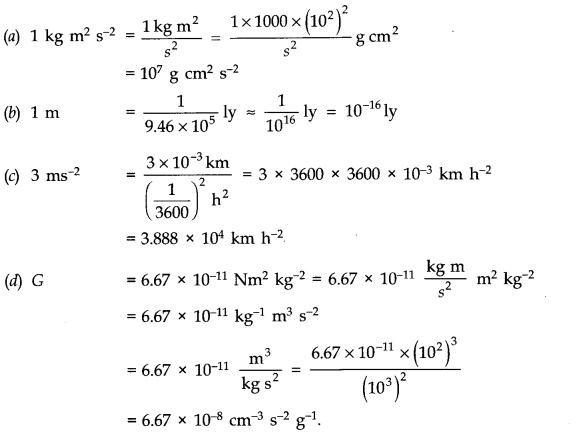
More Resources for CBSE Class 11
NCERT Solutions
- NCERT Solutions Class 11 Maths
- NCERT Solutions Class 11 Physics
- NCERT Solutions Class 11 Chemistry
- NCERT Solutions Class 11 Biology
- NCERT Solutions Class 11 Hindi
- NCERT Solutions Class 11 English
- NCERT Solutions Class 11 Business Studies
- NCERT Solutions Class 11 Accountancy
- NCERT Solutions Class 11 Psychology
- NCERT Solutions Class 11 Entrepreneurship
- NCERT Solutions Class 11 Indian Economic Development
- NCERT Solutions Class 11 Computer Science
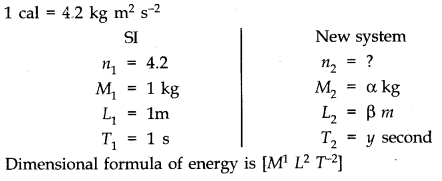
Question 2. 4. Explain this statement clearly: “To call a dimensional quantity ‘large’ or ‘small’ is meaningless without specifying a standard for comparison”. In view of this, reframe the following statements wherever necessary: (a) atoms are very small objects (b) a jet plane moves with great speed (c) the mass of Jupiter is very large (d) the air inside this room contains a large number of molecules (e) a proton is much more massive than an electron (f) the speed of sound is much smaller than the speed of light. Answer: Physical quantities are called large or small depending on the unit (standard) of measurement. For example, the distance between two cities on earth is measured in kilometres but the distance between stars or inter —galactic distances are measured in parsec. The later standard parsec is equal to 3.08 x 10 16 m or 3.08 x 10 12 km is certainly larger than metre or kilometre. Therefore, the inter-stellar or intergalactic distances are certainly larger than the distances between two cities on earth. (a) The size of an atom is much smaller than even the sharp tip of a pin. (b) A Jet plane moves with a speed greater than that of a super fast train. (c) The mass of Jupiter is very large compared to that of the earth. (d) The air inside this room contains more number of molecules than in one mole of air. (e) This is a correct statement. (f) This is a correct statement.
Question 2. 5. A new unit of length is chosen such that the speed of light in vacuum is unity. What is the distance between the Sun and the Earth in terms of the new unit if light takes 8 min and 20 s to cover this distance? Answer: Distance between Sun and Earth = Speed of light in vacuum x time taken by light to travel from Sim to Earth = 3 x 10 8 m/ s x 8 min 20 s = 3 x 10 8 m/s x 500 s = 500 x 3 x 10 8 m. In the new system, the speed of light in vacuum is unity. So, the new unit of length is 3 x 10 8 m. .•. distance between Sun and Earth = 500 new units.
Question 2. 6. Which of the following is the most precise device for measuring length: (a) a vernier callipers with 20 divisions on the sliding scale. (b) a screw gauge of pitch 1 mm and 100 divisions on the circular scale. (c) an optical instrument that can measure length to within a wavelength of light? Answer: (a) Least count of vernier callipers = 1/20 = 0.05 mm = 5 x 10 -5 m (b) Least count of screw gauge =Pitch/No. of divisions on circular scale = 1 x 10 -3 /100 = 1 x 10 -5 m (c) Least count of optical instrument = 6000 A (average wavelength of visible light as 6000 A) = 6 x 10- 7 m As the least count of optical instrument is least, it is the most precise device out of three instruments given to us.
Question 2.7. A student measures the thickness of a human hair by looking at it through a microscope of magnification 100. He makes 20 observations and finds that the average width of the hair in the field of view of the microscope is 3.5 mm. What is the estimate on the thickness of hair? Answer: As magnification, m =thickness of image of hair/ real thickness of hair = 100 and average width of the image of hair as seen by microscope = 3.5 mm .•. Thickness of hair =3.5 mm/100 = 0.035 mm
Question 2. 8. Answer the following: (a) You are given a thread and a metre scale. How will you estimate the diameter of the thread? (b) A screw gauge has a pitch of 1.0 mm and 200 divisions on the circular scale. Do you think it is possible to increase the accuracy of the screw gauge arbitrarily by increasing the number of divisions on the circular scale? (c) The mean diameter of a thin brass rod is to be measured by vernier callipers. Why is a set of 100 measurements of the diameter expected to yield a more reliable estimate than a set of 5 measurements only? Answer: (a) Wrap the thread a number of times on a round pencil so as to form a coil having its turns touching each other closely. Measure the length of this coil, mode by the thread, with a metre scale. If n be the number of turns of the coil and l be the length of the coil, then the length occupied by each single turn i.e., the thickness of the thread = 1/n . This is equal to the diameter of the thread. (b) We know that least count = Pitch/number of divisions on circular scale When number of divisions on circular scale is increased, least count is decreased. Hence the accuracy is increased. However, this is only a theoretical idea.Practically speaking, increasing the number of ‘turns would create many difficulties. As an example, the low resolution of the human eye would make observations difficult. The nearest divisions would not clearly be distinguished as separate. Moreover, it would be technically difficult to maintain uniformity of the pitch of the screw throughout its length. (c) Due to random errors, a large number of observation will give a more reliable result than smaller number of observations. This is due to the fact that the probability (chance) of making a positive random error of a given magnitude is equal to that of making a negative random error of the same magnitude. Thus in a large number of observations, positive and negative errors are likely to cancel each other. Hence more reliable result can be obtained.

Question 2. 10. State the number of significant figures in the following: (a) 0.007 m 2 (b) 2.64 x 10 4 kg (c) 0.2370 g cm -3 (d) 6.320 J (e) 6.032 N m -2 (f) 0.0006032 m 2 Answer: (a) 1 (b) 3 (c) 4 (d) 4 (e) 4 (f) 4.
Question 2 .11. ‘The length, breadth and thickness of a rectangular sheet of metal are 4.234 m, 1.005 m and 2.01 cm respectively. Give the area and volume of the sheet to correct significant figures. Answer: As Area = (4.234 x 1.005) x 2 = 8.51034 = 8.5 m 2 Volume = (4.234 x 1.005) x (2.01 x 10 -2 ) = 8.55289 x 10 -2 = 0.0855 m 3 .
Question 2. 12. The mass of a box measured by a grocer’s balance is 2.3 kg. Two gold pieces of masses 20.15 g and 20.17 g are added to the box. What is (a) the total mass of the box (b) the difference in the masses of the pieces to correct significant figures? Answer: (a) Total mass of the box = (2.3 + 0.0217 + 0.0215) kg = 2.3442 kg Since the least number of decimal places is 1, therefore, the total mass of the box = 2.3 kg. (b) Difference of mass = 2.17 – 2.15 = 0.02 g Since the least number of decimal places is 2 so the difference in masses to the correct significant figures is 0.02 g.
Question 2. 16. The unit of length convenient on the atomic scale is known as an angstrom and is denoted by A: 1 A = 10 -10 m. The size of a hydrogen atom is about 0.5 A. What is the total atomic volume in m 3 of a mole of hydrogen atoms? Answer: Volume of one hydrogen atom = 4/3 πr3 (volume of sphere) = 4/3 x 3.14 x (0.5 x 10 -10 ) m 3 = 5.23 x 10 -31 m 3 According to Avagadro’s hypothesis, one mole of hydrogen contains 6.023 x 10 23 atoms. Atomic volume of 1 mole of hydrogen atoms = 6.023 x 1023 x 5.23 x 10 -31 = 3.15 x 10 -7 m 3 .
Question 2. 17. One mole of an ideal gas at standard temperature and pressure occupies 22.4 L (molar volume). What is the ratio of molar volume to the atomic volume of a mole of hydrogen? (Take the size of hydrogen molecule to be about 1 A.) Why is this ratio so large? Answer: Volume of one mole of ideal gas, V g = 22.4 litre = 22.4 x 10 -3 m 3 Radius of hydrogen molecule = 1A/2 = 0.5 A = 0.5 x 10 -10 m Volume of hydrogen molecule = 4/3 πr 3 =4/3 x 22/7 (0.5 x 10 -10 ) 3 m 3 = 0.5238 x 10 -30 m 3 One mole contains 6.023 x 10 23 molecules. Volume of one mole of hydrogen, VH = 0.5238 x 10 -30 x 6.023 x 10 23 m 3 = 3.1548 x 10 -7 m 3 Now V g /V H =22.4 x 10 -3 /3.1548 x 10 -7 =7.1 x 10 4 The ratio is very large. This is because the interatomic separation in the gas is very large compared to the size of a hydrogen molecule.
Question 2. 18. Explain this common observation clearly: If you look out of the window of a fast moving train, the nearby trees, houses etc., seem to move rapidly in a direction opposite to the train’s motion, but the distant objects (hill tops, the Moon, the stars etc.) seem to be stationary. (In fact, since you are aware that you are moving, these distant objects seem to move with you). Answer: The line joining a given object to our eye is known as the line of sight. When a train moves rapidly, the line of sight of a passenger sitting in the train for nearby trees changes its direction rapidly. As a result, the nearby trees and other objects appear to run in a direction opposite to the train’s motion. However, the line of sight of distant and large size objects e.g., hill tops, the Moon, the stars etc., almost remains unchanged (or changes by an extremely small angle). As a result, the distant object seems to be stationary.
Question 2. 19. The principle of ‘parallax’ is used in the determination of distances of very distant stars. The baseline AB is the line joining the Earth’s two locations six months apart in its orbit around the Sun. That is, the baseline is about the diameter of the Earth’s orbit =3 x 10 n m. However, even the nearest stars are so distant that with such a long baseline, they show parallel only of the order of 1″ (second) of arc or so. A parsec is a convenient unit of length on the astronomical scale. It is the distance of an object that will show a parallax of 1″ (second) of arc from opposite ends of a baseline equal to the distance from the Earth to the Sun. How much is a parsec in terms of metres? Answer: From parallax method we can say θ=b/D,where b=baseline ,D = distance of distant object or star Since, θ=1″ (s) and b=3 x 10 11 m D=b/20=3 x 10 11 /2 x 4.85 x 10 -6 m or D=3 x 10 11 /9.7 x 10 -6 m =30 x 10 16 /9.7 m = 3.09 x 10 16 m = 3 x 10 16 m.
Question 2. 20. The nearest star to our solar system is 4.29 light years away. How much is this distance in terms of parsecs? How much parallax would this star (named Alpha Centauri) show when viewed from two locations of the Earth six months apart in its orbit around the Sun? Answer: As we know, 1 light year = 9.46 x 10 15 m .•. 4.29 light years = 4.29 x 9.46 x 10 15 = 4.058 x 10 16 m Also, 1 parsec = 3.08 x 10 16 m .•. 4.29 light years =4.508 x 10 16 /3.80 x 10 16 = 1.318 parsec = 1.32 parsec. As a parsec distance subtends a parallax angle of 1″ for a basis of radius of Earth’s orbit around the Sun (r).In present problem base is the distance between two locations of the Earth six months apart in its orbit around the Sun = diameter of Earth’s orbit (b = 2r). .•. Parallax angle subtended by 1 parsec distance at this basis = 2 second (by definition of parsec). .•. Parallax angle subtended by the star Alpha Centauri at the given basis θ = 1.32 x 2 = 2.64″.
Question 2. 21. Precise measurements of physical quantities are a need of science. For example, to ascertain the speed of an aircraft, one must have an accurate method to find its positions at closely separated instants of time. This was the actual motivation behind the discovery of radar in World War II. Think of different examples in modem science where precise measurements of length, time, mass etc., are needed. Also, wherever you can, give a quantitative idea of the precision needed. Answer: Extremely precise measurements are needed in modem science. As an example, while launching a satellite using a space launch rocket system we must measure time to a precision of 1 micro second. Again working with lasers we require length measurements to an angstrom unit (1 A° = 10 -10 m) or even a fraction of it. For estimating nuclear sizes we require a precision of 10 -15 m. To measure atomic masses using mass spectrograph we require a precision of 10 -30 kg and so on.
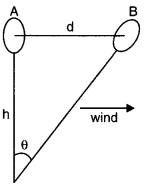
Question 2. 23. The Sun is a hot plasma (ionized matter) with its inner core at a temperature exceeding 107 K, and its outer surface at a temperature of about 6000 K. At these high temperatures, no substance remains in a solid or liquid phase. In what range do you expect the mass density of the Sun to be, in the range of densities of solids and liquids or gases? Check if your guess is correct from the following data: mass of the Sun = 2.0 x 10 30 kg, radius of the Sun = 7.0 x 10 8 m. Answer: Given M = 2 x 10 30 kg, r = 7 x 10 8 m .-. Volume of Sun = 4/3πr 3 x 3.14 x (7 x 10 8 ) 3 = 1.437 x 10 27 m 3 As p = M/V, .’. p = 2 x 10 30 /1.437 x 10 27 = 1391.8 kg m -3 = 1.4 x 10 3 kg m -3 Mass density of Sun is in the range of mass densities of solids/liquids and not gases.
Question 2. 24. When the planet Jupiter is at a distance of 824.7 million kilometres from the Earth, its angular diameter is measured to be 35.72″ of arc. Calculate the diameter of Jupiter. Answer: Given angular diameter θ = 35.72= 35.72 x 4.85 x 10 -6 rad = 173.242 x 10 -6 = 1.73 x 10 -4 rad Diameter of Jupiter D = θ x d = 1.73 x 10 -4 x 824.7 x 10 9 m =1426.731 x 10 3 = 1.43 x 10 8 m
Question 2. 25. A man walking briskly in rain with speed v must slant his umbrella forward making an angle θ with the vertical. A student derives the following relation between θ and v: tanθ = v and checks that the relation has a correct limit: as v—>θ, θ —>0, as expected. (We are assuming there is no strong wind and that the rain falls vertically for a stationary man). Do you think this relation can be correct? If not, guess the correct relation. Answer: According to principle of homogenity of dimensional equations, Dimensions of L.H.S. = Dimensions of R.H.S. Here, v = tan θ i. e., [L 1 T -1 ] = dimensionless, which is incorrect. Correcting the L.H.S., we. get v/u= tan θ, where u is velocity of rain.
Question 2. 26. It is claimed that two cesium clocks, if allowed to run for 180 years, free from any disturbance, may differ by only about 0.02 s. What does this imply for the accuracy of the standard cesium clock in measuring a time-interval of 1 s? Answer: Total time = 100 years = 100 x 365 x 24 x 60 x 60 s Error in 1 second=0.02/100 x 365 x 24 x 60 x 60 =6.34 x 10 -12 s .•. Accuracy of 1 part in 10 11 to 10 12 .
Question 2. 27. Estimate the average mass density of a sodium atom assuming its size to be about 2.5 A. (Use the known values of Avogadro’s number and the atomic mass of sodium). Compare it with the density of sodium in its crystalline phase: 970 kg m 3- . Are the two densities of the same order of magnitude? If so, why? Answer: It is given that radius of sodium atom, R = 2.5 A = 2.5 x 10 -10 m Volume of one mole atom of sodium, V = NA .4/3 π R 3 V = 6.023 x 10 23 x –4/3 x 3.14 x (2.5 x 10 -10 ) 3 m 3 and mass of one mole atom of sodium, M = 23 g = 23 x 10 -3 kg .•. Average mass density of sodium atom, p = M/V =(23 x 10 -3 /6.023 x 10 23 x 4/3 x 3.14 x (2.5 x 10 -10 )) = 6.96 x 10 2 kg m -3 = 0.7 x 10 -3 kg m -3 The density of sodium in its crystalline phase = 970 kg m -3 = 0.97 x 10 3 kg m -3 Obviously the two densities are of the same order of magnitude (= 10 3 kg m -3 ). It is on account of the fact that in solid phase atoms are tightly packed and so the atomic mass density is close to the mass density of solid.
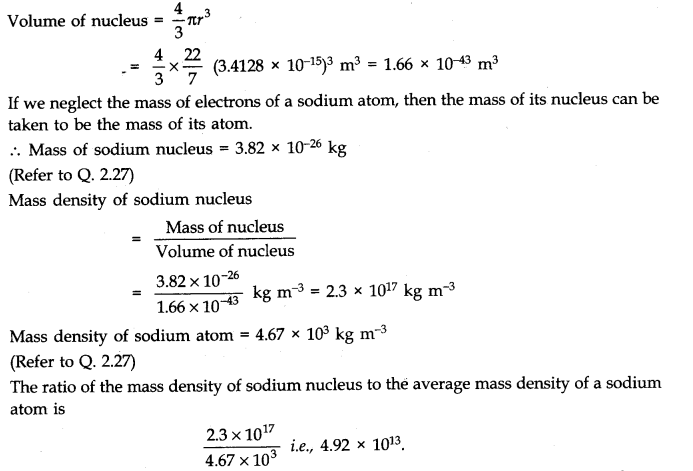
Question 2. 30. A SONAR (sound navigation and ranging) uses ultrasonic waves to detect and locate objects under water. In a submarine equipped with a SONAR the time delay between generation of a probe wave and the reception of its echo after reflection from an enemy submarine is found to be 77.0 s. What is the distance of the enemy submarine? (Speed of sound in water = 1450 m s -1 ). Answer: Here speed of sound in water v = 1450 m s -1 and time of echo t = 77.0 s. If distance of enemy submarine be d, then t = 2d/v .’. d=vt/2 =1450 x 77.0/2 =55825 m=55.8 x 10 3 m or 55.8 km.
Question 2. 31. The farthest objects in our Universe discovered by modem astronomers are so distant that light emitted by them takes billions of years to reach the Earth. These objects (known as quasars) have many puzzling features, which have not yet been satisfactorily explained. What is the distance in km of a quasar from which light takes 3.0 billion years to reach us? Answer: The time taken by light from the quasar to the observer t = 3.0 billion years = 3.0 x 10 9 years As 1 ly = 9.46 x 10 15 m .•. Distance of quasar from the observer d = 3.0 x 10 9 x 9.46 x 10 15 m = 28.38 x 10 24 m = 2.8 x 10 25 m or 2.8 x 10 22 km.
Question 2. 32. It is a well known fact that during a total solar eclipse the disk of the Moon almost completely covers the disk of the Sun. From this fact and from the information you can gather from examples 2.3 and 2.4, determine the approximate diameter of the Moon. Answer: From examples 2.3 and 2.4, we get θ = 1920″ and S = 3.8452 x 10 8 m. During the total solar eclipse, the disc of the moon completely covers the disc of the sun, so the angular diameter of both the sun and the moon must be equal. Angular diameter of the moon, θ= Angular diameter of the sun = 1920″ = 1920 x 4.85 x 10 -6 rad [1″ = 4.85 x 10 -6 rad] The earth-moon distance, S = 3.8452 x 10 8 m .’. The diameter of the moon, D = θ x S = 1920 x 4.85 x 10 -6 x 3.8452 x 10 8 m = 35806.5024 x 10 2 m = 3581 x 10 3 m 3581 km.
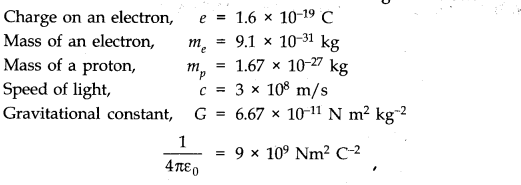
QUESTIONS BASED ON SUPPLEMENTARY CONTENTS
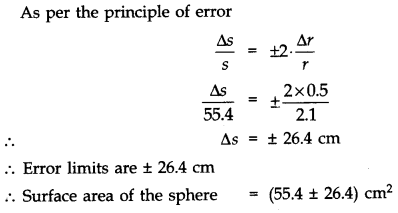
MORE QUESTIONS SOLVED
I.Very Short Answer Type Questions Question 1. What are the derived units? Answer: Units of those physical quantities which are derived from the fundamental units are called derived units.
Question 2. What do you understand by fundamental physical quantities? Answer: Fundamental physical quantities are those quantities which are independent of each other. For example, mass, length, time, temperature, electric current, luminous intensity and amount of substance are seven fundamental physical quantities.
Question 3. Define parsec. Answer: The distance at which a star would have annual parallax of 1 second of arc. 1 parsec = 3.08 x 10 16 m
Question 4. Define Atomic mass unit (a.m.u.). Answer: 1 a.m.u. = 1/12 th mass of carbon-12 atom, i.e., 1.66 x 10 -27 kg.
Question 5. Which is a bigger unit-light year or parsec? Answer: Parsec is bigger unit than light year (1 parsec = 3.26 light year).
Question 6. Do A and A.U. stand for same length? Answer: No, 1 A = 10 -10 m 1 A.U. = 1.496 x 10 11 m
Question 7. Name two pairs of physical quantities whose dimensions are same. Answer: —> Stress and Young’s modulus. —> Work and Energy.
Question 8. What is the order of precision of an atomic clock? Answer: About 1 in 10 12 to 10 13 s.
Question 9. What does RADAR stand for? Answer: RADAR stands for ‘Radio detection and ranging’.
Question 10. What does SONAR stand for? Answer: SONAR stands for ‘sound navigation and ranging’.
Question 11. f= x 2 , then what is the relative error in f? Answer: 2Δx/x
Question 12. Name at least six physical quantities whose dimensions are ML 2 T -2 . Answer: (i) Work (ii) Torque (iii) Moment of force (iv) Couple (v) Potential energy (vi) Kinetic energy.
Question 13. Name four units used in the measurement of extremely short distances. Answer: 1 micron (1 p) = 10 -6 m 1 nano metre (1 nm) = 10 -9 m 1 angstrom (1 A) = 10 -10 m 1 fermi (1 f) = 10 -15 m.
Question 14. If x = a + bt + ct 2 where x is in metre and t in second, then what is the unit of e? Answer: According to the principle of homogeneity of dimensions. [ct 2 ] = [L] or [c] = [LT -2 ] So, the unit of c is ms -2 .
Question 15. Do all physical quantities have dimensions? If no, name four physical quantities which are dimensionless. Answer: No, all physical quantities do not possess dimensions. Angle, specific gravity, Poisson’s ratio and Strain are four examples of dimensionless quantities.
Question 16. Obtain the dimensions of relative density. Answer: As relative density is defined as the ratio of the density of given substance and the density of standard distance (water), it is a dimensionless quantity.

Question 18. Do specific heat and latent heat have the same dimensions? Answer: No.
Question 19. Do mass and weight have the same dimensions? Answer: No.
Question 20. Given that the value of G in the CGS system as 6.67 x 10 -8 dyne cm 2 g -2 , find the value in MKS system. Answer: 6.67 x 10 -8 dyne cm 2 g -2 = 6.67 x 10 11 Nm 2 /kg 2 .
Question 21. Is Avogadro’s number a dimensionless quantity? Answer: No, it has dimensions. In fact its dimensional formula is [mol -1 ].
Question 22. Can a physical quantity have dimensions but still have no units? Answer: No, it is not possible.
Question 23. Are all constants dimensionless? Answer: No, it is not true.
Question 24. What is N m -1 s 2 equal to? Answer: N m -1 s 2 is nothing but SI unit of mass i.e., the kilogram.
Question 25. Express a joule in terms of fundamental units. Ans. [Energy] = [M L 2 T -2 ], hence 1 joule = 1 kg x 1 m 2 x 1 s -2 = 1 kg m 2 s -2 .
Question 26. What is the dimensional formula for torque? Answer: [M L 2 T -2 ].

Question 28. What does LASER stand for? Answer: LASER stands for ‘Light Amplification by Stimulated Emission of Radiation’.
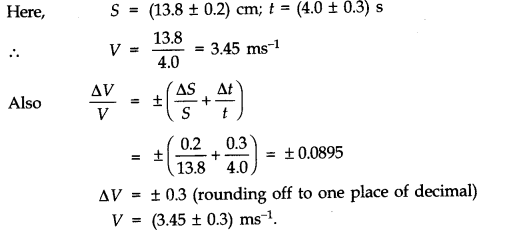
Question 2. What do you mean by order of magnitude? Explain. Answer: The order of magnitude of a numerical quantity (N) is the nearest power of 10 to which its value can be written.For example. Order of magnitude of nuclear radius 1.5 x 10 -14 m is -14.
Question 3. A laser signal is beamed towards the planet Venus from Earth and its echo is received 8.2 minutes later. Calculate the distance of Venus from the Earth at that time. Answer: We know that speed of laser light, c = 3 x 10 8 m/ s Time of echo, t = 8.2 minutes = 8.2 x 60 seconds If distance of Venus be d, then t = 2d/c d = 1/2ct = 1/2 x 3 x 10 8 x 8.2 x 60 m = 7.38 x 10 10 m = 7.4 x 10 10 m.
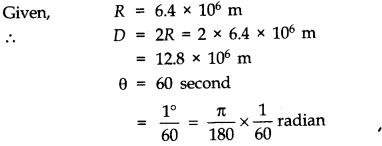
Question 9. If instead of mass, length and time as fundamental quantities, we choose velocity, acceleration and force as fundamental quantities and express their dimensions by V, A and F respectively, show that the dimensions of Young’s modulus can be expressed as [FA 2 V -4 ]. Answer: We know that the usual dimensions of Y are [MLT –2 ]/[L 2 ] i.e.,[M L -2 T -2 ] To express these in terms of F, A and V, we must express, M, L and T in terms of these new ‘fundamental’ quantities. Now, [V] = [LT –1 ], [A] = [LT –2 ] and [F] = [MLT –2 ] It follow that M = FA-1, T = VA~X, L = V2 A-1 [Y] = [ML -1 T –2 ] = [FA -1 ] [V 2 A -1 ] -1 [VA -1 ] -2 =FA 2 V -4 Thus the ‘new’ dimensions of Young’s modulus are [FV -4 A 2 ]

Question 15. The radius of the Earth is 6.37 x 10 6 m and its mass is 5.975 x 10 24 kg. Find the Earth’s average density to appropriate significant figures. Answer: Radius of the Earth (R) = 6.37 x 10 6 m Volume of the Earth (V) = 4/3 πR 3 m 3 = 4/3 x (3.142) x (6.37 x 10 6 ) 3 m 3 Average density (D)=Mass/Volume=M/V= 0.005517 x 10 6 kg m -3 The density is accurate only up to three significant figures which is the accuracy of the least accurate factor, namely, the radius of the earth.

Question 20. The radius of the Earth is 6.37 x10 6 m and its average density is 5.517 x 10 3 kg m -3 . Calculate the mass of earth to correct significant figures. Answer: Mass = Volume x density Volume of earth = 4/3π R 3 = 4/3 x 3.142 x (6.37 x 10 6 ) 3 m 3 Mass of earth = — x 3.142 x (6.37 x 10 6 ) 3 x 5.517 x 10 3 kg = 5974.01 x 10 21 kg = 5.97401 x 10 24 kg The radius has three significant figures and the density has four. Therefore, the final result should be rounded up to three significant figures. Hence, mass of the earth = 5.97 x 10 24 kg.
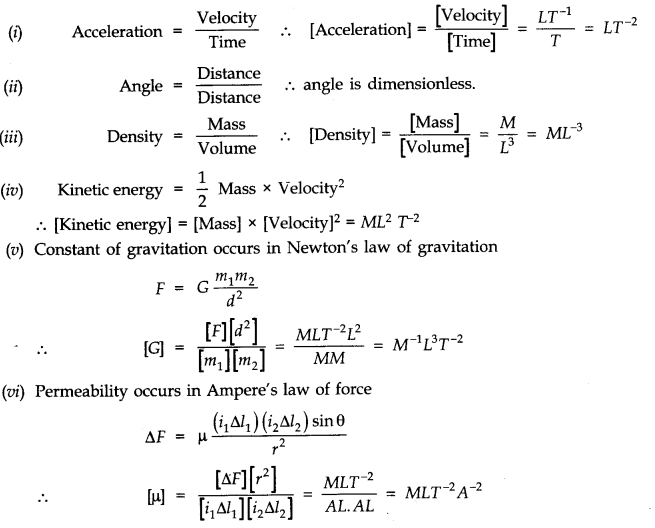
Question 4. Briefly explain how you will estimate the molecular diameter of oleic acid. Answer: To determine the molecular diameter of oleic acid, we first of all dissolve 1 mL of oleic acid in 20 mL of alcohol. Then redissolve 1 mL of this solution in 20 mL of alcohol. Hence, the concentration of final solution is 1/20 x 1/20 =1/400 th part of oleic acid in alcohol. Now take a large sized trough filled with water. Lightly sprinkle lycopodium powder on water surface. Using a dropper of fine bore gently put few drops (say n) of the solution prepared on to water. The solution drops spread into a thin, large and roughly circular film of molecular thickness on water surface. Quickly measure the diameter of thin circular film and calculate its surface area S. If volume of each drop of solution be V, then volume of n drops = n V Volume of oleic acid in this volume of solution = nV/400 It t be the thickness of oleic acid film formed over water surface then the volume of oleic acid film = St St =nV/400 =>t=nV/400S As the film is extremely thin, this thickness t may be considered to be the size of one molecule of oleic acid i.e., t is the molecular diameter of oleic acid. Experimentally, molecular diameter of oleic acid is found to be of the order of 10-9 m.
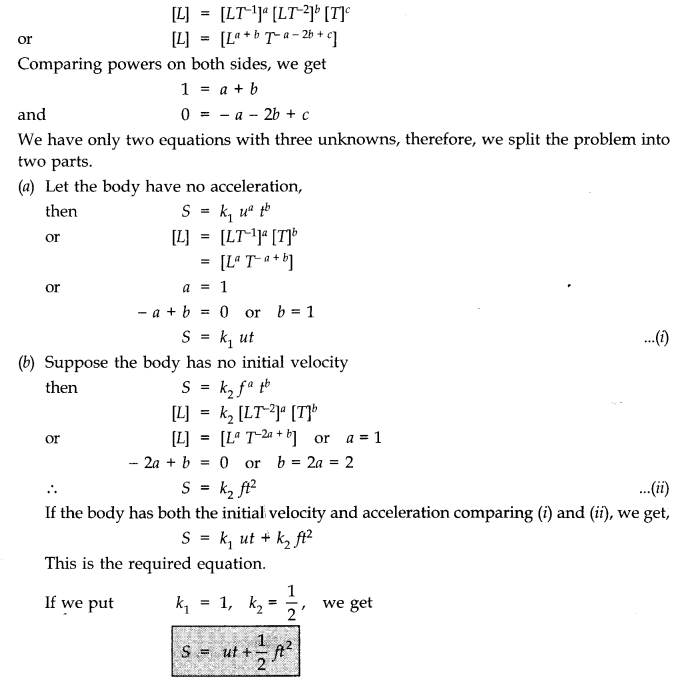
Question 7. The speed of light in air is 3.00 x 108 ms 1. The distance travelled by light in one year (i.e., 365 days = 3.154 x 10 7 s) is known as light year. A student calculates one light year = 9.462 x 10 15 m. Do you agree with the student? If not, write the correct value of one light year. Answer: One light year = speed x time = 9.462 x 10 15 m. When two physical quantities are multiplied, the significant figures retained in the final result should not be greater than the least number of significant figures in any of the two quantities. Since, in this case significant figures in one quantity (3.00 x 10 8 ms – 1) are 3 and the significant figures in the other quantity (3.154 x 10 7 s) are 4, therefore, the final result should have 3 significant figures. Thus, the correct value of one light year = 9.46 x 10 15 m.

Question 11. ft is required to find the volume of a rectangular Mock. A Vernier Caliper is used to measure the length, width and height of the Mock. The measured values are found to be 1.37 cm, 4.11 cm and 2.56 cm respectively. Answer: The measured (nominal) volume of the block is, V = l x w x h = (1.37 x 4.11 x 2.56) cm 3 = 14.41 cm 3 The least count of Vernier Caliper is ± 0.01 cm Uncertain values can be written as l = (1.37 ± 0.01) cm w = (4.11 ± 0.01) cm h = (2.56 ± 0.01) cm Lower limit of the volume of the block is, V ) = (1.37 – 0.01) x (4.11 – 0.01) x (2.56 – 0.01) cm 3 = (1.36 x 4.10 x 2.55) cm 3 = 14.22 cm 3 This is 0.19 cm 3 lower than the nominal measured value. Similarly the upper limit can also be calculated as follows. V(max) = (1.37 + 0.01) x (4.11 + 0.01) x (2.56 + 0.01) cm 3 = (1.38 x 4.12 x 2.57) cm 3 = 14.61 cm 3 This is 0.20 cm 3 higher than the measured value. But we choose the higher of these two values as the uncertainty i.e. (14.41 ± 0.20) cm 3
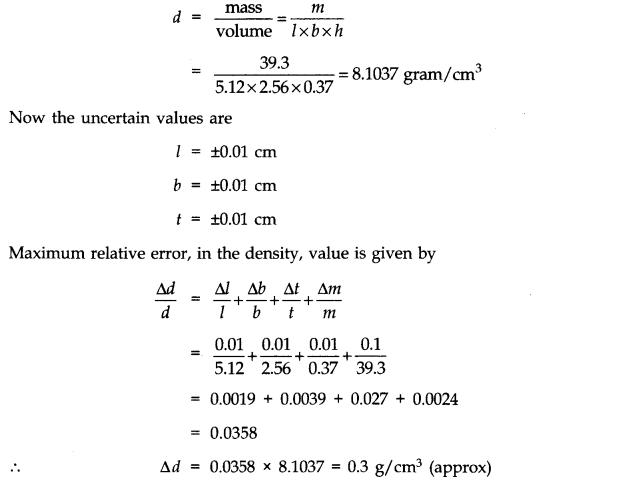
VI. Value-Based Questions Question 1. Suresh went to London to his elder brother Lalit who is a Civil Engineer there. Suresh found there f the currency is quite different from his country. He could not understand pound and how it is converted into rupees. He asked there an Englishman how far is Central London from here.He replied that it is 16 miles. Suresh again got confused because he never used these units in India. In the evening Suresh inquired all about it. His brother told him about the unit system used in England. He explained his brother that here F.P.S. system is used. It means, distance is measured in foot, mass in pound and time in seconds whereas in India it is MKS system. (i) What values are displayed by Suresh? (ii) How many unit system are there? Answer: (i) Sincerity, Curiosity, dedicated and helping nature (ii) Unit system are : (a) FPS system (b) MKS system (c) CGS system
NCERT Solutions for Class 11 Physics All Chapters
- Chapter 1 Physical World
- Chapter 2 Units and Measurements
- Chapter 3 Motion in a Straight Line
- Chapter 4 Motion in a plane
- Chapter 5 Laws of motion
- Chapter 6 Work Energy and power
- Chapter 7 System of particles and Rotational Motion
- Chapter 8 Gravitation
- Chapter 9 Mechanical Properties Of Solids
- Chapter 10 Mechanical Properties Of Fluids
- Chapter 11 Thermal Properties of matter
- Chapter 12 Thermodynamics
- Chapter 13 Kinetic Theory
- Chapter 14 Oscillations
- Chapter 15 Waves
We hope the NCERT Solutions for Class 11 Physics Chapter 2 Units and Measurements help you. If you have any query regarding NCERT Solutions for Class 11 Physics Chapter 2 Units and Measurements, drop a comment below and we will get back to you at the earliest.
Free Resources
Quick Resources
- Skip to main content
- Skip to secondary menu
- Skip to primary sidebar
- Skip to footer
Learn Insta
RD Sharma Solutions , RS Aggarwal Solutions and NCERT Solutions
Units and Measurements Class 11 Important Extra Questions Physics Chapter 2
March 18, 2021 by Prasanna
Here we are providing Class 11 Physics Important Extra Questions and Answers Chapter 2 Units and Measurements Important Questions for Class 11 Physics with Answers are the best resource for students which helps in Class 11 board exams.
Class 11 Physics Chapter 2 Important Extra Questions Units and Measurements
Units and measurements important extra questions very short answer type.
Question 1. If the size of the atom were enlarged to the tip of the sharp pin, how large would the height of Mount Everest be? Answer: 10 10 m.
Question 2. What does the LASER mean? Answer: It stands for Light Amplification by Stimulated Emission of Radiation.
Question 3. If the Universe were shrunk to the size of the Earth, how large would the Earth be on this scale? Answer: 1o -11 m (size of an atom.).
Question 4. A research worker takes 100 careful readings in an experiment. If he repeats the same experiment by taking 400 readings, then by what factor will the probable error be reduced? Answer: By a factor of 4.
Question 5. What is the number of significant figures in 0.06070? Answer: 4.
Question 6. Which of the following reading is most accurate? (a) 7000m, (b) 7 × 10 2 m, (c) 7 × 10 3 m Answer: (a) i.e. 7000 m.
Question 7. The density of a cube is calculated by measuring the length of one side and its mass. If the maximum errors in the measurement of mass and length are 3% and 2% respectively, then what is the maximum possible error in the measurement of density? Answer: 3% + 3 × 2% = 9%.
Question 8. The mass of a body as measured by two students is given as 1.2 kg and 1.23 kg. Which of the two is more accurate and why? Answer: The second measurement is more accurate as it has been made to the second decimal point.
Question 9. Do the inertial and gravitational masses of ordinary objects differ in magnitude? Answer: No.
Question 10. Are S.I. units Coherent? Why? Answer: Yes, because all the derived units in this system can be obtained by multiplying or dividing a certain set of basic units.
Question 11. Do A.U. And Å represents the same magnitudes of distance? Answer: No, 1 A.U. = 1.496 × 10 11 m and 1 Å = 10 10 m.
Question 12. What does SONAR stand for? Answer: It stands for Sound Navigation and Ranging.
Question 13. What is the atomic mass unit (a.m.u.)? Answer: It is defined as \(\frac{1}{12}\)th of the mass of one 6C12 atom i.e. 1 a.m.u. = \(\frac{1}{12} \times \frac{12}{6.023 \times 10^{23}}\) = 1.66 × 10 -27 kg
Question 14. Which is the most accurate clock? Answer: Cesium atomic clock.
Question 15. Write the S.I. units of the following physical quantities: (a) Luminous intensity Answer: Candela (cd)
(b) Temperature Answer: Kelvin (K)
(c) Electric current Answer: Ampere (A)
(d) Amount of substance Answer: Mole (mol)
(e) Plane angle Answer: Radian (rd)
(f) Solid angle Answer: Steradian (sr)
(g) Pressure. Answer: Nm-2 = pascal (pa).
Question 16. What is the difference between mN, Nm, and nm? Answer:
- mN means.milli-newton, 1 mN = 10 -3 N.
- Nm means newton-meter, 1 Nm = 1 J
- nm means namometer, 1 nm = 10 -9 m.
Question 17. If x = a + bt + ct 2 where x is in meter and t in seconds, what is the unit of c? Answer: The unit on the left-hand side is a meter so the units of ct 2 should also be a meter. Since t 2 has units of s 2 , so the unit of c is ms -2
Question 18. Will the dimensions of a physical quantity be the same, whatever be the units in which it is measured? Why? Answer: Yes, the dimensions don’t depend on the system of units chosen.
Question 19. Write the dimensions of: (i) gravitational constant Answer: [M -1 L 3 T 2 ]
(ii) Plank’s constant Answer: [M L 2 T -1 ]
(iii) torque Answer: [M L 2 T 2 ]
(iv) surface tension Answer: [M L 0 T -2 ]
(v) angular momentum. Answer: [M L 2 T -1 ]
Question 20. Name at least two physical quantities each having dimensions: (a) [M L -1 T -2 ] Answer: Pressure and stress,
(b) [M L 2 T -1 ] Answer: Plank’s constant and angular momentum.
Question 21. State the principle of homogeneity of dimensions? Answer: It states that the dimensions of each term on both sides of an equation are the same.
Question 22. Which are the main types of errors in a physical measurement? Answer: Main errors are systematic error, random error, gross error, relative error, and percentage error.
Question 23. Which one is large, the number of microseconds in a second or the number of seconds in a year? The number of seconds in a year = 10 7 s and the number of microseconds in a second = 10 6 μs. So the number of seconds in a year is larger than microseconds in a second.
Question 24. Do significant figures change if the physical quantity is measured in different systems of units? Answer: No, significant figures don’t depend on the system of units. e.s. 250 g = 2.50 × 10 -1 kg. Both have 3 significant figures.
Question 25. Suggest a distance corresponding to each of the following order of length: (a) 10 -4 m Answer: Size of the atomic nucleus
(b) 10 -9 m Answer: Size of the oil molecule
(c) 10 4 m Answer: Height of Mount Everest
(d) 10 7 m Answer: Radius of Earth
(e) 10 9 m. Answer: The radius of Sun.
Question 26. What do you understand by the following? (a) Century Answer: It is the largést unit of time, 1 century = 100 years.
(b) Shake Answer: It is the smallest unit of time, 1 shake = 10 -8 s.
(c) Lunar month Answer: It is the time taken by the moon to complete one revolution around the Earth, 1 lunar month = 27.3 days.
(d) Leap year Answer: A year that is divisible by four and in which the month of February is of 29 days is called a leap year.
(e) Tropical year. Answer: The year in which the total solar eclipse takes place is called a tropical year.
Question 27. What is the role of power (index) of a measurable in the formula used for calculation of a quantity in regard to the error in the quantity as determined in the given experiment? Answer: The error in the quantity becomes power times the error, i.e. if x = p a q b . Then \(\frac{\Delta x}{x}=a \frac{\Delta p}{p}+b \frac{\Delta q}{q}\)
Question 28. How will you find the size of a liquid molecule? Answer: Using the formula, t = \(\frac{\mathrm{nV}}{500 \mathrm{~A}}\) we can find the size of the liquid molecule. where V = volume of liquid (say oleic acid), n = no. of drops in the solution of \(\frac{1}{500}\) concentration A = area of the film of oleic acid left t = thickness of the film.
Question 29. What do you mean by the term measurement? Answer: Measurement means the comparison of a physical quantity with its unit to find out how many times the unit is contained in the given physical quantity.
Question 30. Sort out the incorrect representation of units and write them (i) m/sec Answer: ms -1
(ii) Newton Answer: newton
(iii) kelvin Answer: kelvin
(iv) m.m. Answer: mm
(v) Jk -1 Answer: JK -1
(vi) kg/m 3 Answer: kgm -3
(vii) wH Answer: Wh
(viii) gms -2 Answer: gs2
(ix) length = 5M Answer: length = 5 m
(x) B = 4g (B = magnetic field intensity). Answer: B = 4G
Question 31. Define light year. Answer: It is defined as the distance traveled by light in one year. 1 L.Y. (ly) = 3 × 10 8 ms -1 × 365 × 24 × 60 × 60s ≈ 9.46 × 10 15 m.
Question 32. Define Astronomical distance. Answer: It is defined as the distance between the Earth and Sun. 1 A.U. = 1.496 × 10 11 m~ 1.5 × 10 11 m.
Question 33. What is the limit of (i) accuracy Answer: The least count of the measuring instrument is the limit of accuracy with which a physical quantity can be measured.
(ii) error? Answer: The error in measurement is taken equal to half the least count.
Question 34. What do you mean by ‘Order of magnitude’? Answer: Order of magnitude is defined as the approximation to the nearest power of 10 used to express the magnitude of a physical quantity under consideration, e.g.
- The order of magnitude of the time interval of 1.2 × 10 -6 s is -6.
- The order of magnitude of the distance of 4.5 × 10 6 is +6.
Question 35. Find the order of magnitude of a light-year. Answer: I light year = 9.46 × 10 15 m ≈ 10 16 m ∴ The order of magnitude of light-year is +16.
Question 36. Derive the dimensional formula of: (a) Angular velocity Answer: Angular velocity = \(\frac{\text { Angle }}{\text { Time }}=\frac{1}{\mathrm{~T}}\) = [M 0 L 0 T -1 ]
(b) Angular momentum Answer: Angular momentum = momentot inertia × Angular velocity = mass x (radius of rotalion) 2 (Time) -1 = [M L 2 T -1 ].
Question 37. Derive the dimensional formula of: (a) Impulse Answer: Impulse = Force x Time = [M L T -2 ][T] = [M L 2 T -1 ].
(b) Surface energy Answer: Surfäce energy = \(\frac{\text { Energy }}{\text { Surface area }}\) = \(\frac{\left[\mathrm{ML}^{2} \mathrm{~T}^{-2}\right]}{\left[\mathrm{L}^{2}\right]}\) = [M L 0 T -2 ].
Question 38. Derive the dimensional formula of (a) Specific gravity Answer: Specific gravity = \(\frac{\text { Density of substance }}{\text { Density of water at } 4^{\circ} \mathrm{C}}\) = \(\frac{\left[\mathrm{ML}^{3} \mathrm{~T}^{0}\right]}{\left[\mathrm{ML}^{-3} \mathrm{~T}^{0}\right]}\) = [M 0 L 0 T 0 ]
(b) Coefficient of viscosity . Answer: Coefficient of viscosity = \(\frac{\text { Force } \times \text { Distance }}{\text { Area } \times \text { velocity }}\) = \(\frac{\left[\mathrm{MLT}^{-2}\right][\mathrm{L}]}{\left[\mathrm{L}^{2}\right]\left[\mathrm{LT}^{-1}\right]}\) = [M L -1 T -1 ]
Question 39. Derive the dimensional formula of: (a) Universal gas constant Answer: Universal gas constant = \(\frac{\text { Pressure } \times \text { Volume }}{\text { Temperature }}\) = \(\frac{\left[\mathrm{ML}^{-1} \mathrm{~T}^{-2}\right]\left[\mathrm{L}^{3}\right]}{[\mathrm{K}]}\) = [M L 2 T 2 K -1 ]
(b) Specific heat. Answer: Specific heat = \(\frac{\text { Heat }}{\text { Mass } \times \text { Temperature }}\) = \(\frac{\left[\mathrm{ML}^{2} \mathrm{~T}^{-2}\right]}{[\mathrm{MK}]}\) = [M 0 L 2 T -2 K -1 ].
Question 40. Derive the dimensional formula of: (a) Coefficient of elasticity Answer: Coefficient of elasticity = \(\frac{\text { Stress }}{\text { Strain }}\) = \(\frac{\left[\mathrm{ML}^{-1} \mathrm{~T}^{-2}\right]}{\left[\mathrm{M}^{0} \mathrm{~L}^{0} \mathrm{~T}^{0}\right]}\) = [M L -1 T -2 ]
(B) Boltzmann’s constant Answer: Boltzmann’s constant = \(\frac{\text { Energy }}{\text { Temperature }}\) = \(\frac{\left[\mathrm{ML}^{2} \mathrm{~T}^{-2}\right]}{[\mathrm{K}]}\) = [M L 2 T -2 K -1 ]
Question 41. Define dimensions of a physical quantity. Answer: They are defined as the powers to which the fundamental units of mass, length, and time have to be raised to obtain its units, e.g. derived unit of area is [M 0 L 2 T 0 ]. Thus its dimensions are 1 zero in mass, 2 in length, and zero in time.
Question 42. Define the dimensional formula of a physical quantity. Answer: It is defined as an expression that shows which of the fundamental units and with what powers appear into the derived unit of a physical quantity. e.g. dimensional formula of force is [M 1 L 1 T 2 ].
Question 43. Define dimensional equation of a physical quantity. Answer: It is defined as the equation obtained by equating the symbol of a physical quantity with its dimensional formula, e.g. [F] = [M L T -2 ] is the dimensional equation of force.
Question 44. Define one kilogram. Answer: It is the mass of platinum-iridium cylinder (90% Pt + 10% Ir) having its diameter equal to its height (both equal to 3.9 cm) kept in the International Bureau of Weights and Measures of Sevres near Paris.
Question 45. Define one second. Answer: It is defined as the time interval occupied by 9, 192, 631, 770 vibrations corresponding to the transition between two hyperfine levels of cesium -133 (Cs 133 ) atom in the ground state.
Question 46. Define one ampere. Answer: It is defined as that constant current which when flowing through two parallel, straight conductors of the infinite length of negligible cross-section held one meter apart in a vacuum produces a force of 2 × 10 -7 N/m between them.
Question 47. Define Kelvin. Answer: It is defined as \(\frac{1}{273.16}\) fraction of the thermodynamic temperature at the triple point of water.
Question 48. Define radian. Answer: It is defined as the angle made at the center of a circle by an arc of length equal to the radius of the circle.
Question 49. Define steradian. Answer: It is defined as the solid angle made at the center of a sphere by an area cut from its surface whose area is equal to the square of the radius of the sphere.
Question 50. Define one mole. Answer: It is defined as the amount of substance that contains the same number of elementary units {i.e. atoms) as there are atoms in 0.012 kg of carbon-12.
Question 51. Define standard meter. Answer: It is defined to be equal to exactly 1650763.73 wavelengths of orange-red light emitted in vacuum by krypton-86 atom i.e. kr 86 . i. e. 1 metre = 16,50,763.73 wavelengths. Or It is also defined as the distance traveled by light in \(\frac{1}{299792458}\) second.
Here 299792458 ms -1 is the exact value of the velocity of light.
For all practical purposes, c = 2.9 × 10 8 ms -1 = 3.0 × 10 8 ms -1 .
Units and Measurements Important Extra Questions Short Answer Type
Question 1. If the size of a nucleus is scaled up to the tip of a sharp pin, what roughly is the size of an atom? Answer: The size of a nucleus is in the range of 10 -15 m to 10 -14 m. The tip of a sharp pain may be taken to be in the range of 1o -5 m to 10 -4 m. Thus we are scaling up the size of the nucleus by a factor of 10 -5 /10 -15 = 10 10 . An atom roughly of size 10 -10 m will be scaled up to a rough size of 10 -10 × 10 10 = 1 m. Thusanucleus in an átom is as small in size as the tip of a sharp pin placed at the center of a sphere of radius about a meter.
Question 2. (a) What do you mean by physical quantity? Answer: It is defined as a quantity that can be measured, e.g. mass, length, time, etc.
(b) What do you understand by: (i) Fundamental physical quantities? Answer: They are defined as those quantities which cannot be expressed in terms of other quantities and are independent of each other, e.g. mass, length, time.
(ii) Derived physical quantities? Answer: They are defined as the quantities which can be expressed in terms of fundamental quantities, e.g. velocity, acceleration, density, pressure, etc.
Question 3. (a) Define the unit of a physical quantity. Answer: It is defined as the reference standard used to measure a physical quantity.
(b) Define: (i) Fundamental units. Answer: They are defined as the units of fundamental quantities. They are independent of each other and are expressed by writing the letter of the fundamental quantity in a parenthesis. e.g. Fundamental units of mass, length and time are [M], [L], [T] respectively.
(ii) Derived units. Answer: They are defined as those units which can be derived from fundamental units. They are expressed by writing the symbol of a derived quantity in a parenthesis. e.g. D.U. of velocity = [u] acceleration = [a] pressure = [P] work = [W] and so on.
Question 4. Define one Candela. Answer: It is defined as the luminous intensity in a perpendicular direction of a surface of \(\frac{1}{600,000}\) square meter area of a black body at a temperature of freezing platinum (1773°C) under a pressure of 101,325 N/m 2 .
It is the S.I. unit of luminous intensity.
Question 5. What is the advantage of choosing wavelength of light radiation as standard of length? Answer:
- It can be easily made available in any standard laboratory as Krypton is available everywhere.
- It is well defined and does not change with temperature, time, place or pressure, etc.
- It is invariable.
- It increases the accuracy of the measurement of length (1 part in 10 9 ).
Question 6. Which type of phenomenon can be used as a measure of time? Give two examples of it. Answer: Any phenomenon that repeats itself regularly at equal intervals of time can be used to measure time.
The examples are:
- Rotation of earth – the time interval for one complete rotation is called a day.
- Oscillations of a pendulum.
Question 7. Find the number of times the heart of a human being beats in 10 years. Assume that the heartbeats once in 0.8s. Answer: In 0.8 s, the human heart makes one beat.
∴ In 1 s, the human heart makes = \(\frac{1}{0.8}=\frac{10}{8}\) beats.
∴ In 10 years, the human heart makes = \(\frac{10}{8}\) × 365 × 24 × 60 × 60 beats. = 3.942 × 10 8 beats.
Question 8. Why it is not possible to establish a physical relation involving more than three variables using the method of dimensions? Answer: The dimensional analysis fails to derive a relation involving more than three unknown variables. The reason is that there will be more than three unknown factors in that case whose values cannot be determined from the three relations which we get by comparing the powers of M, L, and T.
Question 9. What is the difference between accurate and precise measurement? Answer: A given measurement is said to be accurate in relation to other similar measurements if the error involved in it is least.
A given measurement is said to be precise in relation to other similar measurements if it is taken with an instrument with the minimum least count.
Question 10. Pick up the most accurate and most precise measurement out of (a) 50.0 m, (b) s.oe m, (e) 5.00 cm, (f) 5.00 mm. Answer: The following table gives the relative error in count of the given measurement:
| 50.00 m | 0.01 m | 0.01/50 = 0.2 × 10 |
| 5.00 m | 0.01 m | 0.01/5 = 0.2 × 10 |
| 5.00 cm | 0.01 cm | 0.01/5 = 0.2 × 10 |
| 5.00 mm | 0.01 mm | 0.01/5 = 0.2 × 10 |
Clearly, the first measurement is most accurate because the relative error in it is minimum. The fourth measurement is most precise because it is taken with an instrument having the minimum least count among the v given measurements.
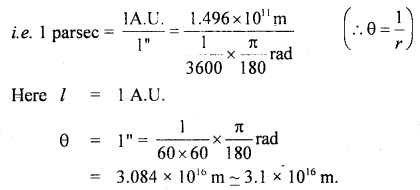
∴ s = \(\frac{b}{θ}\)
The parallax method is used to measure the distance of stars. Here, b = basis = E 1 E 2 distance where E 1 and E 2 are the two observation points on earth. θ = angle made by the star at point O. To find θ, let us observe the star 0’ simultaneously and let Φ 1 and Φ 2 be the angles made at E 1 and E 2 . ∴ θ = Φ 1 + Φ 2 ∴ s = \(\frac{b}{\phi_{1}+\phi_{2}}\)
Question 13. Give Avogadro’s method to measure distances of the order of 10 -10 m. Answer: It is the indirect method of measuring the distances of the order of 10-10 m which is the size of an atom i.e. small distances. An atom is a tiny sphere. When such atoms lie packed in any substance; empty spaces are left in between. According to Avogadro’s hypothesis, the volume of all atoms in one gram of substance is \(\frac{2}{3}\) of the volume occupied by one gram of the substance.
i.e. V’ = \(\frac{2}{3}\)V ….(i) Where V = actual volume of one gram mass. V’ = volume occupied by atoms in I gram mass. ρ = density of the substance. ∴ V = \(\frac{1}{ρ}\) …(ii)
Let m = atomic weight of the substance. N = Avogadro’s number
∴Number of atoms in I gram of the substance = \(\frac{N}{M}\) If r be the radius of each atom, then V’ = no. of atoms in I gram x volume of each atom Or V’ = \(\frac{N}{M}\) x \(\frac{4}{3}\) 4πr3 …. (iii)

Question 14. What arè the characteristics of a standard unit? Answer: The characteristics of a standard unit are as follows:
- It should be well defined.
- It should be of the proper size.
- It should be easily accessible.
- It should be reproducible in all places.
- It should not change with time, place, and physical conditions such as pressure, tèmperature, etc.
- It should be widely accepted.
Question 15. What are the advantages of the S.I. system? Answer: Following are the main advantages of the S.I. system over other systems of units i.e. (C.G.S, FPS, and MKS). 1. It is a coherent system of units i.e. a system based on a certain set of fundamental units from which all derived units are obtained by multiplication or division without introducing numerical factors i.e. units of a given quantity are related to one another by the power of 10. So the conversions are easy.
2. S.I. is a rational system of units as it assigns only one unit to a particular physical quantity e.g. Joule is the S.I. unit for all types of energies while MKS units of mechanical energy, heat energy, and electrical energy are Joule, calorie, and watt-hour respectively.
3. It is an absolute system of units: There are no gravitational units on the system. The use of factor ‘g’ is thus eliminated.
4. It is a metric system i.e. the multiples and submultiples of units are expressed as powers of 10.
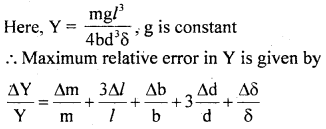
Question 17. Classify the physical quantities on basis of their dimensional formula. Answer: They are divided into the following four categories: 1. Dimensional variables: They are defined as the physical quantities which possess dimensions and have variable values e.g. Area, velocity, force, etc.
2. Non-dimensional variables: They are defined as the physical quantities which have no dimensions but have variable values, e.g. Angle, specific gravity, strain, sin0, cos0 (i.e. trigonometric functions).
3. Dimensional constants: They are defined as the physical quantities which have both dimensions and constant values, e.g. Plank’s constant, speed of light in vacuum, gravitational constant.
4. Dimensionless constants: They are defined as the physical quantities which do not have dimensions but have constant values, e.g. n, e, pure numbers 1, 2, 3, …… etc.
Question 18. What are the limitations of dimensional analysis? Answer: Following are the limitations of dimensional analysis:
- Dimensionless constants involved in the physical relationship can not be determined.
- It fails to derive the relations involving plus or minus signs like s = ut + \(\frac{1}{2}\)at 2 , v = u + at, v 2 — u 2 = 2as etc.
- It fails to derive a relation involving more than three physical quantities.
- This method does not help to derive the relations containing exponential and trigonometrical functions.
- This method gives no information on whether a quantity is a scalar or vector.
- It does not tell about the physical correctness of a relation.
Question 19. Define significant figures. State the rules for determining the number of significant figures in a given measurement. Answer: They are defined as the number of digits up to which we are sure about their accuracy. In other words, they are defined as those digits that are known correctly in an experimental observation plus one more digit that is uncertain.
Following are the rules for determining significant figures:
- All non-zero digits are significant.
- All zeros occurring between non-zero digits are significant.
- All zeros to the right of the last non-zero digit are not significant.
- All zeros to the right of a decimal point and to the left of a non¬zero digit are not significant, e.g. 0.000879 has (3) significant figures.
- All zeros to the right of a decimal point and to the right of a non-zero digit are significant, e.g. 0.2370 contains (4) sig-fig.
- All zeros to the right of a non-zero digit and to the left of an expressed decimal are significant, e.g. 21900. has (5) sig-fig.
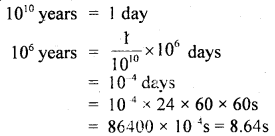
Question 21. State and explain the rule for finding the maximum possible error in a result. Answer: The maximum possible error is found in different ways in different types of results as follows: (a) When the result involves the sum of two quantities, i. e. if x = p + q then, maximum possible error = maximum absolute error in first quality + maximum absolute error in the second quality. i.e. Δx = Δp + Δq
(b) When the result involves the difference of the quantities i.e. if x = p – q then, maximum possible error in x = maximum absolute error in p + maximum possible error in q i.e. Δx = Δp + Δq
(c) When the result involves the multiplication of two quantities i.e. x = pq; then maximum relative error in x is given by \(\frac{\Delta x}{x}=\frac{\Delta p}{p}+\frac{\Delta q}{q}\)
(d) When the result involves the quotient of tw«j observed quantities i.e. when x = p/q, then Maximum relative error in x is given by \(\frac{\Delta x}{x}=\frac{\Delta p}{p}+\frac{\Delta q}{q}\)
(e) When the result involves some power oFa physical quantity, i.e. when x = pa qb, then maximum absolute e> u r in x is given by \(\frac{\Delta x}{x}=a \frac{\Delta p}{p}+b \frac{\Delta q}{q}\)
i.e. maximum possible relative error in x = power × relative . error in p + power × relative error in q.
Thus the error is always additive in nature and maximum, permissible error is equal to the sum of maximum possible error in the i. individual quantities of that quantity.
Question 22. How do you represent very large and very small physical y quantities? Write the prefixes, multiple, submultiple, and their symbols in a tabular form. Answer: The very long and very small quantities are written in powers of 10. The prefixes are tabled below:
| 1. 10 | Tera (Trillion) | T |
| 2. 10 | Giga (billion) | G |
| 3. 10 | mega(million) | M |
| 4. 10 | kilo | K |
| 5. 10 | Hecta | h |
| 6. 10 | Deca | da |
| 7. 10 | Deci | d |
| 8. 10 | Centi | c |
| 9. 10 | mull | m |
| 10. 10 | micro | u |
| 11. 10 | nano | n |
| 12. 10 | pico | p |
| 13. 10 | femto | f |
| 14. 10 | Atto | a |
Question 23. Explain the importance of reference frames in measurements. Answer: (a) All measurements are made with reference to a point or portion i.e., a frame of reference. (b) The number of time units contained in a physical quantity gets changed with a change in the reference frame. (c) The same physical quantity may have different values in different reference frames.
Question 24. Briefly describe the various techniques to measure time. Answer: The various techniques to measure time are: (a) The synchronous motor run on a.c. of frequency 50 hertz is used to measure time as its rotation provides a time scale.
(b) Electronic oscillations: The semiconductor oscillators produce high-frequency oscillations i.e. of a very small time period. These oscillations thus can be used to measure the small time intervals.
(c) Quartz-crystal clocks: These clocks work on the piezoelectric effect. The oscillations so produced can be used to measure time intervals.
(d) Atomic clock: These are usually Cs-133 atom clocks whose electrons make a definite number of repeated jumps between two energy levels. These are very precise and are used to define second, so time can be measured.
(e) Decay of elementary particles: The study of decay can provide a scale for the measurement of very small intervals of time as unstable elementary particles decay between 10 -16 to 10 -24 seconds.
(f) Radioactive dating: Very long intervals of time can be measured by comparing them with the techniques of radioactive dating. The half-life period of decay of carbon is a standard time frame to determine the age of fossils etc.
Question 25. Explain the rules for finding significant figures in the sum, difference, product, and quotients of true numbers. Answer: The rules for counting significant figures in algebraic operations are given below: 1. Addition and Subtraction: The sum or the difference of two numbers has significant figures only in those places where these are in the least precise amongst the given number. For example, if we subtract 45.7 from 46.9267 the result is 1.2267. But it should be written only 1.2 because the least precise of the two numbers is 45.7 and there is only one digit after the decimal.
Similarly in the sum of numbers 4205, 112.39, 77.93, and 213.2532, the correct result is 824.0 to the significant figures. So, in addition, or subtraction the same number of the decimal. places are retained in the result as are present in the number with the minimum amount of decimal places.
2. Multiplication and Division: The product or quotient of two numbers does not have more significant figures than are present in the least precise of the given numbers. e.g. in the product of two quantities 0.025 with 40, we get 1.000 but the answer is to be written as 1.0 because there are two significant figures in 40 the least of the two numbers. Similarly in a quotient when we divide 16.775 by 2.5, we get 6.71. The result of the significant figure will be 6.7.
Question 26. Is it possible for an equation to be dimensionally correct still to be wrong? If so indicate the number of ways in which this might happen. Answer: It is possible that an equation may be dimensionally correct but physically it is wrong. For example the displacement of a particle moving with velocity u and acceleration ‘a’ after time t is given by s = ut + 1/2at 2
However, s = 1/2at 2 is dimensionally correct, as [L] = [LT 2 ][T 2 ] 2 shows dimensions on LHS = dimensions on RHS. Therefore, in certain circumstances, an equation may be dimensionally correct but actually, it is not physically correct. This happens especially in equations involving the sum and difference of two or more terms and in functions involving trigonometric functions. For example, the displacement y maybe y = a where a is the amplitude. This is dimensionally correct but does not give the full picture of the physical phenomenon.
The correct equation is
y = a sin wt or y = a sin \(\frac{2 \pi}{\lambda}\) (vt + x) etc.
Question 27. Show that bigger is the unit smaller is the numerical value of physical quantity and vice-versa. Answer: In any system of unit, the following relations hold good n 1 u 1 = n 2 u 2
Where n 1 and n 2 are the numerical values, u 1 and u 2 represent the unit of a physical quantity. This relation is based on the simple thing that the magnitude of a physical quantity remains the same in different systems of units. Thus nu = constant or n ∝ \(\frac{1}{u}\)
If larger the n smaller will be the unit (u) and smaller the numerical value (n) Larger will be u. E.g. if the length of a rod l be 1 m in the S.I. system. Then it is 100 cm in the C.G.S. system i.e.
l = 1 m = 100 cm. Here clearly 1 < 100 and m > cm. Hence proved.
Question 28. The difference in the order of magnitude of the longest and shortest distances and most massive and least massive objects are quite different. Write the same and compare them. Answer: The size of the nucleus is of the order 10 -15 m and the intergalactic distance is of the order of 10 22 m. So, the ratio between the longest and the shortest distance is: \(\frac{10^{22} \mathrm{~m}}{10^{-15} \mathrm{~m}}\) = 10 37
The smallest mass is the mass of an electron of the order of 10 -30 kg and the longest mass is the mass of the galaxy of the order of 10 42 kg. So, the ratio of maximum to minimum mass is \(\frac{10^{42} \mathrm{~kg}}{10^{-30} \mathrm{~kg}}\) = 10 72
Now the ratio between the mass ratio and distance ratio is \(\frac{10^{72}}{10^{37}}\) = 10 35
The ratio betwe< n minimum mass and minimum distance is \(\frac{10^{-30} \mathrm{~kg}}{10^{-15} \mathrm{~m}}\) = 10 -15
The ratio between maximum mass and minimum distance is \(\frac{10^{42} \mathrm{~kg}}{10^{22} \mathrm{~m}}\) = 10 20

(iii) percentage error. Answer: Percentage error is the relative error expressed in percent Percentage error = \(\frac{\Delta \mathrm{a}_{\text {mean }}}{\mathrm{a}_{\text {mean }}}\) × 100
Question 30. State the rules applied in rounding off measurements. Answer: While rounding off measurements, the following rules are applied: 1. If the digit to be dropped is smaller than 5, then the preceding digit should be left unchanged. e.g. 7.93 is rounded off to 7.9.
2. If the digit to be dropped is greater than 5, then the preceding digit should be raised by 1. e.g. 17.26 is rounded off to 17.3.
3. If the digit to be dropped in 5 followed by digits other than zero, then the preceding digit should be raised by 1. e.g. 7.351 on being rounded off to first decimal becomes 7.4.
4. If the digit to be dropped in 5 or 5 followed by zeros, then the preceding digits are not changed if it is even. e.g. (a) 3.45 on being rounded off becomes 3.4. (b) 3.450 on being rounded off becomes 3.4.
5. If the digit to be dropped in 5 or 5 followed by zeros, then the preceding digit is raised by one if it is odd. e.g. (a) 3.35 on being rounded off becomes 3.4. (b) 3.50 on being rounded off becomes 3.4.
Note: Rules (iv) are based on the convention that the number is to be rounded off to the nearest even number.
Units and Measurements Important Extra Questions Long Answer Type
Question 1. State the rules for writing the units of physical quantities in the S.I. system. Answer: While writing the units of physical quantities following rules are followed with S.L units: (1) The S.l. units are written in the form of symbols after the number i.e., number of time, the unit is contained in the physical quantity so that physical quantity = nu
With symbols, certain rules are laid down:
- Units in symbols are never written in plural i.e., meters is only m and not ms, years is y.
- The units based on the name of the scientists are written beginning with small letters and with capital letters in symbolic form viz, weber (Wb), newton (N), etc.
- No full stop is used at the end of the symbol.
- Symbols of units not based on the name of scientists are written as small letters viz. kilogram (kg), second (s), etc.
(2) Bigger and smaller number of units are represented with symbols corresponding to the power of 10 viz. 10 6 is mega (M), 10 12 is Tera (T), 10 -3 is milli (m), 10 -9 is nano (n), etc.
(3) All units are written in numerator viz. kg/m 3 is kg m, Nm 2 c 2 .
(4) The units are written within parenthesis in graphs below the corresponding taxes viz. (ms -1 ) and (s) in the velocity-time graph.
(5) Units of a similar physical quantity can be added or subtracted.
Question 2. Explain the Triangular method. Answer: It is used to measure the distance of an accessible or inaccessible hill or a tower by measuring the angle which the object makes at point P (say)
Let x = distancy of point P from the foot of tower = PA . ∴ h = x tan θ
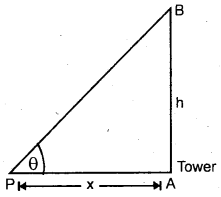
Question 3. What are the uses of dimensional analysis? Explain each of them. Answer: Dimensional analysis is used for: (a) checking the dimensional correctness of the given physical equation or relation. (b) converting one system of units to another system. (c) deriving the relationship between various physical quantities.
(a) checking of the dimensional correctness of a physical relationship is done by using the principle of homogeneity of dimensions. If the dimensions of M, L, T of each term on R.H.S. are equal to the dimensions of M, L, T of each term on L.H.S., then the given- physical relation is dimensionally correct, otherwise wrong.
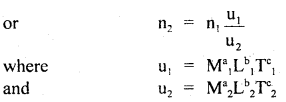
(c) Derivation of a relationship between various physical quantities is based on the principle of homogeneity of dimensions.
Following are the steps used:
- We must Know the physical quantities (say p, q, r) upon which a physical quantity say x depends.
- We must know the dimensions of p, q, r say a, b, c respectively.

- Now, write the dimensions of each physical quantity on both sides of the equation
- and compare the powers of M, L, T to find a, b, c. Putting values of a, b, c in the equation
- we get the required relation.
Numerical Problems:
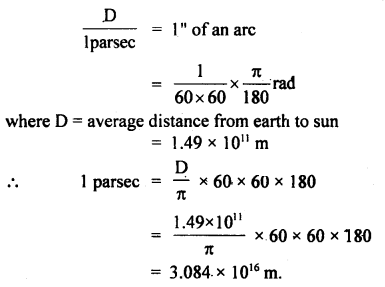
Question 4. Find the number of air molecules in a room of volume 12 m 3 . Given 1 mole of air at N.T.P. occupies a volume of 22.4 liters. Answer: No. of atoms in I mole of air = N = 6.023 × 10 23
∴ Also at N.T.P., 1 mole of air occupies 22.4 liters of volume = 22.4 × 10 -3 m 3
∴ No. of molectiles ir 22.4 × 10 -3 m 3 volume = 6.023 × 10 23 ∴ No. of molecules in 12 m 3 volume = \(\frac{6.023 \times 10^{23}}{22.4 \times 10^{-3}}\) × 12 = 3.23 × 10 26
Question 5. (a) Convert ION into dyne using dimensional analysis. Answer: Newton (N) and dyne are the S.I. and C.G.S. units of force having dimensional formula [MLT -2 ] ∴ a = 1, b = 1, c = – 2
S.I. system n 1 = 10 M 1 = 1 kg L 1 = 1 m T 1 = 1 s
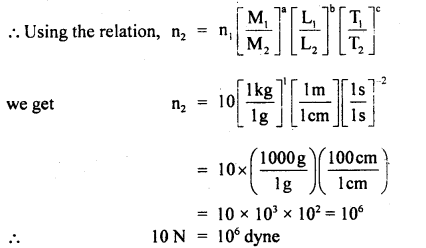
Question 6. Check the dimensional correctnesïof the relation V = \(\sqrt{\frac{2 G M}{R}}\) Answer: It is done using the principle of homogeneity of dimensions i.e. if the dimensions of each term of both sides of the equation are the same, Then it is dimensionally correct. Now dimensions of V = [LT -1 ]. G = [M -1 L 3 T 2 ] M = [M] R = [L]
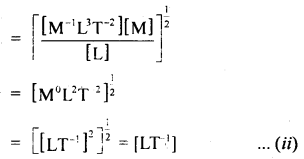
Now from equations (i) and (ii), it is clear that the dimensions of L.H.S = R.H.S, so the given relation is dimensionally correct.
Question 7. Suppose that the oscillatións of a simple pendulum depend on (i) mass of the bob (m), (ii) length of the string (1), (iii) acceleration due to gravity (g) and (iv) angular displacement (iv) Dimensionally show which of the above factors here an influence upon the period and in what way? Answer: Let t ∝ m a l b g c θ d or t = k’ m a l b g c q d ….(i) here k’ is a dimensionless constant.
Since q is dimensionless, hence equation (i) reduces to t = K m a l b g c …(ii)
where K. = k 1 .θ d is another dimensionless constant. Now writing the dimensional formula of each physical quantity on both sides of equation (ii), we get [M 0 L 0 T -1 ] = [M] a [L] b [LT 2 ] c = [M a L b-c T -2c ]
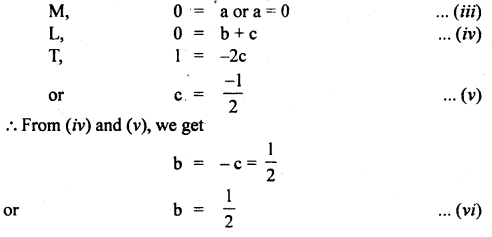
Question 8. Given that the period T of oscillation of a gas bubble from an explosion underwater depends on P, d, and E, where the symbols are pressure, density, and total energy of the explosion. Find dimensionally a relation for T. Answer: Let T ∝p a d b E c or T = k p a d b E c …(i) where k is a dimensionless constant.
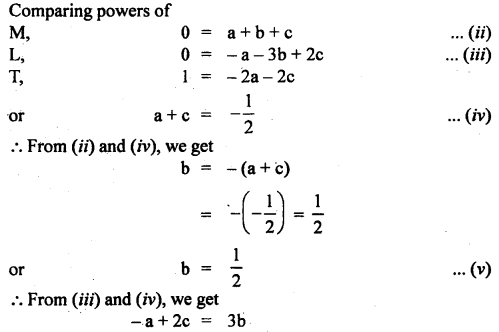
Writing dimensions of each physical quantity on both sides of equation (i), we get [M 1 L 0 T 0 ] = [LT -1 ] [ML -3 ] b [LT -2 ] c [M b L a-3b+2c T -a-2c ]
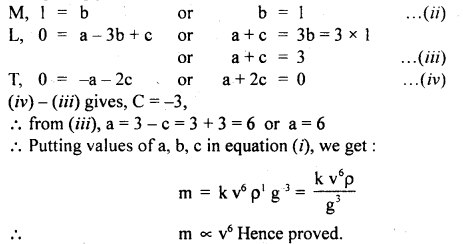
Hence, M = 5.97 × 10 24 kg.
Question 12. The length, breadth, and thickness of a block of metal were measured with the help of Vernier Callipers. The measurements are: l = (5.250 ± 0.001) cm b = (3.450 ± 0.001) cm, t = (1.740 ± 0.001) cm. Find the percentage error in the volume of the block. Answer: The volume of the block is given by: V = lbt
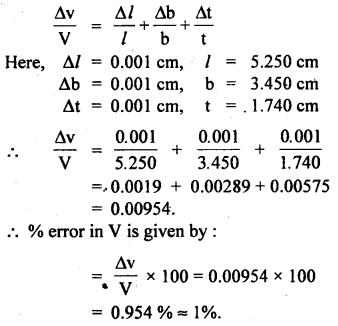
Question 14. The radius of the proton is about 10 -9 microns and the radius of the universe is about 10 28 cm. Name a physical object whose size is approximately halfway between these two extremes on the logarithmic scale. Answer: Radius of proton, x 1 = 10 -9 microns = 10 -9 × 10 6 m . = 10 -15 m
Radius of universe, x 2 = 10 28 cm = 10 26 m.
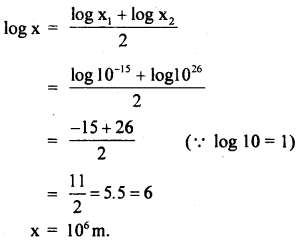
Question 15. The velocity v (cms -1 ) of a particle is given in terms of time t (s) by the equation y = at + \(\frac{b}{t+c}\). What are the dimensions of a, b and c? Answer: v = at + \(\frac{b}{t+c}\).
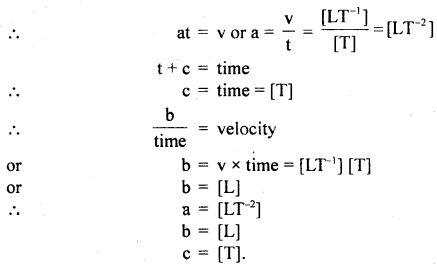
The total percentage error in this result is: \(\frac{19 \times 11.5}{100}\) = 2.2
So, the result of Y can be quoted as (19 ± 2.2) × 10 11 dyne cm -2
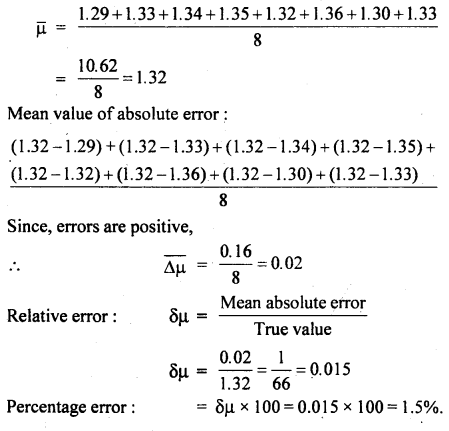
Question 18. Derive the dimensions of a/b in the relation: F = a\(\sqrt{x}\) + bt 2 where F is the force, x is the distance and t is the time. Answer: Here, F= a\(\sqrt{x}\) + bt 2 …(i)
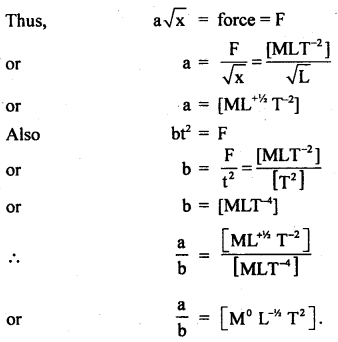
Question 19. Calculate the number of seconds in a: (i) day (ii) year and express them in orders of magnitude. Answer: (i) No.of seconds in a day = 24 × 60 × 60s = 86400s = 8.64 × 104s = 0.864 × 105s ∴ order of magnitude = 5
(ii) No.of seconds in a year = 365 days = 365 × 0.864 × 105s = 315360 × 105s = 31536 × 107s ∴ order of magnitude = 7.
Question 20. A stone is lying in a fluid stream. The force F acting on it depends on the density of the fluid δ, the velocity of flow v, and the maximum area of cross-section A perpendicular to the direction of flow. Find the relation between the force F and the velocity v. Answer: Let, F ∝ ρ a ∝ v b ∝ A c or F ∝ p a v b A c or F = k p a v b A c …(i)
Now writing the dimensional formula of each physical quantity on both sides of equation (i), we get: [MLT -2 ] = [ML -3 ] a [LT -1 ] b [L 2 ] c = [M a L -3a+b+2c T -b ] …(ii)
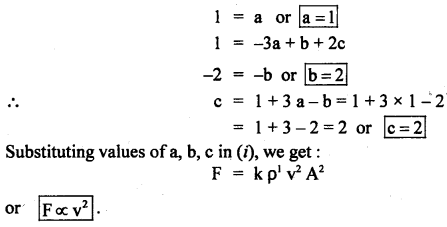
Question 24. If S 2 = a t 4 , where S is in meters, t in second, then find the unit of a. Answer: Here, S 2 = a t 4 According to the principal of homogeneity of dimensions, at 4 = m 2 ∴ a = \(\frac{\mathrm{m}^{2}}{\mathrm{t}^{4}}\) = m 2 s -4
Question 25. Calculate the value of 600m. + 600mm with due regard to the significant digits. Answer: Here, because there is no significant digit after the decimal point in 600m, so 600m + 600mm. = 600m + 600 × 10 -3 m = 600m + 0.600m = 600.6m = 601m.
Value-Based Type:
Question 1. The teacher of class XI asked Madan and Prathiva to find the distance of the moon from the Earth. Pratibha said it is impossible to find. But Madan was excited to know. He observed the moon from two diametrically opposite points A and B on Earth. The angle q subtended at the moon by the two directions of observation is 1°54′. Given the diameter of the Earth to be about (1.276 × 10 7 m). (i) Which values arc depicted by Madan? Answer: The values depicted by Madan are : (a) Curiosity (b) Sincerity (c) Willing to know and implement the scientific ideas.
(ii) Which mathematical concept is used in the above problem? Answer: Parallax method
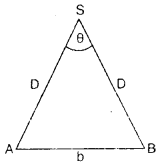
Question 2. Muesli went to London to his uncle who is a doctor over there. He found that the currency is quite different from India. He could not understand the pound and how it is converted into rupees. He asked an English man that how far is central London from here.
He replied that it is about 20 miles. Mukesh was again confused as he never used these units in India. When his uncle came back from his clinic he curiously inquired all about it. His uncle told him about the unit system used in England. He explained that here F.P.S system is used.
It means distance is measured in the foot, Mass in the pound, and time in seconds. But in India, it is an MKS system. (i) What values are depicted by Mukesh? Answer: (a) Curiosity (b) Willing to know (c) Intelligence
(ii) How many types of unit systems are there? Answer: The unit system is: (a) CGS (centimeter, gram and second) system (b) FPS (foot, pound and second) system (c) MKS (meter, kilogram, and second) system
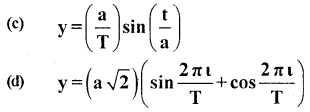
Sachin told that he has no idea whereas Dinesh ruled out the wrong formulas on dimensional grounds. (i) which values are displayed by Dinesh? Answer: the values displayed by Dinesh are: (a) Sincerity (b) Curiosity (c) application of knowledge
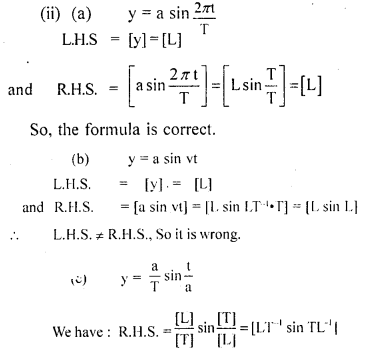
CBSE Expert
CBSE Class 11 Physics Units and Measurements MCQ with Answers PDF
CBSE MCQ Questions for Class 11 Physics Chapter 2 Units and Measurements with Answers Pdf free download. MCQ Questions for Class 11 Physics with Answers were prepared based on the latest exam pattern. This MCQ will help you score good marks in the final exam. Units and Measurements Class 11 Physics MCQs are prepared for a better understanding of the concept. Units and Measurements Class 11 Physics MCQ is prepared by Experts of CBSE.

Class 11 Physics Chapter 2 Units and Measurements MCQs
Check the multiple-choice questions for the 11th Class Physics Chapter 2 Units and Measurements. Select one answer out of 4 options.
The density of a material in SI units is 128 kg m -3 . In certain units in which the unit of length is 25 cm and the unit of mass is 50 g, the numerical value of density of the material is (a) 40 (b) 16 (c) 640 (d) 410
Answer: (a) 40
The damping force on an oscillator is directly proportional to the velocity. The unit of the constant of proportionality is (a) kg-ms -1 (b) kg-ms -2 (c) kgs -1 (d) kg-s
Answer: (c) kgs-1
Amongst the following options, which is a unit of time? (a) Light year (b) Parsec (c) Year (d) None of these
Answer: (c) Year
Which of the following measurement is most precise? (a) 5.00 mm (b) 5.00 cm (c) 5.00 m (d) 5.00 km
Answer: (a) 5.00 mm
The moon is observed from two diametrically opposite points A and B on earth. The angle θ subtended at the moon by the two directions of observation is 1°54′; given that the diameter of the earth to be about 1.276×10 7 m. Compute the distance of the moon from the earth. (a) 4.5x 10 9 m (b) 3.83 x10 8 m (c) 2.5 x 10 4 m (d) 4 x10 7 m
Answer: (b) 3.83 x108 m
The electrostatic force between the metal plates of an isolated parallel plate capacitor C having a charge Q and area A, is
(a) proportional to the square root of the distance between the plates. (b) linearly proportional to the distance between the plates. (c) independent of the distance between the plates. (d) inversely proportional to the distance between the plates.
Answer: (c) independent of the distance between the plates
Equipotentials at a great distance from a collection of charges whose total sum is not zero are approximately
(a) spheres (b) planes (c) paraboloids (d) ellipsoids
Answer: (a) spheres
The most suitable instrument for measuring the size of an atom is
(a) Electron microscope (b) Vernier calliper (c) Optical Microscope (d) Screw gauge
Answer: (a) Electron microscope
Which of the following is not the unit of energy?
(a) watt-hour (b) electron-volt (c) N × m (d) kg × m/sec2
Answer: (d) kg × m/sec2
A particle starting from the origin (0, 0) moves in a straight line in the (x, y) plane. Its coordinates at a later time are the path of the particle makes with the x-axis an angle of
(a) 300 (b) 450 (c) 600 (d) 0
Answer: (c) 600
Which one of the following pairs of quantities and their units is a proper match?
(a) Magnetic flux – weber (b) Capacitance – henry (c) Impulse – N/sec (d) Power – farad
Answer: (a) Magnetic flux – weber

Two physical quantities whose dimensions are not same, cannot be :
(a) multiplied with each other (b) divided (c) added or substracted in the same expression (d) added together
Answer: (c) added or substracted in the same expression
In an experiment the angles are required to be measured using an instrument. 29 divisions of the main scale exactly coincide with the 30 divisions of the vernier scale. If the smallest division of the main scale is half-a-degree (= 0.5°), then the least count of the instrument is
(a) One minute (b) Half minute (c) One degree (d) Half degree
Answer: (a) One minute
Absolute error of the measurement is
(a) the difference between the individual measurement and the true value of the quantity cubed. (b) the difference between the individual measurement and the true value of the quantity squared. (c) the difference between two individual measurements and their mean (d) the difference between the individual measurement and the true value of the quantity
Answer: (a) the difference between the individual measurement and the true value of the quantity cubed
One second is defined to be equal to
(a) 9192631770 periods of the cesium clock (b) 1650763.73 periods of the cesium clock (c) 652189.63 periods of the krypton clock (d) 1650763.73 periods of the krypton clock
Answer: (a) 9192631770 periods of the cesium clock
A student measures the distance covered and time taken by a body under free fall which was intially at rest. He uses this data for estimating g, the acceleration due to gravity. If the maximum percentage error in measurement of the distance and the time are e1 and e2 respectively, then the maximum possible percentage error in the estimation of g is
(a) e2 – e2 (b) e2 + 2e2 (c) e2 + e2 (d) e2 – 2e2
Answer: (b) e2 + 2e2
The atmospheric pressure is 106 dyne/cm². What is its value in SI unit? (a) 105 newton/m² (b) 106 newton/m² (c) 104 newton/m² (d) 103 newton/m²
Answer: (a) 105 newton/m²
If force (F), work (W) and velocity (v) are taken as fundamental quantities. What is the dimensional formula of time (T)? (a) [WFv] (b) [WFv -1 ] (c) [W -1 F -1 v] (d) [WF -1 v -1 ]
Answer: (d) [WF-1v -1]
The volume of a cube in m³ is equal to the surface area of the cube in m². The volume of the cube is (a) 64 m³ (b) 216 m³ (c) 512 m³ (d) 196 m³
Answer: (b) 216 m³
Which of the following units denotes the dimensions [ML 2 /Q 2 ], where Q represents the electric charge? (a) Wb/m² (b) Henry(H) (c) H/m² (d) Weber(Wb)
Answer: (b) Henry(H)
What is the dimensional formula of magnetic field? (a) MT -2 A -1 (b) MT -1 A -2 (c) M -1 L -2 TA -1 (d) M -1 LTA -2
Answer: (a) MT-2A-1
Hope these MCQs help you in your preparation for your final exams. Leave your comment below, if you have any questions regarding Class 11 Physics Chapter 2 Units and Measurements MCQ with Answers .
Leave a Comment Cancel reply
Save my name, email, and website in this browser for the next time I comment.
Download India's best Exam Preparation App Now.
Key Features
- Revision Notes
- Important Questions
- Previous Years Questions
- Case-Based Questions
- Assertion and Reason Questions
No thanks, I’m not interested!
- Units And Dimensions
- Measurement And Units
- Active page
Units And Dimensions of Class 11
Physical quantity.
Any meaningful term which can be measured is a physical quantity. For example length, velocity, time etc. are physical quantity. But handsomeness, beauty are not physical quantity. Why measurement is needed?: Physics is an experimental science and experiments involve measurement of different physical quantities in which laws of physics are expressed. Without measuring results of experiments, it would not be possible for scientists to communicate their results to one another or to compare the results of experiments from different laboratories.
Units of Measurement
To measure a physical quantity we need some standard unit of that quantity. For example, if a measurement of length is quoted as 5 meters, it means that the measured length is 5 times as long as the value accepted for a standard length defined to be “one meter”.
Any set of standards of units must fulfill the following two conditions
- It must be accessible.
- It must be invariable with the passage of time
Two more auxiliary conditions
- It is necessary to have wide unlimited agreement about those standards.
- It is inter convertible to different units of same quantity.
A measurement consists of two parts, one is numeric and the other is standard chosen. For example, 5 meter of length implies 5 times the “standard meter”. It is not necessary to establish a measurement standard for every physical quantity. Some quantities can be regarded as fundamental and the standard for other quantities can be derived from the fundamental ones. For example, in mechanics length, mass and time are regarded as fundamental quantities and the standard for speed (= length / time) can be derived from fundamental quantities length and time.
| Time | second | s |
| Length | meter | m |
| Mass | kilogram | kg |
| Amount of Substance | mole | mol |
| Thermodynamic Temp. | kelvin | K |
| Electric Current | ampere | A |
| Luminous Intensity | candela | Cd |
Two Supplementary Units
| Solid Angle | Steradian | sr |
- Two other system of units compete with the international system- One is Gaussian System in terms of which much of the literature of physics is expressed. In India this system is not in use.
- The other is the British system- This system is still in daily use in United states and United Kingdom. But SI units are standard units worldwide.
- C.G.S. Unit- In this system of unit, centimeter, gram and seconds are units of length, mass and time respectively.
- Conversion of One System of Units to another System- The basic formula is n 1 u 1 = n 2 u 2 where n 1 and n 2 are numbers.
Q1. How many dyne−centimeter are equal to 1 N −m ?
Ans. 1N -m = (1 kg)(1m 2 ) (1s -2 )
1 dyne - centimeter = (1kg)(1cm 2 )(1 s -2 )
1N -M / 1 dyne -cm = (1000g/1g)(100cm 2 / 1cm)
= 1000 x 10000
1N -m = 107 dyne -cm
Measurement of Length
Depending upon the range of length, there are three main methods for measuring length:
Direct method
Indirect or mathematical method.
- Chemical Mehtod
The simplest method measuring the length of a straight line is by means of a meter scale. But there exist some limitations in the accuracy of the result:
- The dividing lines have a finite thickness.
- Naked eye cannot correctly estimate less than 0.5 mm
For greater accuracy devices like
- Vernier calliper
- micrometer scale (screw gauge)
Vernier Calliper
It consists of a main scale graduated in cm/mm over which an auxiliary scale (or Vernier scale) can slide along the length. The division of the Vernier scale being slightly shorter than the divisions of the main scale.
Vernier Calliper Least count
The least count or the Vernier constant (V.C.) is the minimum value of correct estimation of length without eye estimation. The difference between the values of one main scale division and one vernier scale division is known as vernier constant if N division of vernier scale coincides with (N−1) divisions of main scale, then vernier constant,
n.V.S.D. = (n −1 ) M.S.D.
1.V.S.D. = (n -1 / n) M.S.D., then
LC = 1.M.S.D. − 1.V.S.D. = 1.M.S.D. (n -1 / n) M.S.D.
=1/n M.S.D.
Vernier Calliper Least Count Formula = Smallest Division on main scale / No. of division on vernier scale
Vernier Calliper Reading
Let one main scale division be 1 mm and 10 vernier scale divisions coincide with 9 main scale divisions
1.V.S.D. = 9/10 M.S.D.=0.9 mm
Vernier constant = 1.M.S.D − 1.V.S.D. = 1 mm − 0.9 mm
= 0.1 mm = 0.01 cm
The reading with vernier scale is read as given below :
- Firstly take the main scale reading (N) before on the left of the zero of the vernier scale.
- Find the number (n) of vernier division which just coincides with any of the main scale division. Multiply this number (n) with vernier constant (V.C.)
- Total reading = (N + n × V.C.)
Caution: The main scale reading with which the Vernier scale division coincides has no connection with reading
Suppose If we have to measure a length AB, the end A is coincided with the zero of the vernier scale as shown in fig. Its enlarged view is given in fig.
1.0 cm < Length AB < 1.1. cm

Let 5th division of vernier scale coincide with 1.6 cm of main scale. From diagram it is clear that the distance between 4th division of vernier scale and 1.5 cm of main scale is equal to one V.C. and distance between zero mark of vernier scale and 1.0 cm mark on the main scale is equal to 5 times the vernier constant.
AB = 1.0 + 5 × L.C. = 1.0 + 5 × 0.01 = 1.05 cm.
Q2. In travelling microscope the vernier scale used has the following data. 1 M.S.D. = 0.5 mm, 50 V.S.D. = 49 M.S.D. and the actual reading for distance travelled by travelling microscope is 2.4 cm with 8th division coinciding with a main scale graduation . Estimate the distance travelled.
Ans. In this case vernier constant = 1.M.S.D. − 1.V.S.D.
= 1.M.S.D. − 49/50 M.S.D.
= 1/50 M.S.D
=1/50 x 0.5 mm
= 5/10 x 1/50 = 0.01mm = 0.001cm
Distance travelled = 2.4 + 8 × 0.001 cm
Q3. The Vernier scale used in Fortin’s barometer has 20 divisions coinciding with the 19 main scale divisions. If the height of the mercury level measured is 5 mm and 15th division of vernier scale is coinciding with the main scale division. Then calculate the exact height of the mercury level (given that 1.M.S.D. = 1mm)
Ans. 20 V.S.D. = 19 M.S.D. (Given)
1.V.S.D. = 19/20 M.S.D
V.C. = 1. M.S.D. − 1.V.S.D = (1 - 19/20M.S.D.)
= 1/20 M.S.D.
= 1/20 x 1 mm
Height of mercury level = 5 + 0.05 × 15
If the zero marking of main scale and Vernier scale do not coincide, necessary correction has to be made for this error which is known as zero error of the instrument. If the zero of the vernier scale is to the right of the zero of the main scale the zero error is said to be positive and the correction will be negative and vice versa.
Q1. Consider the following data:
10 main scale divisions = 1cm, 10 vernier division = 9 main scale divisions, zero of Vernier scale is to the right of the zero marking of the main scale with 6th Vernier division coinciding with a main scale division and the actual reading for length measurement is 4.3 cm with 2nd Vernier divisions coinciding with a main scale graduation. Estimate the length.
Ans. In this case, vernier constant = 1mm/100
Zero error = 6 × 0.1 = + 0.6 mm
Correction = −0.6 mm
Actual length = (4.3 + 2 × 0.01) + correction
= 4.32 − 0.06 = 4.26 cm.
Screw Gauge (or Micrometer Screw)
In general Vernier Callipers can measure accurately upto 0.02 mm and for greater accuracy micrometer screw devices, e.g. screw gauge, spherometer are used. These consist of accurately cut screw which can be moved in a closely fitting fixed nut by turning it axially. The instrument is provided with two scales:
- The main scale or pitch scale M graduated along the axis of the screw.
- The cap−scale or head scale H round the edge of the screw head.

Constants of the screw gauge
- Pitch: The translational motion of the screw is directly proportional to the total rotation of the head. The pitch of the instrument is the distance between two consecutive threads of the screw which is equal to the distance moved by the screw due to one complete rotation of the cap. Thus if 10 rotations of cap ≡5 mm, then pitch = 0.5 mm
In general, pitch = Distance travelled by screw on main scale / No. of rotation taken by the cap to travel that much distance
- Least count: In this case also, the minimum (or least) measurement (or count) of length is equal to one division on the main scale which is equal to pitch divided by the total cap divisions. Thus in the aforesaid Illustration, if the total cap division is 100, then least count = 0.5 mm/100
In general, In case of circular scale,
Least count = Pitch / Number of division on circular scale
If pitch is 1 mm and there are 100 divisions on circular scale, then
Least count = 1mm/100 = 0.01 mm = 0.001 cm
= 0.00001 m = 10−5 m = 10 μm
Since least count is of the order of 10 μm, So the screw is called a micrometer screw. Screw gauge and the spherometer which work on the principle of micrometer screw, consist essentially of the following two scales.
- Linear or Pitch scale: It is a scale running parallel to the axis of the screw.
- Circular of Head scale: It is marked on the circumference of the circular disc or the cap attached to the screw.
- Zero Error: In a perfect instrument the zero of the head scale coincides with the line of graduation along the screw axis with no zero−error, otherwise the instrument is said to have zero−error which is equal to the cap reading with the gap closed. This error is positive when zero line or reference line of the cap lies below the line of graduation and vice−versa. The corresponding corrections will be just opposite.
Q1. A screw gauge has 100 divisions on its circular scale. Circular scale travels one division on linear scale in one rotation and 10 divisions on linear scale of screw gauge is equal to 5 mm. What is the least count of a screw gauge.
Ans. Pitch = 1 division on linear scale / 1 rotation = 1 div
10 division = 5 mm
1 division = 0.5 mm
pitch = 0.5 mm
least count = Pitch / No. of divisions on circular scale
= 0.5 mm /100
Q2. The screw gauge mentioned in above illustration is used to measure thickness of a coin. The reading of the linear scale is 4th div and 25th division of circular scale is coinciding with it. What is the value of thickness of the coin.
Ans. Reading = Linear scale Reading + Least count × circular scale reading
= 4th division on linear scale + 0.005 mm × 25
= 4 × 0.5 mm + 0.125 mm
= 2 mm + 0.125 mm
Q3. A spherometer has 250 equal divisions marked along the periphery of its disc and one full rotation of the disc advances it on the main scale by 0.0625 cm. The least count of the spherometer is
(A) 2.5x10 −2 cm
(B) 25 x10 −3 cm
(C) 2.5x10 −4 cm
(D) none of the above
Ans. Correct option is (C)
Least count = 0.0625/250 cm = 2.5 x 10 −4 cm
This method involves measurement of long distances. Main methods of this category are −
Reflection method: Suppose we want to measure the distance of a multi story building from a destination point P. If a shot be fired from P, the sound of shot travels a distance x towards the building, gets reflected from the building. The reflected sound travels the distance x to the point of P, when an echo of the shot is heard.
Let t = time interval between the firing of the shot and echo sound.
v = velocity of sound in air.
Distance = velocity x time
x + x = (v) (t)
⇒ x = (v) (t/2)
As v is known, x can be calculated by measuring the time t.
Q8. A rock is at the bottom of a very deep river. An ultrasonic signal is sent towards rock and received back after reflection from rock in 4 seconds. If the velocity of ultrasonic wave in water is 1.45 km/s, find the depth of river.
Ans. Here x = ?
v = 1.45 km/s = 1450 m/sec.
so, x = v x t / 2 = 1450 x 4 / 2 = 2900 m.
- Parallel method: This method is used for measuring the distance of nearby stars. If we have to measure the distance D of a faraway star S by this method. We observe this star from two different positions A and B on the earth, separated by a distance AB = b at the same time as shown in the figure. Let ∠ASB =θ, the angle θ is called parallatic angle. As the star is very far away, b/D << 1 and θ is very small.

Here we can take AB as an arc of length b of a circle with center at S and the distance D as the radius AS=BS so that AB = b = Dθ where θ is in radians.
D = b/θ
Knowing b and measuring θ, we can calculate D.
- Copernicus method: This method is used to measure the relative distances of the planets from the Sun.
- For Interior Planets: The angle formed at earth between the earth−planet direction and the earth−sun direction is called the planet’s elongation. This is the angular distance of the planet from the sun as observed from earth. When the elongation attains its maximum value ε as in the figure, the planet appears farthest from Sun.

- For Exterior Planets: This method is a consequence of Kepler’s 3rd law of planetary motion. For two planets P 1 and P 2 we have,
a 3 2 / a 3 1 = T 2 2 / T 2 1
where a 1 and a 2 are semi−major axes, of respective orbits. The period can be ascertained by direct observation. Therefore if a 1 is measured, a 2 can be calculated.
Chemical Method
This method is used to measure the distance of the order of 10−10 m. Let us calculate the size of an atom.
Let m = mass of substance,
V = volume occupied by substance &
ρ = density of the substance
v = m /ρ (1)
Let M be the atomic weight of the substance and N be the Avogadro number.
No. of atoms in mass m of the substance = Nm / M
If r = radius of each atom then V = volume of each atom = 4/3 πr 3
Volume of all the atoms in substance = (4/3 πr 3 x Nm)/M.
According to Avagordo’s hypothesis,
Volume of all the atoms = (2/3) x volume of substance
4/3 πr 3 x Nm/M = (2/3) m/ρ
r = (M/2πNρ) 1/3
Frequently Asked Question (FAQs)
Q1. What is Vernier Calliper?
Ans. A measuring device is used for the measurement of linear dimensions. It is also used to measure the diameters of round objects with the help of the measuring jaws.
Q2. What is the least count of Vernier callipers?
Ans. The zero mark of the Vernier scale has gone seven-tenths of a millimeter past the 11.0 mm mark, giving a total reading of 11.7 mm. The least count of the Vernier caliper is 0.1 mm. 0.1 mm is the smallest scale reading that can be made without estimation.
Q3. What is the atomic mass unit (AMU) of 1 Å?
Ans. 1 A.U. = 1.496 × 10 11 m and 1 Å = 10 10 m.
Q4. Are S.I. units Coherent? Why?
Ans. Yes, because all the derived units in this system can be obtained by multiplying or dividing a certain set of basic units.
- Introduction
- Scope And Excitement Of Physics
- Technology And Society
- Fundamental Forces In Nature
- Conservation Laws
- Measurement Of Mass
- Errors In Measurement
- Physical Quantities

Talk to Our counsellor


- Test Series
- Competitive Exams
Latest Articles
NCERT Solutions for Class 11 Physics Chapter 2
Ncert solutions for class 11 physics chapter 2 - units and measurement.
Question 2.1 Fill in the blanks (a) The volume of a cube of side 1cm is equal to__________\(m^3\). (b) The surface area of a solid cylinder of radius 2.0 cm and height 10.0 cm is equal to_________\(mm^2\). (c) A vehicle moving with a speed of 18km \(h^{-1}\) cover_______\(m\) in \(1s\). (d) The relative density of lead is 11.3. Its density is_______\(gm cm^{-3}\) or ________ \(kgm^{-3}\). Solution : (a) As we know that $1 cm = \frac {1}{100} m = 10^{-2}m$ \[ Length,L=1cm=10^{-2}m,\\ \therefore \, Volume, \, L^3=\left( 10^{-2} \right) ^3=10^{-6}m^3 \] (b) As we know that $1 cm = 10 mm $ \[ r=2cm=20mm, \, h=10cm=100mm\\ \text{surface area of solid cylinder}=\left( 2\pi r \right) h +2 \pi r^2\\ =2\times \frac{22}{7}\times 20\times 100 + 2 \times \frac{22}{7} \times 20 \times 20=1.5\times 10^{4}mm^2 \] (c) As we know that $1 km = 1000 m $ and $ 1 hour = 3600 s$ \[ Speed, \, v=18kmh^{-1}=\frac{18 \times 1000}{60 \times 60} = 5 m/s\\ \therefore \text{Distance covered in 1s}=5m\\ \] (d) Relative Density = 11.3 Now density of water = 1 gm/cm 3 So, Density of Lead will be = 11.2 gm/m 3 Now we know that $ 1g = \frac {1}{1000} kg = 10^{-3} kg $ and $ 1 cm = \frac {1}{100} m =10^{-2} m$ So density in kg/m 3 can be expressed as \[ density=11.3\, g/cm^3=\frac{11.3 \times 10^{-3}kg}{\left( 10^{-2}m \right) ^3}\\ =11.3\times 10^3kgm^{-3}.\]
Question 2.2 Fill in the blank by suitable conversion of units: (a) \(1kgm^2s^{-2}=\_\_\_\_\_\_gcm^2s^{-2}\) (b) \(1m=\_\_\_\_\_\_\_light\,\,year\) (c) \(3ms^{-2}=\_\_\_\_\_\_\_kmh^{-2}\) (d) \(G=6.67\times 10^{-11}Nm^2kg^{-2}=\_\_\_\_\_cm^3s^{-2}g^{-1}\,\) Solution: These type of question can be simply solved by putting the respective conversion units in the place (a) \(1kgm^2s^{-2}=1\times 10^3g\left( 10^2cm \right) ^2s^{-2}=10^7gcm^2s^{-2}\) (b) Now we know that distance traveled by light in 1 year is called 1 light year Speed of light = $ 3 \times 10^8$ m/s and $1\,\, year =365 \times 24 \times 60 \times 60$ s So 1 light year = $3 \times 10^8 \times 365 \times 24 \times 60 \times 60 $ m \( 1\,\,light\,\,year=9.46\times 10^{15}m\) \( \therefore 1m=\frac{1}{9.46\times 10^{15}}=1.053 \times 10^{-16}light\,\,year\) (c) \begin{align*} 3ms^{-2} &=3 \times 10^{-3}km\left[ \frac{1}{60 \times 60}h \right] ^{-2}\\ & =3 \times 10^{-3} \times 3600 \times 3600\,\,kmh^{-2}\\ & =3.888 \times 10^{4}kmh^{-2} \end{align*} (d) \begin{align*} G & =6.67 \times 10^{-11}Nm^2\,kg^{-2}\\ & =6.67 \times 10^{-11}\left( kgms^{-2} \right) m^2kg^{-2}\\ & =6.67 \times 10^{-11}m^3s^{-2}kg^{-1}\\ & =6.67 \times 10^{-11} \times 10^6cm^3s^{-2}10^{-1}g^{-1}\\ & =6.67 \times 10^{-8}cm^3s^{-2}g^{-1} \end{align*}
Question 2.3 A calorie is a unit or energy and it equals about \(4.2J\), where \(1J=1kgm^2s^{-2}\). Suppose, we employ a system of units in which the unit of mass equals \(\alpha\, kg\), the unit of length equals \(\beta \, m\) and the unit of time is \(\gamma \, s\). Show that a calorie has a magnitude of 4.2 \(\alpha ^{-1}\beta ^{-2}\gamma ^2\) in terms of new units. Solution: Given, \( 1 \, calorie = 4.2J = 4.2 \,kg m^2s^{-2}\) If \(\alpha \) kg = new unit of mass Then, \( 1kg=\frac{1}{\alpha}\) is the new unit of mass Similarly, \(1m=\beta ^{-1}\) is the new unit of length \(1s=\gamma ^{-1}\) new unit of time Now, \( 1 \, calorie =4.2 \alpha ^{-1} (\beta ^{-1})^{-2}(\gamma ^{-1})^{-2}\) unit of energy or $1 \; calorie = 4.2 \alpha ^{-1} \beta ^{-2} \gamma ^{2}$ unit of energy where, \( \alpha ^{-1}\) is new unit of mass \( \beta ^{-1} \) new unit of length and \( \gamma ^{-1}\) new unit of time
Question 2.4. Explain this statement clearly : "To call a dimensional quantity 'large' or 'small' is meaningless without specifying a standard for comparison." In view of this, reframe the following statements wherever necessary: (a) atoms are very small objects (b) a jet plane moves with great speed (c) the mass of Jupiter is very large (d) the air inside this room contains a large number of molecules (e) a proton is much more massive than an electron (f) the speed of sound is much smaller than the speed of light. Solution Physical quantities are called large or small depending on the unit (standard) of measurement. For example the unit of parsec is equal to $3.08 \times 10^{16} m$ which is certainly very bigger than km or m.So we used these type of unit when we have to measure distance between the stars (a) The size of an atom is much smaller than even the sharp tip of a pin. (b) A jet plane moves with a speed greater than that of a superfast train. (c) The mass of Jupiter is very large compared to that of the earth. (d) The air inside this room contains more number of molecules than in one mole of air. (e) This is already a correct statement.We don't require any change (f) This is already a correct statement.We don't require any change
Question 2.5 A new unit of length is chosen such that the speed of light in vacuum is unity. What is the distance between the sun and the earth in terms of the new unit, if light takes 8 min and 20 sec to cover this distance? Solution Velocity of light = c = 1 new unit of length \(s^{-1}\) Time taken by light of sun to reach the earth is \(t = 8\, min\, 20 s = (8\times 60)+20=500 s\) Distance between the sun and earth, \(x = c \times t = 1 \text{ new unit of length}=500\text{ new units of length}\) .
Question 2.6 Which of the following is the most precise device for measuring length ? (a) a Vernier callipers with 20 divisions on the sliding scale (b) a screw gauge of pitch 1 mm and 100 divisions on the circular scale (c) an optical instrument that can measure length within a wavelength of light ? Solution. (a) We need to first calculate the least count of each of these device. Least count of Vernier callipers = 1 SD - 1 VD \begin{align*} \text{least count } &= 1SD - \frac{19}{20}SD = \frac{1}{20}SD =\frac{1}{20}mm\\ &=0.005cm \end{align*} (b) Least count of screw gauge \[=\frac{pitch}{\text{no. of division on circular scale}}\\ \frac{1}{100}mm=0.001 cm \] (c) Wavelength of light is of the order of, \(\lambda =10^{-5}cm=0.00001cm\) Since most precise device should have minimum least count, optical instrument is the most precise one.
Question 2.7 A student measures the thickness of a human hair by looking at it through a microscope of magnification 100. He makes 20 observations and finds that the average width of the hair in the field of view of the microscope is 3.5 mm. What is his estimate on the thickness of hair? Solution: \begin{align*} Magnification(m)=\frac{\text{observed width}\left( y \right)}{\text{real width}\left( x \right)}\\ \therefore x=\frac{y}{m}=\frac{3.5}{100}=0.035mm \end{align*}
Question 2.8 Answer the following : (a) You are given a thread and a meter scale. How will you estimate the diameter of the thread? (b) A screw gauge has a pitch of 1.0 mm and 200 divisions on the circular scale. Do you think it is possible to increase the accuracy of the screw gauge arbitrarily by increasing the number of divisions on the circular scale? (c) The mean diameter of a thin brass rod is to be measured by Vernier callipers. Why is a set of 100 measurements of the diameter expected to yield a more reliable estimate than a set of 5 measurements only? Solution. (a) Meter scale can not measure small diameter of thread. But it can be found by wrapping the thread number of times on on round pencil so as to form a coil having it turns touching each other . Now diameter can be found be measuring the length of the coil using meter scale and counting the turns as below Let \(l\) is measured length of coil on the scale which contains \(n\) number of turns. \[\therefore \text{Diameter of thread }=\frac{l}{n}\] (b) \[Least \, count =\frac{pitch}{\text{number of division in circular scale}}\] i.e. least count decreased when no. of division on the circular scale increases. Thereby accuracy would increase. But practically speaking , it is impossible to take precise reading due to low resolution of human eye. (c) The random errors are those errors, which occur irregularly and hence are random with respect to sign and size. Large no. of observations (say 100) gives more reliable result, because probability of making random error in positive side of a physical quantity would be same that of in negative side. Therefore, when no. of observations is large random errors would cancel each other and hence result would be reliable.
Question 2.9 The photograph of a house occupies an area of \(1.75cm^2\) on a 35 mm slide. The slide is projected on to a screen, and the area of the house on the screen is \(1.55m^2\) What is the linear magnification of the projector screen arrangement? Solution: Area of object \(=1.75cm^2\) Area of image \(=1.55m^2=1.55 \times 10^4cm^2\) \[\therefore \text{Area magnification}=\frac{\text{area of image}}{\text{area of object}} =\frac{1.55x10^4}{1.75}=8875\\ \text{Linear magnification}=\sqrt{8857}=94.1 \]
Question 2.10 State the number of significant figures in the following : \[ \left( i \right) 0.007m^2\\ \left( ii \right) 2.64\times 10^{24}kg\\ \left( iii \right) 0.2370gcm^{-3}\\ \left( iv \right) 6.320J\\ \left( v \right) 6.032Nm^{-2}\\ \left( vi \right) 0.0006032m^2\\ \] Solution: No. of significant figures : (i) one (ii) three (iii) four (iv) four (v) four (vi) four
Question 2.11 The length breadth and thickness of a metal sheet are 4.234 m, 1.005 m and 2.01 cm respectively. Give the area and volume of the sheet to correct number of significant figure. Solution: Given, length, \(l=4.234m\), Breadth, \(b=1.005m\), Thickness, \(t=2.01cm=2.01\times 10^{-2}m\) Here the least significant figure is 3,so we will be calculating area and volume in 3 significant figures Area of sheet \(=2(lb+bt+tl)=2\) \[ =[4.234\times 1.005+1.005\times 0.0201+0.0201\times 4.234]\\ =8.7209478m^2 \] So, rounding off to 3 significant digits $Area = 8.72 m^2$ \[Volume=ibt=4.234\times 1.005\times 0.0201 \\ =0.0855289 m^3\approx \text{0.0855m}^3\] (rounding off to 3 significant digits)
Question 2.12 The mass of a box measured by a grocer's balance is 2.30kg. Two gold pieces of masses 20.15 g and 20.17 g are added to the box. What is (a)the total mass of the box (b)the difference in masses of the gold pieces to correct significant figures. Solution: Mass of the box, m = 2.30 kg Mass of one gold piece, \(m_1=20.17g=0.02017kg\) Mass of second gold piece, \(m_2=20.15g=0.02015kg\) (a) The total mass of the box \(= 2.3+0.0215+0.0217kg = 2.3432\) Now In addition , the final result should retain as many decimal places as are there in the number with the least decimal places., therefore after rounding off, total mass = 2.3kg (b) Difference in masses of the gold pieces \(=m_2-m_1=20.17-20.15=0.02g\) (correct up to 2 places of decimal)
Question 2.13 A physical quantity P is related to four observation \(a\), \(b\), \(c\) and \(d\) as follows : \[P=\frac{a^3b^2}{\left( \sqrt{cd} \right)}\] The percentage errors of measurement in \(a\), \(b\), \(c\) and \(d\) are \(1%\), \(3%\), \(4%\) and \(2%\) respectively. What is the percentage error in the quantity \(P\)? If the value of \(P\) calculated using the above relation turns out to be 3.763, to what value should you round off the result? Solution: \[P=\frac{a^3b^2}{\left( \sqrt{cd} \right)}\] Maximum error in \(P\) \begin{align*} \frac{\Delta P}{\Delta P}& =3\frac{\Delta a}{a}+2\frac{\Delta b}{b}+\frac{\Delta d}{d}+\frac{1}{2}\frac{\Delta c}{c}\\ & =3\left[ \frac{1}{100} \right] +2\left[ \frac{3}{100} \right] +\frac{2}{100}+\frac{1}{2}\left[ \frac{4}{100} \right]\\ & =\frac{13}{100}=0.13 \end{align*} Percentage error in \(P\) is \[P=\frac{\Delta P}{P}\times 100=0.13\times 100=\text{13\%}\] \(\therefore \, 13%\) has two significant figures. Therefore , if \(P\approx 3.763\), \(P\) would be rounded off to two significant figures hence \(P=3.8\).
Question 2.14 A book with many printing errors contains four different formulas for the displacement y of a particle undergoing a certain periodic motion : \begin{align*} \left( a \right) y&=a\sin \frac{2\pi t}{T}\\ \left( b \right) y&=a\sin vt\\ \left( c \right) y&=\left( \frac{a}{T} \right) \sin \frac{t}{a}\\ \left( d \right) y&=\left( a\sqrt{2} \right) \left( \sin \frac{2\pi t}{T}+\cos \frac{2\pi t}{T} \right) \end{align*} (\(a\) = maximum displacement of the particle, \(v\) = speed of the particle, \(T\) = time-period of motion). Rule out the wrong formulas on dimensional grounds. Solution: According to dimensional analysis an equation must be dimensionally homogeneous and also trigonometric function should be dimensionless. We can easily rule out the incorrect formula based on that (a) \(y=a\sin \frac{2\pi t}{T}\) Here, \(\left[ L.H.S. \right] =\left[ y \right] =\left[ L \right]\) and \(\left[ R.H.S. \right] =\left[ a\sin \frac{2\pi t}{T} \right] =\left[ L\sin \frac{T}{T} \right] =\left[ L \right] \) So, it is correct. (b) \(y = a sin vt\) Here, LHS = \([y] = [L]\) And RHS = \( \left [a sin vt \right ] = \left[ L\sin \left( LT^{-1}.T \right) \right] =\left[ L\sin L \right] \) Here the trigonometric function is not dimensionless, So the equation is incorrect. (c) \(y= \left ( \frac{a}{T}\right )\sin\frac{t}{a}\) Here, \( [y]=[l]\) and, \[ \left[ \left( \frac{a}{T} \right) \sin \frac{t}{a} \right] =\left[ \frac{L}{T}\sin \frac{T}{L} \right] =\left[ LT^{-1}\sin TL^{-1} \right] \] Here the trigonometric function is not dimensionless, So the equation is incorrect. (d) \begin{align*} y=\left[ a\sqrt{2} \right] \left[ \sin \frac{2\pi t}{T}+\cos \frac{2\pi t}{T} \right]\\ \end{align*} Here, \[ \left[ y \right] =\left[ L \right] ,\left[ a\sqrt{2} \right] =\left[ L \right] \] and \[ \left[ \sin \frac{2\pi t}{T}+\cos \frac{2\pi t}{T} \right] =\left[ \sin \frac{T}{T}+\cos \frac{T}{T}\, \right]\\ \therefore \left[ LHS \right] =\left[ RHS \right]=\text{dimensionless}\] So,the equation is correct.
Question 2.15 A famous relation in physics related 'moving mass' \(m\) to the 'rest mass' \(m_0\) of a particle in terms of its speed v and the speed of light \(c\). (This relation first arose as a consequence of special relativity due to Albert Einstein). A boy recalls the relation almost correctly but forgets where to put the constant \(c\). He writes : \[m=\frac{m_0}{\left( 1-v^2 \right) ^{1/2}}\] Guess where to put the missing c. Solution: The given equation can be written as \(\frac{m_0}{m}=\sqrt{1-v^2}\) We can easily see that Left hand side(LHS) is dimensionless $\frac {m_0}{m} = \frac {M^1}{M^1} = 1$ ( a dimension less quantity) Therefore, right hand side should also be dimensionless. It is possible only when \(\sqrt{1-v^2}\) should be dimension less. Which all means $(1- v^2)$ is dimensionless Now $(1- v^2)$ can be dimensionless only when this becomes $(1- \frac {v^2}{c^2})$ Thus, the correct formula is \(m=m_0\left[ 1-\frac{v^2}{c^2} \right] ^{-1/2}\)
Question 2.16 The unit of length convenient on the atomic scale is known as an angstrom and is denoted by \(\unicode[.8,0]{x212B} : 1\unicode[.8,0]{x212B} = 10^{-10}\) The size of a hydrogen atom is about $0.5 A^o$. What is the total atomic volume in of a mole of hydrogen atoms? Solution: Given, \(r=0.5 \unicode[.8,0]{x212B} = 0.5\times 10^{-10}m\) Volume of each atom of hydrogen \(=\frac{4}{3}r\pi ^3 =\frac{4}{3}\times 3.14\left( 0.5\times 10^{-10} \right) ^3=5.236\times 10^{-31}m^3\) No. of atoms in 1 mole of\( H_2=6.023\times 10^{23} =3.154\times 10^{-7}m^3\) (Avogadro Number) Therefore, Atomic Volume \(= 5.236 \times 10^{-31}\times 6.023 \times 10^{23} = 3.154 \times 10^{-7}m^3\)
Question 2.17 One mole of an ideal gas at standard temperature and pressure occupies \(22.4\) L (molar volume). What is the ratio of molar volume to the atomic volume of a mole of hydrogen? (Take the size of hydrogen molecule to be about \(1\unicode[.8,0]{x212B})\). Why is this ratio so large? Solution: Volume of one mole of ideal gas, \[V_g =\text{22.4 }litre=22.4\times 10^{-3}m^3\] Radius of hydrogen molecule \[=\frac{1\unicode[.8,0]{x212B}}{2}\\ =0.5\unicode[.8,0]{x212B}=0.5\times 10^{-10}m\] Volume of hydrogen molecule (Sphere Volume) \[=\frac{4}{3}r\pi ^3\\ =\frac{4}{3}\times \frac{22}{7}\left( 0.5\times 10^{-10} \right) ^3m^3\\ =0.5238\times 10^{-30}m^3\] Now One mole contains \(6.023\times 10^{23}\) molecules (Avogadro number) Therefore, Volume of one mole of hydrogen, \[ V_H=0.5238\times 10^{-30}\times 6.023\times 10^{23}m^3\\ =3.1548\times 10^{-7}m^3\] Now, \[\frac{V_g}{V_H}=\frac{22.4\times 10^{-3}}{3.1548\times 10^{-7}}=7.1\times 10^4\] We can see that this ratio is very large. The reason is the inter-atomic separation in the gas which is very large compared to the size of a hydrogen molecules.
Question 2.18 Explain this common observation clearly : If you look out of the window of a fast moving train, the nearby trees, houses etc., seem to move rapidly in a direction opposite to the trains motion, but the distant objects (hill tops, the Moon, the stars etc.) seem to be stationary. (In fact, since you are aware that you are moving, these distant objects seem to move with you). Solution: This happens because of the line of sight. The line joining a given object to our eye is known as the line of sight. When a train moves rapidly, the line of sight of a passenger sitting in the train for nearby trees,cars, objects changes its direction rapidly. As a result, the nearby trees ,cars and other objects appear to run in a direction opposite to the trains motion. However, the line of sight of distant and large size objects e.g., hill tops the Moon, the stars etc., almost remains unchanged (or changes by an extremely small angle). As a result, the distant object seems to be stationary.

Question 2.21 Precise measurements of physical quantities are a need of science. For example, to ascertain the speed of an aircraft, one must have an accurate method to find its positions at closely separated instants of time. This was at closely separated instants of time. This was the actual motivation behind the discovery of radar in modern science where precise measurements of length, time, mass etc., are needed, Also, wherever you can, give a quantitative idea of the precision needed. Solution Extremely precise measurements are needed in modern science. As an example, while launching a satellite using a space launch rocket system we must measure time to a precision of 1 micro second. Again working with lasers we require length measurements to an angstrom unit ( 1 Å = \(10^{-10}m\) ) or even a fraction of it. For estimating nuclear sizes we require a precision of \(10^{-15}m\) To measure atomic masses using mass spectrograph we require a precision of \(10^{-30}Kg\) and so on.
Question 2.22 just as precise measurements are necessary in science, it is equally important to be able to make rough estimates of quantities using rudimentary ideas and common observations. Think of ways by which you can estimate the following (where an estimate is difficult to obtain, try to get an upper bound on the quantity): (a) the total mass of rain-bearing clouds over India during the monsoon (b) the mass of an elephant (c) the wind speed during a storm (d) the number of strands of hair on your head (e) the number of air molecules in your classroom. Solution (a) The average rainfall of nearly 100 cm or 1 m is recorded by meteorologists, during monsoon, in India. The area of India is \begin{align*} A&=\text{3.3 }million\,\,sq.km=3.3\times 10^6\left( km \right) ^2\\ &=3.3\times 10^6\times 10^6m^2=3.3\times 10^{12}m^2 \end{align*} Therefore, mass of rain-bearing clouds \begin{align*} &=volume\,\,of\,\,rain\,\,water\,\, \times \,density\,\,of\,\,water\\ &= Area \, of \, India \times height \, of \, the \, rainfall \, recorded \times density \, of \, the \,water\\ &=3.3\times 10^{12}m^2\times 1m\,\,\times \,\,\text{1000 }kg/m^3\\ &=\text{3.3 }\times 10^{15}\,\,kg.\\ \end{align*} (b) We can measure the mass of the elephant using the below technique Measure the depth of an empty boat in water. Let it be . If \(A\) be the base area the boat, then volume of water displaced by boat, \(V_1=Ad_{1}\) Let \(d_2\) be the depth of boat in water when the elephant is moved into the boat. Volume of water displaced by (boat + elephant), \(V_2=Ad_2\) volume of water displaced by elephant, \[V= V_2 - V_1 = A\left( d_2-d_1 \right)\] if \(\rho\) be the density of water, then \[\text{mass of elephant = mass of water displaced by it}\\ \text{mass of elephant}=A\left( d_2-d_1 \right) \rho .\] (c) Wind speed during storms can be estimated by floating a gas-filled balloon in air at a known height \(h\). When there is no wind, the balloon is at \(A\). Suppose the wind starts blowing to the right such that the balloon reaches position B in 1 second. Now, \(AB = d = h \) The value of \(d\) directly gives the wind speed. (d) Let us assume that the hair on our head are uniformly distributed. Thickness of a human hair is \(5\times 10^{-5}m.\) Number of hair on the head \(=\frac{\text{Area of the head}}{\text{Area of cross}-\sec\text{tion of a hair}}\) Taking head to be a circle of radius 8 cm, number of hair on head \[=\frac{\pi \left( 0.08 \right) ^2}{\pi \left( 5\times 10^{-5} \right) ^2}=\frac{64\times 10^{-4}}{25\times 10^{-10}}=2.56\times 10^6\] The number of hair on the human head is of the order of one million. (e) Consider a class room of size \(10\, m \times 8 \,m \times 4\, m\). volume of this room is \(320m^3\) We know that \(22.4\,L\) or \(22.4\times 10^{-3} m^3\) of air has \(6.02\times 10^{23}\) molecules ( equal to Avogadro's number) . Therefore, Number of molecules of air in the class room \(=\frac{6.02\times 10^{23}}{22.4\times 10^{-3}} \times 320=8.6\times 10^{27}\)
Question 2.23 The sun is a hot plasma (ionized matter) with its inner core at a temperature exceeding \(10^{7}K\) and its outer surface at a temperature of about \(6000 K\). At such high temperatures, no substance remains in a solid or liquid phase. In what range do you expect the mass density of the sun to be, in the range of densities of solids, liquid or gases? Check if your guess is correct from the following data: \(\text{mass of Sun }= 2\times 10^{30} Kg\), \(\text{radius of the sun}=7\times 10^8\text{m}\) Solution Given that, \(M=2\times 10^{30}kg\,\, R=7\times 10^8m\) Lets calculate the density based on the given data \begin{align*} Density, \,\, \rho \,\,&=\frac{mass}{volume}=\frac{M}{\frac{4}{3}\pi R^3}\\ &=\frac{3M}{4\pi R^3}\\ &=\frac{3\times 2\times 10^{30}}{4\times 3.14\times \left( 7\times 10^8 \right) ^3}\\ &=\text{1.392 }\times 10^3kg/m^3 \end{align*} Which is the order of density of solids and liquids not gases.High density of sun is because of inward gravitational attractions or the outer layers of the sun.
Question 2.25 A man walking briskly in rain with speed v must slant his umbrella making forward an angle \(\theta \) with the vertical. A student derives the following relation between and v: \(\tan \theta =v\) and checks that the relation has a correct limit: as \(v\rightarrow \text{0, }\theta \rightarrow \text{0,}\) as expected. (we are assuming there is no strong wind and that the rain falls vertically for a stationary man). Do you think this relation can be correct? If not, guess the correct relation. Solution. According to principle of homogeneity of dimensional equations, Dimensions of L.H.S. = Dimensions of R.H.S. Here, \(v=\tan \theta \) i.e. \(L^1 T^{-1} =\) Dimensionless, which is incorrect. For the equation to be correct, L.H.S and RHS should both be dimensionless, So We get \(\frac{v}{u} = \tan\theta \) where \(u\) is velocity of rain.
Question 2.26 It is claimed that two cesium clocks, if allowed to run for 100 years, free from any disturbance, may differ by only about 0.02 s. what does this imply for the accuracy of the standard cesium clock in measuring a time interval of 1 s ? Solution: Given, Error in 100 years = 0.02 s Now $100 \, years = 100 \times 365 \times 24 \times 60 \times 60 = 3.15 \times 10^{9} sec$ Now .02 sec error in $3.15 \times 10^{9} sec$ time so error in 1 sec will be given by $ = \frac {.02}{3.15 \times 10^{9}}$ so, accuracy of the clock will be given by $ = \frac {3.15 \times 10^{9}}{.02}=1.5 \times 10^{11}$
Question 2.27 Estimate the average atomic mass density of a sodium atom, assuming its size to be $2.5 A^o$ compare it with the density of sodium in its crystalline phase\(\text{(970 kgm}^{-3}\text{)}.\) Are the two densities of the same order of magnitude? If so, why ? Solution. Given, Radius of Sodium atom(R) = $2.5 A^o$ Now volume of sphere = $\frac {4}{3} \pi R^3$ So, \begin{align*} \text{Atomic volume} &= \frac{4}{3}\pi \text{R}^3\\ &= \frac{4}{3}\times \frac{22}{7} \left( 2.25\times 10^{-10} \right) ^3\\ &= 65.25\times 10^{-30} m^3 \end{align*} Since, \begin{align*} \text{Mass of one sodium atom}= \frac{\text{Atomic mass}}{\text{Avogardo's No.}} \\ = \frac{23}{6.023\times 10^{23}}g\\ = 3.82\times 10^{-26}kg \end{align*} Now, \[\text{Average mass density} = \frac{mass}{volume} = \frac{3.82\times 10^{-26}}{65.25\times 10^{-30}} = \text{0.58 }\times 10^3 kg/m^3\] The two densities are of same order \(\left( \sim 10^3 \right)\) ,which is due to close packing of atoms in the crystalline phase.
Question 2.28 The unit of length convention on the nuclear scale is a Fermi: \(1f=10^{-15}\,\,m.\) Nuclear sizes obey roughly the following empirical relation, \(r=r_0A^{\frac{1}{3}},\) Where \(r\) is the radius of the nucleus, \(A\) its mass number, and \(r_0\) is a constant equal to \(1.2 f\). Show that the rule implies that nuclear mass density is nearly constant for different nuclei. Estimate the mass density of sodium nucleus. Compare it with average mass density of sodium atom. Solution Let \(m =\) average mass of proton or nucleon Therefore Nuclear mass, \[M = mA\] and radius of nucleus, \(r = r_0 A^{1/3}\) Nuclear density, \begin{align*} \rho &= \frac{\text{mass of nucleus}}{\text{volume of nucleus}}\\ &=\frac{M}{\frac{4}{3}\pi r^3}=\frac{mA}{\frac{4}{3}\pi \left( r_0A^{1/3} \right) ^3}\\ &=\frac{3m}{4\pi r_0^3} \end{align*} As \(r_0\) and m are constant, hence nuclear density would be constant for all nuclei. Now, \(m = 1.60\times 10^{-27}kg\) and \(r_0 = 1.2\,\,f = 1.2\times 10^{-15} m\) \begin{align*} \therefore \rho &= \frac{3m}{4\pi r_0^3} = \frac{3\times 1.66\times 10^{-27}}{4\times 3.14\times \left( 1.2\times 10^{-15} \right) ^3} \\ &= 2.29\times 10^{17} kg m^{-3} \end{align*} From last question, density of sodium atom \(=\text{0.58 }\times 10^3 kg/m^3\) \begin{align*} \therefore \frac{\text{Nuclear mass density}}{\text{Atomic mass density}}&=\frac{2.3\times 10^{17}}{0.58\times 10^3}\\ &=\text{3.96 }\times 10^{14} \end{align*} Therefore Nuclear density is around \(10^{15}\) times the atomic density of matter.
Question 2.29 2.29 A laser is a source of very intense, monochromatic and unidirectional beam of light. These properties of a laser light can be exploited to measure long distances. The distance of the moon from the earth has been already determined very precisely using a laser as a source of light. A laser light beamed at the moon takes 2.56 s to return after reflection at the moon's surface. How much is the radius of the lunar orbit around the earth? Solution : Here \(t = 256 s\), \(c = 3\times 10^8 ms^{-1}\) Radius of the lunar orbit around the earth \(r_l\)=Distance of the moon from the earth. So, \[r_l= \frac{c\times t}{2} = \frac{3\times 10^8 \times 2.56}{2} = 3.84\times 10^8 m.\]
Question 2.30 A sonar (sound Navigation and Ranging) uses ultrasonic waves to detect and locate objects under water. In a submarine equipped with SONAR, the time delay between generation of a probe wave and the reception of its echo after reflection from an enemy submarine is found to be 77 s. what the distance of the enemy submarine? (Speed of sound in water \(= 1450\, ms^{-1}\) ). Solution: Here, \(t=77s\,\,v=1450ms^{-1}\) Distance of enemy submarine \(=\frac{v\times t}{2}=\frac{1450\times 77}{2}=55825m.\)
Question 2.31 The farthest objects(known as quasars) in our universe are so distant that light emitted by them takes billion of years to reach the earth. What is the distance in km of a quasar from which light takes 3.0 billion years to reach us? Solution: Here t = 3.0 billion years \(=3.0 \times 10^9\times 365.25 \times 24 \times 60\times 60 s\) speed of light, \(c = 3 \times 10^5Km/s\) Distance of quasar \(=ct=3 \times 10^5\times 3.0 \times 10^9\times 365.25 \times 24\times 60\times 60 =2.84 \times 10^{22} km.\)

Question 2.33 A great physicist of this century (P.A.M. Dirac) loved playing with numerical values of fundamental constants of nature. This led him to an interesting observation. Dirac found that from the basic constants of atomic physics (c, e, mass of electron, mass of proton) and the gravitational constant G, he could arrive at a number with the dimension of time. Further, it was a very large number, its magnitude being close to the present estimate on the age of the universe (~15/billion years). From the table of fundamental constants in this book, try to see if you too can construct this number (or any other interesting number you can think of). If its coincidence with the age of the universe were significant, what would this imply for the constancy of fundamental constants? Solution Using basic constants such as speed of light (c), charge on electron (e), mass of electron \(m_e\) , mass of proton \(m_p\) and gravitational constant (G), we can construct the quantity, \[\tau =\left( \frac{e^2}{4\pi \varepsilon _0} \right) \times \frac{1}{m_p m_{e}^{2}c^3G}\] Now \begin{align*} \left[ \frac{e^2}{4\pi \varepsilon _0} \right] &= \left[ \frac{1}{4\pi \varepsilon _0} \frac{e^2}{r^2}r^2 \right] = \left[ Fr^2 \right]\\ &= \left[ MLT^{-2}. L^2 \right] = \left[ ML^3T^{-2} \right]\\ \therefore \left[ \tau \right] &=\frac{\left[ ML^3T^{-2} \right] ^2}{\left[ M \right] \left[ M \right] ^2 \left[ LT^{-1} \right] ^3 \left[ M^{-1}L^3T^{-2} \right]} =\left[ T \right] \end{align*} Clearly, the quantity \(\tau\) has the dimensions of time. put \(G = 6.67\times 10^{-11}Nm^2 kg^{-2}\) ,\(c = 3\times 10^8 m/s\), \(e = \text{1.6 }\times 10^{-19} C\) ,\(m_e= 9.1\times 10^{-31} kg,\) , \(m = 1.67x10^{-27} kg\) and \[ \frac{1}{4\pi \varepsilon _0}=9\times 10^9Nm^2C^2\] therefore, \begin{align*} \tau &= \frac{\left[ 9\times 10^9\times \left( 1.6\times 10^{-19} \right) ^2 \right] ^2}{1.67\times 10^{-27}\times \left( 9.1\times 10^{-31} \right) ^2\times \left( 3\times 10^8 \right) ^3\times 6.67\times 10^{-11}}\\ &= 2.13\times 10^{16} s\\ &= \frac{2.13\times 10^{16}}{3.15\times 10^7} years = 0.667\times 10^9 years.\\ &= 0.667 \text{billion years}.\\ \end{align*}
- Units and Measurements NCERT Solutions
- Dimensional analysis Assignment
- dimensional analysis practice problems
- Dimensional analysis worksheet
Physicscatalyst.com
Our aim is to help students learn subjects like physics, maths and science for students in school , college and those preparing for competitive exams.
Other Links
- Privacy Policy
- Terms of Use
- JEE Physics Notes
- JEE Maths Notes
- JEE Physics Test Series
- JEE Maths Test Series
- JEE Chemistry Test Series
- NEET Biology Test Series
- NEET Physics Test Series
- NEET Chemistry Test Series
Email us at
[email protected]
Maths Study Material
- Class 6 Maths
- Class 7 Maths
- Class 8 Maths
- Class 9 Maths
- Class 10 maths
- Class 11 Maths
- Class 12 Maths
Science Study Material
- Class 6 Science
- Class 7 Science
- Class 8 Science
- Class 9 Science
- Class 10 Science
- Class 11 Physics
- Class 11 Chemistry
- Class 11 Biology
- Class 12 Physics
- Class 12 Biology
- Class 12 Chemistry
- B.Sc Physics
NCERT Solutions
- NCERT Solutions Class 6 Science
- NCERT Solutions Class 6 Maths
- NCERT Solutions Class 7 Science
- NCERT Solutions Class 7 Maths
- NCERT Solutions Class 8 Science
- NCERT Solutions Class 8 Maths
- NCERT Solutions Class 9 Science
- NCERT Solutions Class 9 Maths
- NCERT Solutions Class 10 Science
- NCERT Solutions Class 10 maths
Maths Test Series
- Class 6 Maths Test Series
- Class 7 Maths Test Series
- Class 8 Maths Test Series
- Class 9 Maths Test Series
- Class 10 maths Test Series
- Class 11 Maths Test Series
- Class 12 Maths Test Series
Science Test Series
- Class 6 Science Test Series
- Class 7 Science Test Series
- Class 8 Science Test Series
- Class 9 Science Test Series
- Class 10 Science Test Series
- Class 11 Physics Test Series
- Class 11 chemistry Test Series
- Class 12 Physics Test Series
- Class 12 Chemistry Test Series
© 2007-2019 . All right reserved. All material given in this website is a property of physicscatalyst.com and is for your personal and non-commercial use only
Important Questions of Units and Measurement Class 11 Physics
| Video Lectures | Live Sessions |
| Study Material | Tests |
| Previous Year Paper | Revision |

Get important questions of Units and Measurement Class 11 Physics exams. View 11th Physics other chapters' important questions for exam point of view. These important questions will play significant role in clearing concepts of the subject. This question bank is designed by top IITian Faculties keeping NCERT in mind and the questions are updated with respect to upcoming Board exams.
India's Best Exam Preparation for Class 11th - Download Now

Download eSaral app to get expert's guidance for Boards,JEE and NEET exam.
Subscribe to eSaral youtube channel for awesome videos of each concept.
Leave a comment
Click here to get exam-ready with eSaral
For making your preparation journey smoother of JEE, NEET and Class 8 to 10, grab our app now.
Download Now
eSaral Gurukul
- JEE Coaching in Kota
- NEET Coaching in Kota
- NEET Question Paper
- NEET 2024 Question Paper
- NEET 2024 Exam Date
- JEE Main 2025
- JEE Main Question Paper
- JEE Main 2024 Question Paper
- JEE Main 2023 Question Paper
- JEE Main 2022 Question Paper
- JEE Main 2021 Question Paper
JEE Advanced
- JEE Advanced Question Paper
- JEE Advanced 2023 Question Paper
Our Telegram Channel
- eSaral NEET
- eSaral Class 9-10
All Study Material

NCERT Class 11 Physics Chapter 1 Units of Measurement
NCERT Class 11 Physics Chapter 1 Units of Measurement Solutions, NCERT Class 11 Physics Chapter 1 Units of Measurement Notes to each chapter is provided in the list so that you can easily browse throughout different chapters NCERT Class 11 Physics Chapter 1 Units of Measurement Question Answer and select needs one.
Also, you can read the SCERT book online in these sections NCERT Class 11 Physics Chapter 1 Units of Measurement Solutions by Expert Teachers as per SCERT ( CBSE ) Book guidelines. These solutions are part of SCERT All Subject Solutions . Here we have given NCERT Class 11 Physics Chapter 1 Units of Measurement Solutions for All Subjects, You can practice these here.
Units of Measurement
Note: In stating numerical answers, take care of significant figures.
1. Fill in the blanks:
(a) The volume of a cube of 1 cm is equal to …..m 3 .
Ans: 10 – 6 m 3 .
(b) The surface area of a solid cylinder of radius 2.0 cm and height 10.0 cm is equal to …(mm) 2 .
Ans: 1.26 × 10 4 mm 2 .
(c) A vehicle moving with a speed of 18 km h –1 covers….m in 1 s.
Ans: 5 ms -1 .
(d) The relative density of lead is 11.3. Its density is ….g cm –3 or ….kg m –3 .
Ans: 1.13 × 10 4 kgm -3 .
2. Fill in the blanks by suitable conversion of units.
(a) 1 kg m 2 s –2 = ….g cm 2 s –2 .
(b) 1 m = ….. ly.
(c) 3.0 m s –2 = …. km h-2
= 3 × 3600 × 10 -3 kmh -2
= 3.888 × 10 4 km h -2
(d) G = 6.67 × 10 –11 N m 2 (kg) –2 = …. (cm)3 s –2 g –1 .
Ans: G = 6.67 × 10-11 Nm2 kh-2
= 6.67 × 10-11 × 1 kg-1 m3 s-2
= 6.67 × 10 -8 cm -3 s -3 g -1 .
3. A calorie is a unit of heat (energy in transit) and it equals about 4.2 J where 1J = 1 kg m2 s–2. Suppose we employ a system of units in which the unit of mass equals α kg, the unit of length equals β m, the unit of time is γ s. Show that a calorie has a magnitude 4.2 α –1 β –2 𝝲 2 in terms of the new units.
Ans: 1 cal. = 4.2 kg m 2 S -2
| N = 4.2 | N = ? |
| M = 1 kg | M = 𝞪 kg |
| L = 1m | L = β m |
| T = 1 Seconds | T = 𝝲 second |
4. Explain this statement clearly:
“To call a dimensional quantity ‘large’ or ‘small’ is meaningless without specifying a standard for comparison”. In view of this, reframe the following statements wherever necessary:
(a) Atoms are very small objects.
Ans: Atoms are very small objects compared to chalk.
(b) A jet plane moves with great speed.
Ans: A jet plane moves with higher speed as compared to an aeroplane.
(c) The mass of Jupiter is very large.
Ans: The mass of Jupiter is very large compared to Mercury.
(d) The air inside this room contains a large number of molecules.
Ans: The air inside this room contains a large number of molecules as compared to a car tire.
(e) A proton is much more massive than an electron.
Ans: These statements need not be reframed.
(f) The speed of sound is much smaller than the speed of light.
5. A new unit of length is chosen such that the speed of light in vacuum is unity. What is the distance between the Sun and the Earth in terms of the new unit if light takes 8 min and 20 s to cover this distance?
Ans: The time sun lights taken to reach the earth t = 8 min 20s
Now, convert 8 min 20 second into seconds
t = 8 × 60 + 20
Velocity of light in vacuum, c = 1 new unit of length s -1
Distance = speed x time ( c × t)
Distance = 1 new unit of length s -1 × 500.
= 500 new units of length.
6. Which of the following is the most precise device for measuring length:
(a) a vernier callipers with 20 divisions on the sliding scale.
(b) a screw gauge of pitch 1 mm and 100 divisions on the circular scale.
(c) an optical instrument that can measure length to within a wavelength of light?
Ans: An optical instrument which can measure length within a wavelength of light is capable of extremely high precision. Therefore, option (c) is the correct answer.
7. A student measures the thickness of a human hair by looking at it through a microscope of magnification 100. He makes 20 observations and finds that the average width of the hair in the field of view of the microscope is 3.5 mm. What is the estimate on the thickness of hair?
Ans: Magnification = 100
Average width of the hair in the field of view = 3.5 mm
The estimate on the thickness of hair = Average width in field of view/Magnification
8. Answer the following:
(a) You are given a thread and a metre scale. How will you estimate the diameter of the thread?
Ans: Wrap the thread on a uniform smooth rod in such a way that the coils thus formed are very close to each other.
The diameter of the thread is given by the relation,
Diameter = Length of rod/Number of turns.
(b) A screw gauge has a pitch of 1.0 mm and 200 divisions on the circular scale. Do you think it is possible to increase the accuracy of the screw gauge arbitrarily by increasing the number of divisions on the circular scale?
Ans: Increasing the number of divisions of the circular scale will increase its accuracy to a certain extent only.
(c) The mean diameter of a thin brass rod is to be measured by vernier callipers. Why is a set of 100 measurements of the diameter expected to yield a more reliable estimate than a set of 5 measurements only?
Ans: Because random errors involved in the former are very less as compared to the latter.
9. The photograph of a house occupies an area of 1.75 cm2 on a 35 mm slide. The slide is projected onto a screen, and the area of the house on the screen is 1.55 m2 . What is the linear magnification of the projector-screen arrangement?
Ans: Area of the house on the screen A = 1.75 cm²
= 1.55.cm 2 = 1.55 × 10 4 cm 2 .
Area of the house on the screen A′= 1.55 m²
= 1.55 × 10 4 / 1.75
= 8.857 × 10 4 cm 2 .
Linear magnification
= √areal magnification
= √ 8.857 × 10 3
= 94.1 cm 2 .
10. State the number of significant figures in the following:
(a) 0.007 m 2 .
(b) 2.64 × 10 4 kg.
(c) 0.2370 g cm –3 .
(d) 6.320 J.
(e) 6.032 N m –2 .
(f) 0.0006032 m 2 .
11. The length, breadth and thickness of a rectangular sheet of metal are 4.234 m, 1.005 m, and 2.01 cm respectively. Give the area and volume of the sheet to correct significant figures.
Ans: The area (AAA) of the rectangular sheet is given by:
Area = (4.234 × 1.005) x 2
= 8.51034 = 8.5 m 2 .
Volume The volume (VVV) of the rectangular sheet is given by:
V = l × b × t
Volume = (4.234 × 1.005) × (2.01 × 10 -2 )
= 8.55289 × 10 -2
= 0.0855m 3 .
12. The mass of a box measured by a grocer’s balance is 2.30 kg. Two gold pieces of masses 20.15 g and 20.17 g are added to the box. What is
(a) the total mass of the box.
Ans: Total mass of the box.
Mass of the box: 2. 30 kg.
First convert the masses of the gold pieces to kilograms:
20.15 g = 0.02015 kg.
20.17 g = 0.02017 kg.
Next, we add the masses:
(2.3kg + 0.02015 kg + 0.02017 kg)
= 2.3432 kg.
(b) the difference in the masses of the pieces to correct significant figures?
Ans: Difference in the Masses of the Pieces.
The masses of two gold pieces are:
First piece: 20.15g
Second piece: 20.17g
The difference is:
20.17g – 20.15 g
13. A famous relation in physics relates ‘moving mass’ m to the ‘rest mass’ mo of a particle in terms of its speed v and the speed of light, c. (This relation first arose as a consequence of special relativity due to Albert Einstein). A boy recalls the relation almost correctly but forgets where to put the constant c. He writes:
Guess where to put the missing c.
Ans: On rearranging, we have
Since, the left hand side is dimensionless, so the right hand side should also be dimensionless. This will be so, if
14. The unit of length convenient on the atomic scale is known as an angstrom and is denoted by Å: 1 Å = 10–10 m. The size of a hydrogen atom is about 0.5 Å. What is the total atomic volume in m3 of a mole of hydrogen atoms?
Ans: Given that:
r = 0.5 A = 0.5 × 10-10 m
Volume of hydrogen atom = (4/3) 𝜋r 3
= 0.524 × 10 -30 m 3
1 mole of hydrogen contains 6.023 × 10 23 hydrogen atoms.
Volume of 1 mole of hydrogen atom = 6.023 × 10 23 × 0.524 × 10 -30
= 3.16 × 10 -7 m3.
15. One mole of an ideal gas at standard temperature and pressure occupies 22.4 L (molar volume). What is the ratio of molar volume to the atomic volume of a mole of hydrogen? (Take the size of a hydrogen molecule to be about 1 Å). Why is this ratio so large?
Ans: Molar volume of ideal Gas:
1 mole of an ideal gas occupies 22.4 litres.
Size of hydrogen molecules: 1 Å = 1 × 10 -10 metres.
V = 4/3 𝜋r 3 (r = 0.5 × 10 -10 metres)
V = 4/3 𝜋 (0.5 × 10 -10 ) 3
= 4/3 𝜋 (1.25 × 10 -31 )
= 5 × 10 -31 m 3
(convert to litres 1 m 3 = 1000 litres)
5 × 10 -31 m 3 = 5 × 10 -28 litres
Avogadro’s number = 6.022 × 10 23
Volume = 6.022 × 10 23 × 5 × 10 -28 litres
= 0.030 litres
Ratio = 22.4 / 0.030
= 747.
This high ratio is because of intermolecular spaces in gas being much larger than the size of the molecule. Thus, even though individual hydrogen molecules are very small, the gas volume reflects the much larger space between molecules in the gas phase.
16. Explain this common observation clearly: If you look out of the window of a fast moving train, the nearby trees, houses etc. seem to move rapidly in a direction opposite to the train’s motion, but the distant objects (hill tops, the Moon, the stars etc.) seem to be stationary. (In fact, since you are aware that you are moving, these distant objects seem to move with you).
Ans: Due to the motion of the train the nearby objects appear to move quickly in the opposite direction to the train’s motion. This is because as the train moves forward, your line of sight to these nearby objects changes rapidly. On the other hand the sight of a distant star or a cliff does not change its direction because they are so far away that their relative motion due to the train’s movement is imperceptible during the short duration of observation. Due to this the distant cliff or the star appears stationary.
17. The Sun is a hot plasma (ionised matter) with its inner core at a temperature exceeding 10 7 K, and its outer surface at a temperature of about 6000 K. At these high temperatures, no substance remains in a solid or liquid phase. In what range do you expect the mass density of the Sun to be, in the range of densities of solids and liquids or gases? Check if your guess is correct from the following data : mass of the Sun = 2.0 ×10 30 kg, radius of the Sun = 7.0 × 10 8 m.
M = 2 × 10 30 kg
r = 7 × 10 8 kg
Volume of sun = 4/3 𝜋r 3
= 4/3 × 22/7 × ( 7 × 10 8 ) 3
= 1.437 × 10 27 m 3 .
Now V = 1.437 × 10 27 .
As, r = M/V
= 2 × 10 30 / 1.437 × 10 27 .
= 1391.8 kg m -3 .
= 1.4 × 10 3 kg m -3 .
This is higher than the density of gases under standard conditions. Therefore, the mass density of the Sun is in the range of densities of solids and liquids, not gases.
Related Posts

NCERT Class 11 Physics Chapter 2…
Read More »
NCERT Class 11 Physics Chapter 3…
NCERT Class 11 Physics Chapter 4…
NCERT Class 11 Physics Chapter 5…
NCERT Class 11 Physics Chapter 6…
NCERT Class 11 Physics Chapter 7…
Leave a Comment Cancel Reply
Your email address will not be published. Required fields are marked *
Talk to our experts
1800-120-456-456
NCERT Solutions for Class 11 Physics Chapter 2 Motion in a Straight Line

NCERT Solutions for Class 11 Physics Chapter 2 Motion In A Straight Line - FREE PDF Download
NCERT for Chapter 2 Motion In A Straight Line Class 11 Solutions by Vedantu, introduces the basics of kinematics, which deals with the motion of objects. This chapter explains how objects move along a straight path, providing the essential concepts required for further studies in physics. In this chapter, you will study motion and the different kinds of motion. Also read about concepts like path lengths, displacement, velocity, and speed and their various numerical associated. Through these Class 11 Physics NCERT Solutions , we aim to simplify complex concepts into easy-to-understand explanations, helping you with each topic effectively. With Vedantu's NCERT Solutions, you will find step-by-step explanations of all the questions in your textbook, ensuring that you understand the concepts thoroughly.

Note: ➤ Unlock your dream college possibilities with our NEET College Predictor !
Glance on Physics Chapter 2 Class 11 - Motion in a Straight Line
An object is said to be in motion if its position changes with time. The position of the object can be specified with reference to a conveniently chosen origin. For motion in a straight fine. position to the right of the origin is taken as positive and to the left as negative.
The path to the right of the origin is taken as positive and to the left is taken as negative when motion is in a straight line.
Average Speed - The total path length travelled in the total given time interval is known as average speed.
The path length is defined as the total length of the path traversed by an object.
An object is said to be in uniform motion in a straight line if its displacement is equal in equal intervals of time. Otherwise, the motion is said to be nonuniform.
This article contains chapter notes, important questions, exemplar solutions, exercises, and video links for Chapter 2 - Motion In A Straight Line, which you can download as PDFs.
There are 18 fully solved questions in class 11th physics chapter 2 Motion In A Straight Line.
Access NCERT Solutions for Class 11 Physics Chapter 2 – Motion in a Straight Line
1. In which of the following examples of motion, can the body be considered approximately a point object:
(a) a railway carriage moving without jerks between two stations.
Ans: As the size of a carriage is very small as compared to the distance between two stations, the carriage can be treated as a point sized object.
(b) a monkey sitting on top of a man cycling smoothly on a circular track.
Ans: As the size of a monkey is very small as compared to the size of a circular track, the monkey can be considered as a point sized object on the track.
(c) a spinning cricket ball that turns sharply on hitting the ground.
Ans: As the size of a spinning cricket ball is comparable to the distance through which it turns sharply on hitting the ground, the cricket ball cannot be considered as a point object.
(d) a tumbling beaker that has slipped off the edge of a table.
Ans: As the size of a beaker is comparable to the height of the table from which it slipped, the beaker cannot be considered as a point object.
2. The position-time (x-t) graphs for two children A and B returning from their school O to their homes P and Q respectively are shown in figure. Choose the correct entries in the brackets below:

a. (A/B) lives closer to the school than (B/A)
Ans: From the graph, it is clear that $OP<OQ$. Therefore, A lives closer to the school than B.
b. (A/B) starts from the school earlier than (B/A)
Ans: From the graph it is clear that for \[x\text{ }=\text{ }0,\text{ }t\text{ }=\text{ }0\] for A and t has some finite value for B. Hence, A starts from the school earlier than B.
c. (A/B) walks faster than (B/A)
Ans: As the velocity is equal to slope of x-t graph, in case of uniform motion and slope of x-t graph for B is greater than that for A. Thus B walks faster than A.
d. A and B reach home at the (same/different) time
Ans: From the graph it is clear that both A and B reach their respective homes at the same time.
e. (A/B) overtakes (B/A) on the road (once/twice).
Ans: As B moves later than A and his/her speed is greater than that of A. From the graph, it is clear that B overtakes A only once on the road.
3. A woman starts from her home at 9.00 am, walks with a speed of \[5\text{ }km/hr\] on a straight road up to her office 2.5 km away, stays at the office up to 5.00 pm, and returns home by an auto with a speed of \[25\text{ }km/hr\]. Choose suitable scales and plot the x-t graph of her motion
Ans: In the above question it is given that:
Speed of the woman \[=\text{ }5\text{ }km/h\].
Distance between her office and home \[=\text{ }2.5\text{ }km\].
\[Time\text{ }taken\text{ }=\text{ }Distance\text{ }/\text{ }Speed\]
\[=\text{ }2.5\text{ }/\text{ }5\text{ }=\text{ }0.5\text{ }h\text{ }=\text{ }30\text{ }min\]
It is given that she covers the same distance in the evening by an auto.
Now, \[speed\text{ }of\text{ }the\text{ }auto\text{ }=\text{ }25\text{ }km/h\].
\[=\text{ }2.5\text{ }/\text{ }25\text{ }=\text{ }1\text{ }/\text{ }10\text{ }=\text{ }0.1\text{ }h\text{ }=\text{ }6\text{ }min\]
The suitable x-t graph of the motion of the woman is shown in the given figure.

4. A drunkard walking in a narrow lane takes 5 steps forward and 3 steps backward, followed again by 5 steps forward and 3 steps backward, and so on. Each step is 1 m long and requires 1 s. Plot the x-t graph of his motion. Determine graphically and otherwise how long the drunkard takes to fall in a pit 13 m away from the start.
Distance covered with 1 step \[=\text{ }1\text{ }m\]
Time taken \[=\text{ }1\text{ }s\]
Time taken to move first \[5\text{ }m\] forward \[=\text{ }5\text{ }s\]
Time taken to move \[3\text{ }m\]backward \[=\text{ }3\text{ }s\]
\[Net\text{ }distance\text{ }covered\text{ }=\text{ }5\text{ }\text{ }3\text{ }=\text{ }2\text{ }m\]
Net time taken to cover \[2\text{ }m\text{ }=\text{ }8\text{ }s\].
Drunkard covers \[2\text{ }m\]in \[8\text{ }s\].
Drunkard covered \[4\text{ }m\]in \[16\text{ }s\].
Drunkard covered \[6\text{ }m\]in $2\text{4 s}$.
Drunkard covered \[8\text{ }m\]in \[32\text{ }s\].
In the next \[5\text{ }s\], the drunkard will cover a distance of \[5\text{ }m\] and a total distance of \[13\text{ }m\] and then fall into the pit.
Net time taken by the drunkard to cover $km$\[13\text{ }m\text{ }=\text{ }32\text{ }+\text{ }5\text{ }=\text{ }37\text{ }s\]
The x-t graph of the drunkard’s motion can be shown below:

5. A car moving along a straight highway with speed of \[126\text{ }km/hr\] is brought to a stop within a distance of 200 m. What is the retardation of the car (assumed uniform), and how long does it take for the car to stop?
Initial velocity of the car is \[u=126\text{ }km/hr=35m/s\].
Final velocity of the car is $v=0km/hr$.
Distance covered by the car before coming to rest is \[200\text{ }m\].
Consider retardation produced in the car $=a$
From third equation of motion, ${{v}^{2}}-{{u}^{2}}=2as$
Therefore, $-{{35}^{2}}=2a\left( 200 \right)$
$a=-3.0625m/{{s}^{2}}$
From first equation of motion, time (t) taken by the car to stop can be obtained as:
$0=35-\left( 3.065 \right)t$
Hence, the retardation of the car (assumed uniform) is $3.0625m/{{s}^{2}}$, and it takes $11.44s$ for the car to stop.
6. A player throws a ball upwards with an initial speed of \[29.4\text{ }m/s\].
a. What is the direction of acceleration during the upward motion of the ball?
Ans: Acceleration of the ball (which is actually acceleration due to gravity) always acts in the downward direction towards the centre of the Earth, irrespective of the direction of the motion of the ball.
b. What are the velocity and acceleration of the ball at the highest point of its motion?
Ans: Acceleration due to gravity at a given place is constant and acts on the ball at all points (including the highest point) with a constant value i.e.,n\[g\text{ }=\text{ }9.8\text{ }m/{{s}^{2}}\]. At maximum height, velocity of the ball becomes zero.
c. Choose the x = 0 m and t = 0 s to be the location and time of the ball at its highest point, vertically downward direction to be the positive direction of x-axis, and give the signs of position, velocity and acceleration of the ball during its upward, and downward motion.
Ans: The sign of position is positive, sign of velocity is negative, and sign of acceleration is positive during upward motion. During downward motion, the signs of position, velocity, and acceleration are all positive.
d. To what height does the ball rise and after how long does the ball return to the player’s hands? (Take \[g\text{ }=\text{ }9.8\text{ }m/{{s}^{2}}\] and neglect air resistance).
Ans: Initial velocity of the ball, \[u\text{ }=\text{ }29.4\text{ }m/s\].
Final velocity of the ball, \[v\text{ }=\text{ }0\] (At maximum height, the velocity of the ball becomes zero)
Acceleration, \[a=g\text{ }=9.8\text{ }m/{{s}^{2}}\]
From first equation of motion,
$0=-29.4+\left( 9.8 \right)t$
$t=\frac{29.4}{9.8}=3s$
\[Time\text{ }of\text{ }ascent\text{ }=\text{ }Time\text{ }of\text{ }descent\]
Hence, the total time taken by the ball to return to the player’s hands\[=\text{ }3\text{ }+\text{ }3\text{ }=\text{ }6\text{ }s\].
7. Read each statement below carefully and state with reasons and examples, if it is true or false; A particle in one-dimensional motion
a. with zero speed at an instant may have non-zero acceleration at that instant
Ans: The above statement is true. When an object is thrown vertically up in the air, its speed becomes zero at maximum height. It has acceleration equal to the acceleration due to gravity (g) Which acts in the downward direction at that point.
b. with zero speed may have non-zero velocity,
Ans: The above statement is false as speed is the magnitude of velocity. If speed is zero, the magnitude of velocity along with the velocity is zero.
c. with constant speed must have zero acceleration,
Ans: The above statement is true. If a car is moving on a straight highway with constant speed, it will have constant velocity. Acceleration is defined as the rate of change of velocity. Hence, the acceleration of the car is also zero.
d. with a positive value of acceleration must be speeding up.
Ans: The above statement is false. If acceleration is positive and velocity is negative at the instant time is taken as origin. Thus, for all the time before velocity becomes zero, there is slowing down of the particle. This case occurs when a particle is projected upwards. This statement will be true when both velocity and acceleration are positive, at that instant time taken as origin. This case happens when a particle is moving with positive acceleration or falling vertically downwards from a height.
8. A ball is dropped from a height of 90 m on a floor. At each collision with the floor, the ball loses one tenth of its speed. Plot the speed-time graph of its motion between \[\mathbf{t}\text{ }=\text{ }\mathbf{0}\text{ }\mathbf{to}\text{ }\mathbf{12}\text{ }\mathbf{s}\].
Ball is dropped from a height is \[s\text{ }=\text{ }90\text{ }m\].
Initial velocity of the ball is \[u\text{ }=\text{ }0\].
Acceleration is $a=g=9.8m/{{s}^{2}}$.
Final velocity of the ball to be v.
Using second equation of motion, time (t) taken by the ball to hit the ground can be obtained
$s=ut+\left( 1/2 \right)a{{t}^{2}}$
$90=0+\left( 1/2 \right)9.8{{t}^{2}}$
$t=\sqrt{18.38}=4.29s$
Using, first equation of motion, final velocity is given as:
$v=0+9.8\left( 4.29 \right)=42.04m/s$
Rebound velocity of the ball is calculated as:
${{u}_{r}}=9v/10=9\left( \frac{42.04}{10} \right)=37.84m/s$
Time (t) taken by the ball to reach maximum height is obtained with the help of first equation of motion as:
$v={{u}_{r}}+at'$
$0=37.84+\left( -9.8 \right)t'$
$t'=37.84/9.8=3.86s$
Total time taken by the ball will be $t+t'=4.29+3.86=8.15s$.
As the time of ascent is equal to the time of descent, the ball takes \[3.86\text{ }s\] to strike back on the floor for the second time.
The velocity with which the ball rebounds from the floor will be ${{u}_{r}}=9v/10=9\left( \frac{37.84}{10} \right)=34.05m/s$
Total time taken by the ball for second rebound will be $t+t'=8.15+3.86=12.01s$
The speed-time graph of the ball is represented in the given figure as:

9. Explain clearly, with examples, the distinction between:
a. magnitude of displacement (sometimes called distance) over an interval of time, and the total length of path covered by a particle over the same interval;
Ans: The shortest distance (which is a straight line) between the initial and final positions of the particle gives the magnitude of displacement over an interval of time. The total path length of a particle is the actual path length covered by the particle in a given interval of time. For example, suppose a particle moves from point A to point B and then comes back to a point, C taking a total time t, as shown below. Then, the magnitude of displacement of the particle is AC.

Whereas, total path length \[=\text{ }AB\text{ }+\text{ }BC\]
We know that the magnitude of displacement can never be greater than the total path length. But, in some cases, both quantities are equal to each other.
b. magnitude of average velocity over an interval of time, and the average speed over the same interval. Average speed of a particle over an interval of time is defined as the total path length divided by the time interval. Show in both (a) and (b) that the second quantity is either greater than or equal to the first. When is the equality sign true? (For simplicity, consider one-dimensional motion only).
Ans: We know that:
\[Magnitude\text{ }of\text{ }average\text{ }velocity\text{ }=\text{ }Magnitude\text{ }of\text{ }displacement\text{ }/\text{ }Time\text{ }interval\]
Hence, for the given particle,
Average velocity $=AC/t$
\[Average\text{ }speed\text{ }=\text{ }Total\text{ }path\text{ }length\text{ }/\text{ }Time\text{ }interval\]
\[=\left( AB+BC \right)/t\]
Since, \[AB+BC>AC\], average speed is greater than the magnitude of average velocity. The two quantities will be equal if the particle continues to move along a straight line.
10. A man walks on a straight road from his home to a market 2.5 km away with a speed of \[5\text{ }km/hr\]. Finding the market closed, he instantly turns and walks back home with a speed of \[7.5\text{ }km/hr\].What is the
(a) magnitude of average velocity, and
(b) average speed of the man over the interval of time (i) 0 to 30 min, (ii) 0 to 50 min, (iii) 0 to 40 min ? (Note: You will appreciate from this exercise why it is better to define average speed as total path length divided by time, and not as magnitude of average velocity. You would not like to tell the tired man on his return home that his average speed was zero)
Time taken by the man to reach the market from home is ${{t}_{1}}=2.5/5=1/2hr=30\min $.
Time taken by the man to reach home from the market is ${{t}_{2}}=2.5/7.5=1/3hr=20\min $.
Total time taken in the whole journey \[=\text{ }30\text{ }+\text{ }20\text{ }=\text{ }50\text{ }min\].
0 to 30 min
\[Average\text{ }velocity\text{ }=\text{ }Displacement/Time\]
\[Average\text{ }speed\text{ }=\text{ }Distance/Time\]
0 to 50 min
\[Time\text{ }=\text{ }50\text{ }min\text{ }=\text{ }50/60\text{ }=\text{ }5/6\text{ }h\]
\[Net\text{ }displacement\text{ }=\text{ }0\]
\[Total\text{ }distance\text{ }=\text{ }2.5\text{ }+\text{ }2.5\text{ }=\text{ }5\text{ }km\]
\[Average\text{ }velocity\text{ }=\text{ }Displacement\text{ }/\text{ }Time\text{ }=\text{ }0\]
\[Average\text{ }speed\text{ }=\text{ }Distance\text{ }/\text{ }Time\text{ }=\text{ }5/\left( 5/6 \right)\text{ }=\text{ }6\text{ }km/h\]
0 to 40 min
\[Speed\text{ }of\text{ }the\text{ }man\text{ }=\text{ }7.5\text{ }km/h\]
\[Distance\text{ }travelled\text{ }in\text{ }first\text{ }30\text{ }min\text{ }=\text{ }2.5\text{ }km\]
Distance travelled by the man (from market to home) in the next 10 min
\[=\text{ }7.5\text{ }\times \text{ }10/60\text{ }=\text{ }1.25\text{ }km\]
\[Net\text{ }displacement\text{ }=\text{ }2.5\text{ }\text{ }1.25\text{ }=\text{ }1.25\text{ }km\]
\[Total\text{ }distance\text{ }travelled\text{ }=\text{ }2.5\text{ }+\text{ }1.25\text{ }=\text{ }3.75\text{ }km\]
\[Average\text{ }velocity\text{ }=\text{ }Displacement\text{ }/\text{ }Time\text{ }=\text{ }1.25\text{ }/\text{ }\left( 40/60 \right)\text{ }=\text{ }1.875\text{ }km/h\]
\[Average\text{ }speed\text{ }=\text{ }Distance\text{ }/\text{ }Time\text{ }=\text{ }3.75\text{ }/\text{ }\left( 40/60 \right)\text{ }=\text{ }5.625\text{ }km/h\].
11. In Exercises 13 and 14, we have carefully distinguished between average speed and magnitude of average velocity. No such distinction is necessary when we consider instantaneous speed and magnitude of velocity. The instantaneous speed is always equal to the magnitude of instantaneous velocity. Why?
Ans: We know that instantaneous velocity is the first derivative of distance with respect to time.
Here, the time interval is so small that it is assumed that the particle does not change its direction of motion. Therefore, both the total path length and magnitude of displacement become equal in this interval of time. Thus, instantaneous speed is always equal to instantaneous velocity.
12. Look at the graphs (a) to (d) (figure) carefully and state, with reasons, which of these cannot possibly represent one-dimensional motion of a particle.
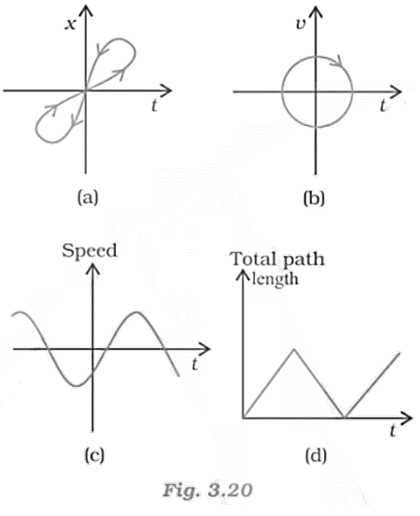
a. Consider the x-t graph, given in fig (a). It does not represent the one-dimensional motion of the particle. This is because a particle cannot have two positions at the same instant of time.
b. Consider the x-t graph, given in fig (b). It does not represent the one-dimensional motion of the particle. This is because a particle can never have two values of velocity at the same instant of time.
c. Consider the x-t graph, given in fig (c). It does not represent the one-dimensional motion of the particle. This is because speed being a scalar quantity cannot be negative.
d. Consider the x-t graph, given in fig (d). It does not represent the one-dimensional motion of the particle. This is because the total path length travelled by the particle cannot decrease with time.
13. Figure shows the x-t plot of the one-dimensional motion of a particle. Is it correct to say from the graph that the particle moves in a straight line for $t<0$ and on a parabolic path for $t>0$? If not, suggest a suitable physical context for this graph.
Ans: No, this is because the x-t graph does not represent the trajectory of the path followed by a particle. Also from the graph, it is clear that at \[t=0,\text{ }x=0\].
14. A police van moving on a highway with a speed of \[30\text{ }km/hr\] fires a bullet at a thief’s car speeding away in the same direction with a speed of \[192\text{ }km/hr\]. If the muzzle speed of the bullet is \[150\text{ }m/s\], with what speed does the bullet hit the thief’s car? (Note: Obtain that speed which is relevant for damaging the thief’s car).
Speed of the police van is \[{{v}_{p}}=30\text{ }km/hr=8.33m/s\].
Muzzle speed of the bullet is \[{{v}_{b}}=150\text{ }m/s\].
Speed of the thief’s car is \[{{v}_{t}}=192\text{ }km/hr=53.33m/s\].
As the bullet is fired from a moving van, its resultant speed will be: $150+8.33=158.33m/s$.
Since both the vehicles are moving in the same direction, the velocity with which the bullet hits the thief’s car can be obtained as:
${{v}_{bt}}={{v}_{b}}-{{v}_{t}}=158.33-53.33=105m/s$
15. Suggest a suitable physical situation for each of the following graphs (figure):

Ans: Consider fig 3.22 given in the question:
a. From the x-t graph given it is clear that initially a body was at rest. Further, its velocity increases with time and attains an instantaneous constant value. The velocity then reduces to zero with an increase in time. Further, its velocity increases with time in the opposite direction and acquires a constant value. A similar physical situation arises when a football (initially kept at rest) is kicked and gets rebound from a rigid wall so that its speed gets reduced. Then, it passes from the player who has kicked it and ultimately stops after sometime.
b. From the given v-t graph it is clear that the sign of velocity changes and its magnitude decreases with a passage of time. This type of situation arises when a ball is dropped on the hard floor from a height. It strikes the floor with some velocity and upon rebound, its velocity decreases by a factor. This continues till the velocity of the ball eventually becomes zero.
c. From the given a-t graph it is clear that initially the body is moving with a certain uniform velocity. Its acceleration increases for a short interval of time, which again drops to zero. This shows that the body again starts moving with the same constant velocity. This type of physical situation arises when a hammer moving with a uniform velocity strikes a nail.
16. Figure gives the x-t plot of a particle executing one-dimensional simple harmonic motion.
(You will learn about this motion in more detail in Chapter14). Give the signs of position, velocity and acceleration variables of the particle at $t=0.3s,1.2s,-1.2s$.

Ans: Negative, Negative, Positive
Positive, Positive, Negative
Negative, Positive, Positive
When a particle executes simple harmonic motion (SHM), acceleration (a) is given by the relation: $a=-{{\omega }^{2}}x$
$\omega $ is the angular frequency ...
i. \[~t\text{ }=\text{ }0.3\text{ }s\]
For this time interval, x is negative. Hence, the slope of the x-t plot will be negative. Thus, both position and velocity are negative. However, using equation (i), acceleration of the particle will be positive.
ii. \[~t\text{ }=1.2s\]
For this time interval, x is positive. Hence, the slope of the x-t plot will be positive. Thus, both position and velocity are positive. However, using equation (i), acceleration of the particle comes to be negative.
iii. \[\text{t }=-1.2s\]
For this time interval, x is negative. Hence, the slope of the x-t plot will be negative. Thus, both x and t are negative, the velocity comes to be positive. From equation (i), it can be interpreted that the acceleration of the particle will be positive.
17. Figure gives the x-t plot of a particle in one-dimensional motion. Three different equal intervals of time are shown. In which interval is the average speed greatest, and in which is it the least? Give the sign of average velocity for each interval.
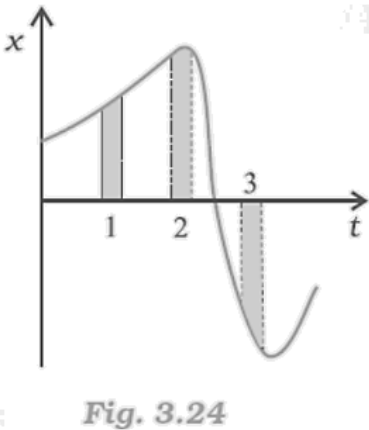
Ans: The average speed is greatest in interval 3 and least in interval 2. It is positive in intervals 1 & 2 and negative in interval 3.
The average speed of a particle shown in the x-t graph is given by the slope of the graph in a particular interval of time.
From the graph it is clear that the slope is maximum and minimum restively in intervals 3 and 2 respectively. Thus, the average speed of the particle is the greatest in interval 3 and is the least in interval 2. The sign of average velocity is positive in both intervals 1 and 2 as the slope is positive in these intervals. However, it is negative in interval 3 because the slope is negative in this interval.
18. Figure gives a speed-time graph of a particle in motion along a constant direction. Three equal intervals of time are shown. In which interval is the average acceleration greatest in magnitude? In which interval is the average speed greatest? Choosing the positive direction as the constant direction of motion, give the signs of v and a in the three intervals. What are the accelerations at the points A, B, C and D?
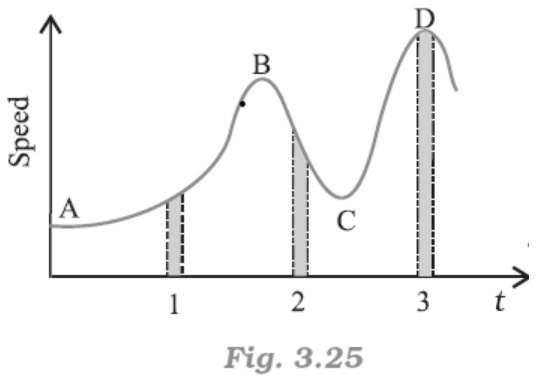
Ans: From the graph given in the question,
Average acceleration is greatest in interval \[2\].
Average speed is greatest in intervals of $3$.
v is positive for intervals \[1,\text{ }2\], and $3$.
a is positive for intervals $1$ and $3$ and negative in interval $2$
\[a\text{ }=\text{ }0\] at A, B, C, D
Acceleration is calculated as the slope of the speed-time graph. In the given case, it is given by the slope of the speed-time graph within the given interval of time.
As the slope of the given speed-time graph is maximum in interval \[2\], average acceleration will be the greatest in this interval.
From the time-axis, height of the curve gives the average speed of the particle. It is clear that the height is the greatest in interval 3. Thus, average speed of the particle is the greatest in the interval 3.
For interval 1:
The slope of the speed-time graph is positive. Hence, acceleration is positive. Similarly, the speed of the particle is positive in this interval.
In interval 2:
As slope of the speed-time graph is negative, acceleration is negative in this interval. However, speed is positive because it is a scalar quantity.
In interval 3:
As the slope of the speed-time graph is zero, acceleration is zero in this interval.
However, here the particle acquires some uniform speed. It is positive in this interval.
Points A, B, C, and D are all parallel to the time-axis. Thus, the slope is zero at these points.
Therefore, at points A, B, C, and D, acceleration of the particle is zero.
Motion in a Straight Line Chapter Summary - Class 11 NCERT Solutions
Path length is defined as the total length of the path traversed by an object.
Displacement is the change in position: $\Delta x=x_{2}-x_{1} $ Path length is greater or equal to the magnitude of the displacement between the same points.
An object is said to be in uniform motion in a straight line if its displacement is equal in equal intervals of time. Otherwise, the motion is said to be nonuniform
Average velocity is the displacement divided by the time Interval in which the displacement occurs: $ v\bar{}=\frac{\Delta x}{\Delta t}
On an x-t graph. The average velocity over a time Interval is the slope of the line connecting the initial and final positions corresponding to that interval.
Average Speed is the ratio of total path length traversed and the corresponding time Interval.
Instantaneous velocity or simply velocity is defined as the limit of the average velocity as the time interval $\Delta t$ becomes infinitesimally small $v=\lim_{\Delta t\rightarrow 0}v\bar{}=\lim_{\Delta t\rightarrow 0}\frac{\Delta x}{\Delta t}=\frac{dx}{dt}$
The velocity at a particular instant is equal to the slope of the tangent drawn on position-time graph at that instant.
Average acceleration is the change in velocity divided by the time interval during which the change occurs: $a\vec{}=\frac{\Delta v}{\Delta t}$
Instantaneous acceleration is defined as the limit of the average acceleration as the time interval at goes to zero: $a=\lim_{\Delta \rightarrow t}a\vec{}=\lim_{\Delta t\rightarrow 0}\frac{\Delta t}{\Delta v}=\frac{dv}{dt}$
The acceleration of an object at a particular time is the slope of the velocity-time graph at that instant of time. For uniform motion. acceleration is zero and the x-t graph is a straight line inclined to the time axis and the v-t graph is a straight line parallel to the time axis. For motion with uniform acceleration. x - t graph is a parabola while the v-t graph is a straight line inclined to the time axis.
The area under the velocity-time curve between times t 1 and t 2 is equal to the displacement of the object during that interval of time.
For objects in uniformly accelerated rectilinear motion. the five quantities, displacement x, time taken t. Initial velocity v 0, final velocity v and acceleration a are related by a set of simple equations called kinematic equations of motion: v=v 0 +at x=v 0 t+$\frac{1}{2}$at 2 v 2 =$v_{0}^{2}$+2ax
For Uniform Motion
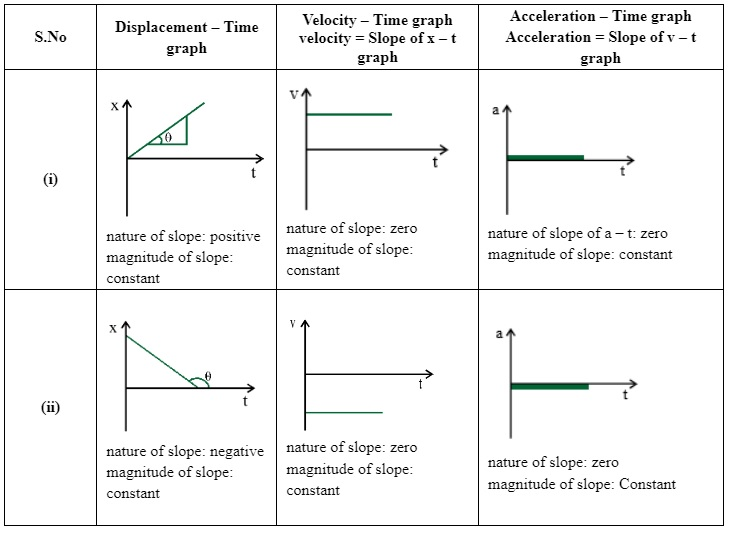
For Non-Uniform Motion
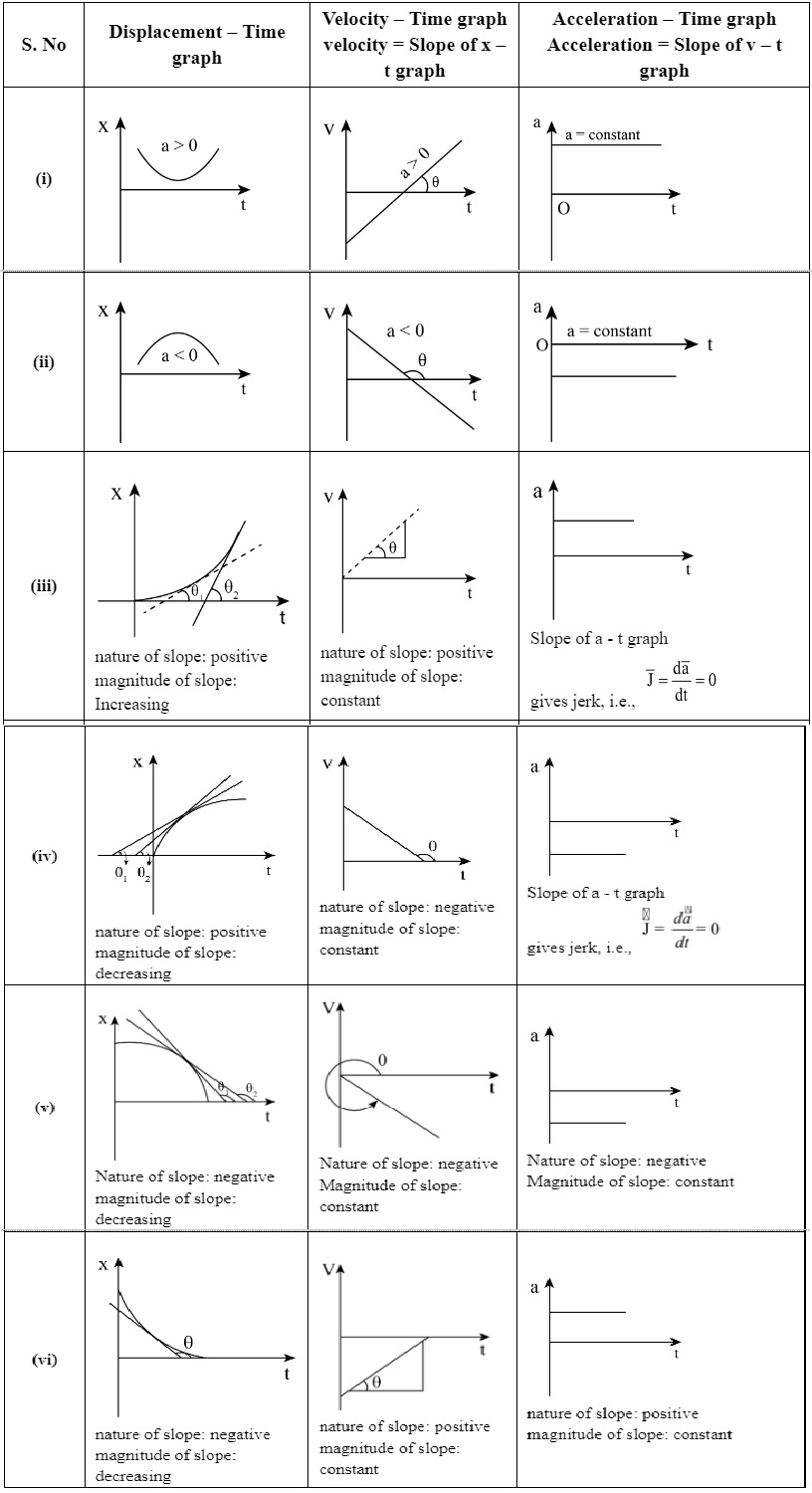
Overview of Deleted Syllabus for CBSE Class 11 Physics Motion in a Straight Line
Chapter | Dropped Topics |
Motion in a Straight Line | 3.2 Position, Path Length and Displacement |
3.3 Average Velocity and Average Speed | |
3.7 Relative Velocity | |
Exercises 3.5, 3.7–3.9 and 3.23–3.28 | |
Appendix 3.1 |
NCERT Class 11 Physics Chapter 2 Exercise Solutions on Motion In A Straight Line provided by Vedantu are comprehensive, and helps students understand motion and the different kinds of motion. This chapter explores different types of motion, including uniform motion, non-uniform motion, and uniformly accelerated motion. In Ch 2 physics class 11 ncert solutions we learn how to solve problems involving these concepts using various equations relating to distance, time, speed, velocity, and acceleration. These concepts are essential for mastering the topic and are often tested in exams. From previous year's question papers, typically around 2–3 questions are asked from this chapter. These questions test students' grasp of theoretical concepts as well as their problem-solving skills.
Other Study Material for CBSE Class 11 Physics Chapter 2
S.No. | Important Links for Chapter 2 Motion in a Straight Line |
1 |
|
2 |
|
3 |
|
Chapter-Specific NCERT Solutions for Class 11 Physics
Given below are the chapter-wise NCERT Solutions for Class 11 Physics. Go through these chapter-wise solutions to be thoroughly familiar with the concepts.
S.No. | NCERT Solutions Class 11 Chapter-Wise Physics PDF |
1 |
|
2 |
|
3 |
|
4 |
|
5 |
|
6 |
|
7 |
|
8 |
|
9 |
|
10 |
|
11 |
|
12 |
|
13 |
|

FAQs on NCERT Solutions for Class 11 Physics Chapter 2 Motion in a Straight Line
1. If I'm not a Non-Medical Student, do I Still Need to Learn and Take Physics as One of the Subjects?
The answer to this question is both yes and no, you can opt for Physics even if you are not a non-medical student, but the only other branch which offers Physics as one of its subjects is medical. In that branch, you don't have maths as the main subject, but you can opt for maths as well. On the other hand, if you are from commerce or arts, you don't choose Physics. You can't opt for Physics as it's one of the core subjects and isn't easy. In the medical stream, you can opt for Physics.
2. If an Object has One Dimension Motion with a Positive Acceleration Value and Negative Velocity, is the Object Speeding up?
No, in this case, the object present in the starting point is not speeding up. As the velocity is negative, we can see that the particle is slowing down. This type of scenario happens only when the object is thrown upwards in the air. We can say the object is in acceleration if both the acceleration and the object's velocity have a positive value, or the object is falling from a height.
3. What are the contents of Chapter 3 of the Class 11 Physics textbook?
The theme of the chapter is Kinematics, motion in a straight line. Mechanics is a scientific term that refers to the study of the movement of physical objects. The chapter explains all the relevant terms in a simple and easy-to-understand language. The chapter distinguishes between rest and motion. You will also come across the terms position, distance, and displacement as well as the difference between speed and velocity. The chapter explains acceleration. The chapter also contains the units and mathematical representations.
4. What is the difference between distance and displacement according to Chapter 3 of the Class 11 Physics textbook?
Distance means the actual path traversed by the object whereas displacement refers to the difference between initial and final positions. The former is the scalar quantity while the latter is the vector quantity. The distance covered by an object is always positive; it can never be negative or zero. However, the displacement of an object can be either positive, negative, or even zero. The distance is dependent on the path traversed by the object but displacement is not dependent on the path.
5. What is the difference between speed and velocity Chapter 3 of the Class 11 Physics textbook?
Speed is the total path length covered by the object divided by the total time taken. Velocity is the change in position divided by time intervals. Speed is a scalar quantity. Velocity, however, is a vector quantity. Speed is always positive. Velocity, on the other hand, can be positive, negative, or zero. Speed is the time rate at which an object moves; speed is about how fast an object moves. Velocity is the rate and direction of the movement of an object.
6. What are the types of motion mentioned in Chapter 3 of the Class 11 Physics textbook?
The motion refers to changes in the position or orientation of an object with the change in time. Motion can be of two types- Uniform motion or Non-Uniform motion. Uniform motion exists when the object completes equal distance in equal time intervals. Non-Uniform motion, on the other hand, exists when an object completes unequal distance in equal intervals of time. During a uniform motion, the velocity of the object remains the same. When an object undergoes non-uniform motion, the magnitude of the velocity increases or decreases with time.
7. How can previous years’ questions help in preparation of Motion in a straight line chapter of Class 11 Physics?
Previous years’ questions enable you to understand the pattern of the question and analyse the trend of the questions asked. These papers will give you an idea regarding the topics that you should invest more time and effort on. These question papers should also motivate you to make notes accordingly. The previous years’ question papers will lend a direction to your preparation and you will feel more prepared and confident on the day of the exam. These papers are available on the official website of Vedantu or the Vedantu app. All the resources are free of cost.
8. In Motion In A Straight Line Class 11 NCERT Solutions, which motion travels in a straight line?
In Class 11 Physics Chapter 2, Motion In A Straight Line refers to the movement of an object along a straight path. This type of motion is characterized by having only one spatial dimension. Examples include a car driving on a straight road, a ball rolling down a straight hill, or an object falling freely under gravity (neglecting air resistance).
9. What are the two motions of a straight line mentioned in Physics Class 11 Chapter 2?
The two types of motion in a straight line are:
Uniform Motion : When an object moves with a constant speed in a straight line, covering equal distances in equal intervals of time.
Non-uniform Motion : When an object's speed varies as it moves along a straight line, covering unequal distances in equal intervals of time.
10. What are the important things in Motion In A Straight Line Class 11 Questions?
Important aspects of motion in a straight line include:
Displacement : The change in position of an object, considering direction.
Velocity : The rate of change of displacement with time.
Speed : The rate at which an object covers distance.
Acceleration : The rate of change of velocity with time.
Kinematic Equations : These equations relate displacement, velocity, acceleration, and time.
11. In Class 11 Motion In A Straight Line NCERT Solutions, Is motion always in a straight line?
No, motion is not always in a straight line. While this chapter focuses on straight-line motion, objects can move in various types of paths, such as circular motion, projectile motion, or any arbitrary path in two or three dimensions.
12. What is another name for a straight line motion in Motion In Straight Line Class 11 NCERT Solutions?
Another name for straight-line motion is rectilinear motion. This term is often used in physics to describe motion that occurs along a straight path.
13. What is the other name of motion in a straight line in Class 11 Physics Chapter 2 Exercise Solutions?
The other name for motion in a straight line is linear motion. This term highlights the one-dimensional aspect of the motion, indicating that it occurs along a single straight axis.
NCERT Solutions for Class 11 Physics

Gurukul of Excellence
Classes for Physics, Chemistry and Mathematics by IITians
Join our Telegram Channel for Free PDF Download
MCQ Questions for Class 11 Physics Chapter 2 Units and Measurements
- Last modified on: 2 years ago
- Reading Time: 8 Minutes
Q.1. The density of a material in SI units is 128 kg m-3 . In certain units in which the unit of length is 25 cm and the unit of mass is 50 g, the numerical value of density of the material is (a) 40 (b) 16 (c) 640 (d) 410
Q.2. The quantity having the same unit in all system of unit is (a) mass (b) time (c) length (d) temperature
Q.3. The damping force on an oscillator is directly proportional to the velocity. The unit of the constant of proportionality is (a) kg-ms -1 (b) kg-ms -2 (c) kgs -1 (d) kg-s
Q.4. If the value of work done is 10 10 g-cm 2 s -2 , then its value in SI units will be (a) 10 kg-m 2 s -2 (b) 10 2 kg-m 2 s -2 (c) 10 4 kg-m 2 s -2 (d) 10 3 kg-m 2 s -2
Q.5. The SI unit of thermal conductivity is (a) J m -1 K -1 (b) W-m K -1 (c) Wm -1 K -1 (d) Jm K -1
Q.6. Amongst the following options, which is a unit of time? (a) Light year (b) Parsec (c) Year (d) None of these
Q.7. The ratio of the volume of the atom to the volume of the nucleus is of the order of (a) 10 15 (b) 10 25 (c) 10 20 (d) 10 10
Q.8. Which of the following measurement is most precise? (a) 5.00 mm (b) 5.00 cm (c) 5.00 m (d) 5.00 km
Q.9. A student measured the length of a rod and wrote it as 3.50 cm. Which instrument did he use to measure it? (a) Ameter scale (b) A vernier calliper where the 10 divisions in vernier scale matches with 9 divisions in main scale and main scale has 10 divisions in 1 cm (c) A screw gauge having 100 divisions in the circular scale and pitch as 1 mm (d) A screw gauge having 50 divisions in the circular scale and pitch as 1 mm
Q.10. The moon is observed from two diametrically opposite points A and B on earth. The angle θ subtended at the moon by the two directions of observation is 1°54′; given that the diameter of the earth to be about 1.276×10 7 m. Compute the distance of the moon from the earth. (a) 4.5x 10 9 m (b) 3.83 x10 8 m (c) 2.5 x 10 4 m (d) 4 x10 7 m
Q.11. A student measures the time period of 100 oscillations of a simple pendulum four times. The data set is 90s, 91s, 92s and 95s. If the minimum division in the measuring clock is 1s, then the reported mean time should be (a) (92 ± 2)s (b) (92 ± 5)s (c) (92 ± 1.8)s (d) (92 ± 3)s
Q.12. The length, breadth and height of a rectangular block of wood were measured to be l = 12.13 ± 0.02 cm, b = 8.16 ± 0.01cm and h = 3.46 ± 0.01cm. (a) 0.88% (b) 0.58% (c) 0.78% (d) 0.68%
Q.13. The respective number of significant figures for the numbers 23.023, 0.0003 and 2.1×10 -3 are (a) 5, 1, 2 (b) 5, 1, 5 (c) 5, 5, 2 (d) 4, 4, 2
Q.14. The numbers 5.355 and 5.345 on rounding off to 3 significant figures will give (a) 5.35 and5.34 (b) 5.36 and5.35 (c) 5.35 and5.35 (d) 5.36 and5.34
Q.15. Which two of the following five physical parameters have the same dimensions? I. Energy density II. Refractive index III. Dielectric constant IV. Young’s modulus V. Magnetic field (a) I and IV (b) III and V (c) I and II (d) I and V
Download CBSE Books
Exam Special Series:
- Sample Question Paper for CBSE Class 10 Science (for 2024)
- Sample Question Paper for CBSE Class 10 Maths (for 2024)
- CBSE Most Repeated Questions for Class 10 Science Board Exams
- CBSE Important Diagram Based Questions Class 10 Physics Board Exams
- CBSE Important Numericals Class 10 Physics Board Exams
- CBSE Practical Based Questions for Class 10 Science Board Exams
- CBSE Important “Differentiate Between” Based Questions Class 10 Social Science
- Sample Question Papers for CBSE Class 12 Physics (for 2024)
- Sample Question Papers for CBSE Class 12 Chemistry (for 2024)
- Sample Question Papers for CBSE Class 12 Maths (for 2024)
- Sample Question Papers for CBSE Class 12 Biology (for 2024)
- CBSE Important Diagrams & Graphs Asked in Board Exams Class 12 Physics
- Master Organic Conversions CBSE Class 12 Chemistry Board Exams
- CBSE Important Numericals Class 12 Physics Board Exams
- CBSE Important Definitions Class 12 Physics Board Exams
- CBSE Important Laws & Principles Class 12 Physics Board Exams
- 10 Years CBSE Class 12 Chemistry Previous Year-Wise Solved Papers (2023-2024)
- 10 Years CBSE Class 12 Physics Previous Year-Wise Solved Papers (2023-2024)
- 10 Years CBSE Class 12 Maths Previous Year-Wise Solved Papers (2023-2024)
- 10 Years CBSE Class 12 Biology Previous Year-Wise Solved Papers (2023-2024)
- ICSE Important Numericals Class 10 Physics BOARD Exams (215 Numericals)
- ICSE Important Figure Based Questions Class 10 Physics BOARD Exams (230 Questions)
- ICSE Mole Concept and Stoichiometry Numericals Class 10 Chemistry (65 Numericals)
- ICSE Reasoning Based Questions Class 10 Chemistry BOARD Exams (150 Qs)
- ICSE Important Functions and Locations Based Questions Class 10 Biology
- ICSE Reasoning Based Questions Class 10 Biology BOARD Exams (100 Qs)
✨ Join our Online NEET Test Series for 499/- Only for 1 Year
Leave a Reply Cancel reply

Editable Study Materials for Your Institute - CBSE, ICSE, State Boards (Maharashtra & Karnataka), JEE, NEET, FOUNDATION, OLYMPIADS, PPTs
Discover more from Gurukul of Excellence
Subscribe now to keep reading and get access to the full archive.
Type your email…
Continue reading

IMAGES
VIDEO
COMMENTS
Students can solve Class 11 Physics Case Study Questions Units and Measurements to know their preparation level. Download Books for Boards Join our Telegram Channel, there you will get various e-books for CBSE 2024 Boards exams for Class 9th, 10th, 11th, and 12th.
CBSE Case Study Questions Class 11 Physics Units and Measurement. 1.) In general, the errors in measurement can be broadly classified as (a) systematic errors and (b) random errors. Systematic errors: The systematic errors are those errors that tend to be in one direction, either positive or negative. Some of the sources of systematic errors ...
Chapter-wise Solved Case Study Questions for Class 11 Physics. Chapter 1: Physical World. Chapter 2: Units and Measurements. Chapter 3: Motion in a Straight Line. Chapter 4: Motion in a Plane. Chapter 5: Laws of Motion. Chapter 6: Work, Energy, and Power. Chapter 7: System of Particles and Rotational Motion.
Case Study Questions. Question 1: All engineering phenomena deal with definite and measured quantities and so depend on the making of the measurement. We must be clear and precise in making these measurements. To make a measurement, magnitude of the physical quantity (unknown) is compared. The record of a measurement consists of three parts, i ...
QB365 provides a detailed and simple solution for every Possible Case Study Questions in Class 11 Physics Subject - Units and Measurements, CBSE. It will help Students to get more practice questions, Students can Practice these question papers in addition to score best marks.
Case Study Questions for Class 11 Physics. Chapter 1: Physical World. Chapter 2: Units and Measurements. Chapter 3: Motion in a Straight Line. Chapter 4: Motion in a Plane. Chapter 5: Laws of Motion. Chapter 6: Work, Energy, and Power. Chapter 7: System of Particles and Rotational Motion. Chapter 8: Gravitation.
Case Study Question Class 11 Physics (CBSE / NCERT Board) CBSE Class 11 Physics Case Study Question. There are total 15 chapter Physical World, Units and Measurement, Motion in a Straight Line, Motion in a Plane, Laws of Motion, Work, Energy and Power, Systems of Particles and Rotational Motion, Gravitation, Mechanical Properties of Solids ...
Class 11 Physics Case Study Questions are available here. You can read these Case Study questions by chapter for your final physics exam. Subject matter specialists and seasoned teachers created these quizzes. You can verify the right response to each question by referring to the answer key, which is also provided.
Class 11 Physics Case Study Question 1. Read the case study given below and answer any four subparts: Potential energy is the energy stored within an object, due to the object's position, arrangement or state. Potential energy is one of the two main forms of energy, along with kinetic energy. Potential energy depends on the force acting on ...
Units and Measurement Class 11 Notes Physics Chapter 2. The process of measurement is basically a comparison process. To measure a physical quantity, we have to find out how many times a standard amount of that physical quantity is present in the quantity being measured. The number thus obtained is known as the magnitude and the standard chosen ...
5. If the unit of length and force be increased four times, then the unit of energy is. 7. The binding energy of a nucleon in a nucleus is of the order of a few. (a) Rotation of the earth on its axis (b) Earth's orbital motion around the earth. (c) Vibrations of cesium atom (d) Oscillations of quartz crystal.
Access the answers of NCERT Class 11 Physics Chapter 2 Units and Measurements. 2.1 Fill in the blanks. (a) The volume of a cube of side 1 cm is equal to …..m3. (b) The surface area of a solid cylinder of radius 2.0 cm and height 10.0 cm is equal to… (mm)2. (c) A vehicle moving with a speed of 18 km h-1 covers….m in 1 s.
NCERT Exemplar Class 11 Physics Chapter 1 Units and Measurements. Single Correct Answer Type. Q1. The number of significant figures in 0.06900 is. (a) 5 (b) 4 (c) 2 (d) 3. Sol: (b) Key concept: Significant figures in the measured value of a physical quantity tell the number of digits in which we have confidence.
Here we have given NCERT Solutions for Class 11 Physics Chapter 2 Units and Measurements. NCERT Solutions. NCERT Library; RD Sharma. ... Question 2. 21. Precise measurements of physical quantities are a need of science. For example, to ascertain the speed of an aircraft, one must have an accurate method to find its positions at closely ...
September 25, 2022 July 29, 2023 Physics Gurukul Leave a Comment on Case Study Questions for Class 11 Physics Chapter 7 System of Particles and Rotational Motion. ... Case Study Questions for Class 11 Physics Chapter 2 Units and Measurements. NCERT Books & Solutions. NCERT Books 2023-24. NCERT Solutions. NCERT Notes. NCERT Exemplar Books. NCERT ...
Answer: (a) All measurements are made with reference to a point or portion i.e., a frame of reference. (b) The number of time units contained in a physical quantity gets changed with a change in the reference frame. (c) The same physical quantity may have different values in different reference frames. Question 24.
NCERT Solutions for Class 11 Physics Chapter 2 Units and Measurement 2.1 Fill in the blanks (a) The volume of a cube of side 1 cm is equal to …..m3 (b) The surface area of a solid cylinder of radius 2.0 cm and height 10.0 cm is equal to…(mm)2 (c) A vehicle moving with a speed of 18 km h-1 covers….m in 1 s (d) The relative density of lead is 11.3.
Check the multiple-choice questions for the 11th Class Physics Chapter 2 Units and Measurements. Select one answer out of 4 options. The density of a material in SI units is 128 kg m-3 . In certain units in which the unit of length is 25 cm and the unit of mass is 50 g, the numerical value of density of the material is. The damping force on an ...
It is inter convertible to different units of same quantity. A measurement consists of two parts, one is numeric and the other is standard chosen. For example, 5 meter of length implies 5 times the "standard meter". It is not necessary to establish a measurement standard for every physical quantity. Some quantities can be regarded as ...
Solution: These type of question can be simply solved by putting the respective conversion units in the place. (a) 1kgm2s − 2 = 1 × 103g(102cm)2s − 2 = 107gcm2s − 2. (b) Now we know that distance traveled by light in 1 year is called 1 light year. Speed of light = 3 × 108 m/s and 1 year = 365 × 24 × 60 × 60 s.
Ans. Q. The farthest objects in our universe are known as quasars (quasi-stellar radio sources). Much is not known about these objects. Electromagnetic wave emitted by quasars take billions of years to reach earth. Calculate distance of a quasar from which electromagnetic wave take three billion years to reach earth.
Chapter 2 - Units and Measurement in Class 11 Physics is a part of Unit - I along with Chapter 1 - Physical World. According to the marks distribution provided by CBSE for Class 11 Physics, Unit - I consisting of both the chapters, carries a total of 23 marks.
Also, you can read the SCERT book online in these sections NCERT Class 11 Physics Chapter 1 Units of Measurement Solutions by Expert Teachers as per SCERT Book guidelines.These solutions are part of SCERT All Subject Solutions.Here we have given NCERT Class 11 Physics Chapter 1 Units of Measurement Solutions for All Subjects, You can practice these here.
Q.4. Comment on the statement: "To define a physical quantity for which no method of measurement is given or known has no meaning.". Solution. The given statement is not correct. A physical quantity, if it is called so, must have a physical meaning. If it cannot be measured by any direct method, these must be some indirect method for its ...
Note: Unlock your dream college possibilities with our NEET College Predictor! Glance on Physics Chapter 2 Class 11 - Motion in a Straight Line. An object is said to be in motion if its position changes with time. The position of the object can be specified with reference to a conveniently chosen origin.
Q.1. The density of a material in SI units is 128 kg m-3 . In certain units in which the unit of length is 25 cm and the unit of mass is 50 g, the numerical value of density of the material is. Answer: (a) Q.2. The quantity having the same unit in all system of unit is. Answer: (b) Q.3.